Would you like to be notified of email failures on your WordPress site? With WP Mail SMTP, you can receive various alerts for emails that fail to send from your site.
This tutorial will show you how to set up email alerts on your site with WP Mail SMTP.
Before getting started, you’ll first need to make sure WP Mail SMTP is installed and activated on your WordPress site and that you’ve verified your license.
What Are Email Alerts?
WP Mail SMTP email alerts inform you of email failures on your WordPress site through multiple different services. For example, if your website is unable to send emails, you’ll automatically receive text messages for every failure.
Alerts help catch any misconfigurations in your WP Mail SMTP settings.
Note: If you’re encountering failing emails, check out our troubleshooting guide for WP Mail SMTP.
Setting Up Alerts
To begin setting up email alerts from the WordPress dashboard, go to WP Mail SMTP » Settings and click on the Alerts tab.
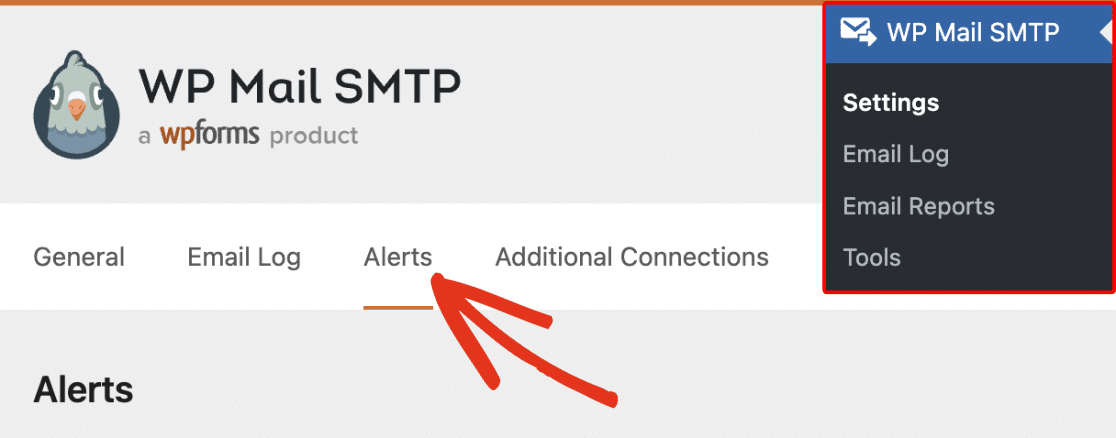
This will take you to the Alerts page, where you can select any of these 4 different service integrations to deliver your email alerts:
You’ll need to set up integration with at least one of these services to enable email alerts on your site. In the following sections, we’ll guide you through setting up each service.
Note: We recommend enabling Email Logging on your site to get further information about the errors referenced in each alert.
With the Email option, email alerts are delivered to up to 3 email addresses. These alerts are sent via a secure API and do not rely on your site’s email configuration.
As a result, you’ll still get alerts even if your site cannot send emails.
Unlike the other service integrations, Email notifications will only be sent once every 30 minutes. As a result, if you have multiple failed emails within this period, you’ll only be notified of the first one.
Note: To view all failed emails, you need to enable Email Logging in WP Mail SMTP.
Setting Up Email Integration
To enable email alerts, ensure the Email Alerts option is toggled to the on position.

Type the intended recipient address into the Send To field to set an address.

If you’d like to add another address, click the Add Another Email Address button.

Next, enter the additional email into the second Send To field.
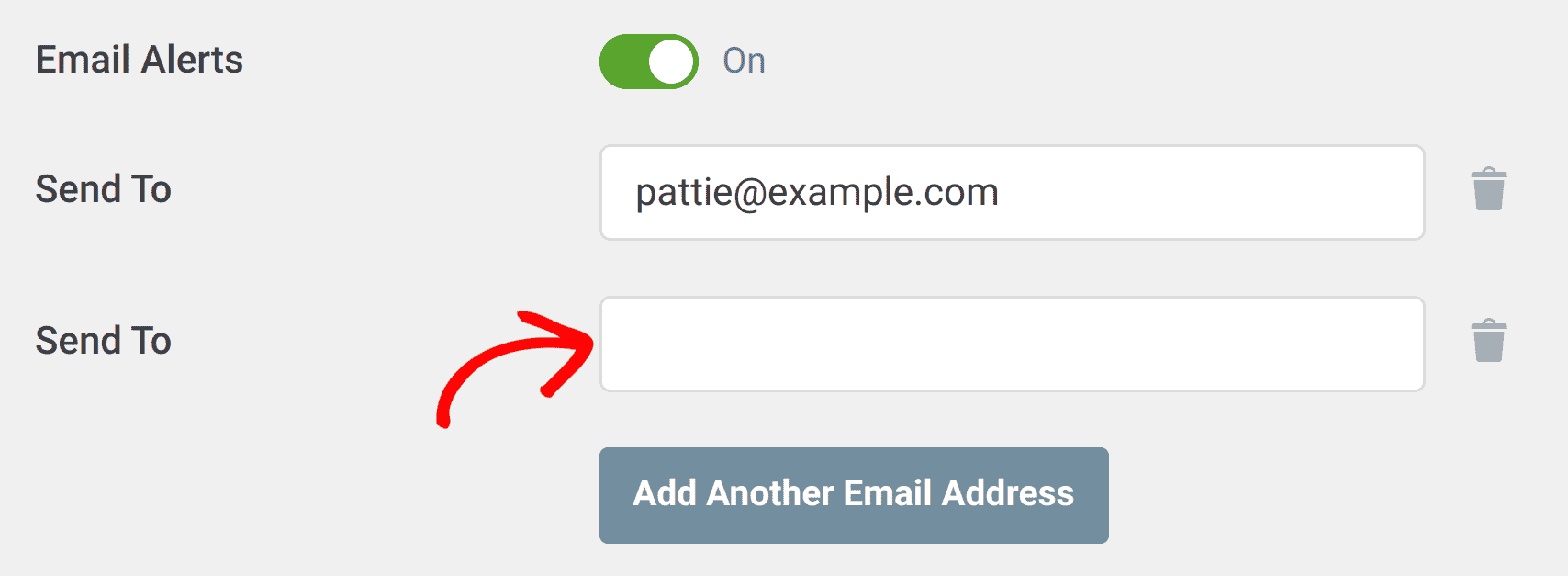
When you’re finished setting up email integration, you can either save your settings right away or continue to add other integrations.
Slack
With Slack integration, alerts are sent to your Slack workspaces or to individual members of your team. Unlike the Email integration, you can have as many Slack configurations as you need. Slack integration utilizes a webhook to facilitate communication.
Setting Up Slack Integration
To use Slack integration, you’ll need to create a Slack app and add its webhook URL to your site. Before doing this, set the Slack Alerts option to the on position.
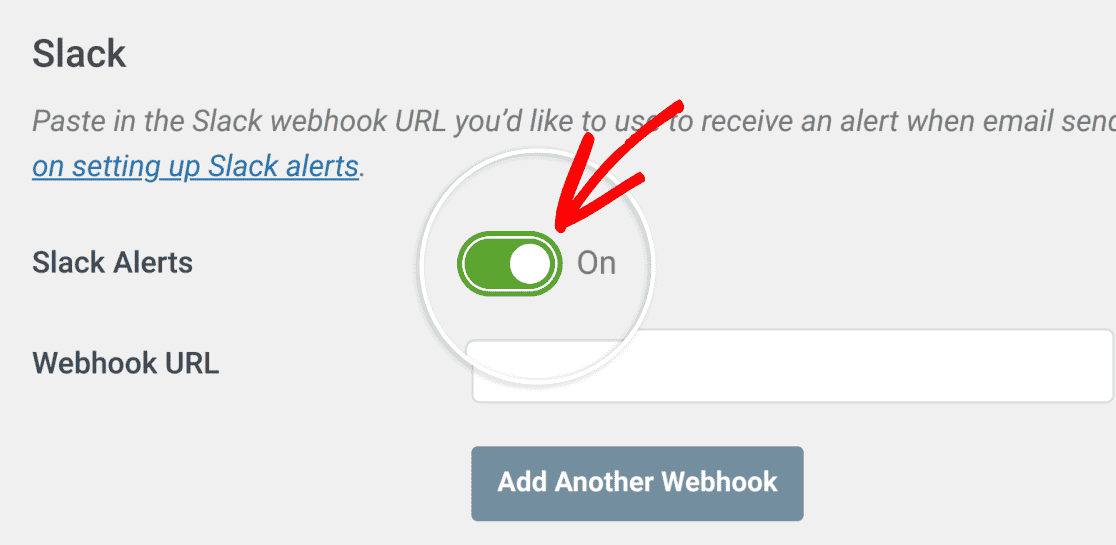
Next, open the Slack API page and create a new app. In the Create an app dialog, choose From scratch to start building your app.
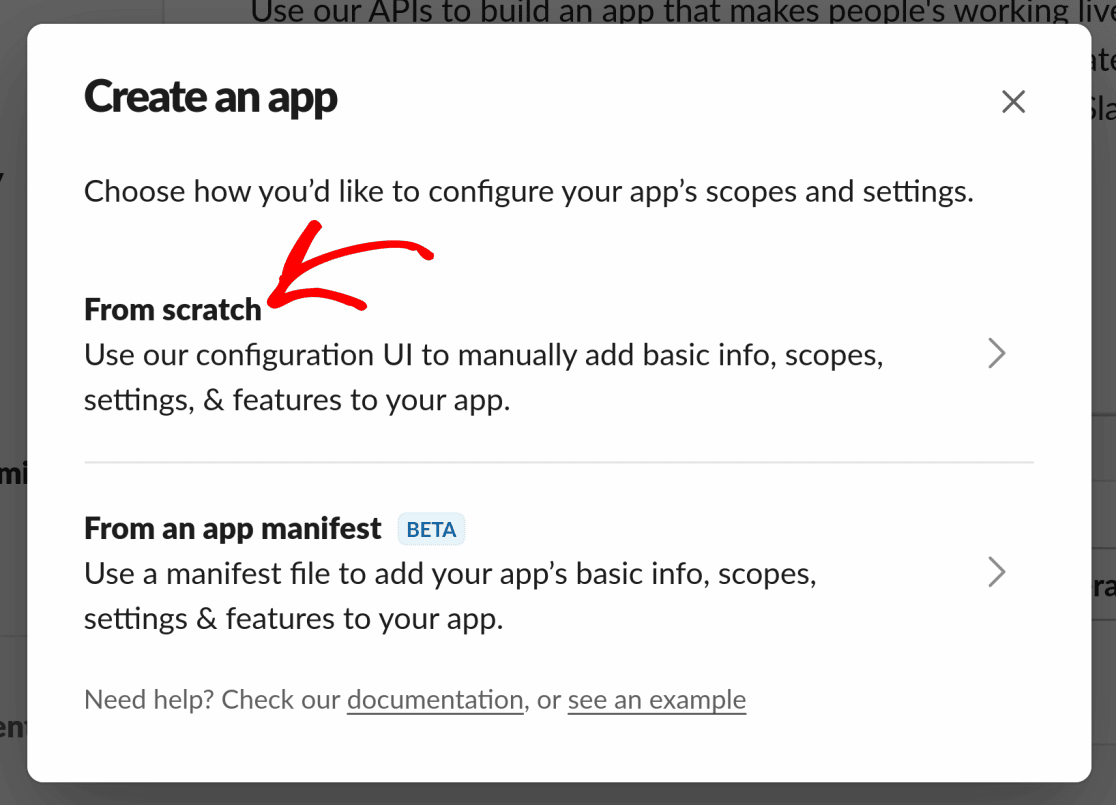
Now you’ll be able to choose an App Name for your Slack app.
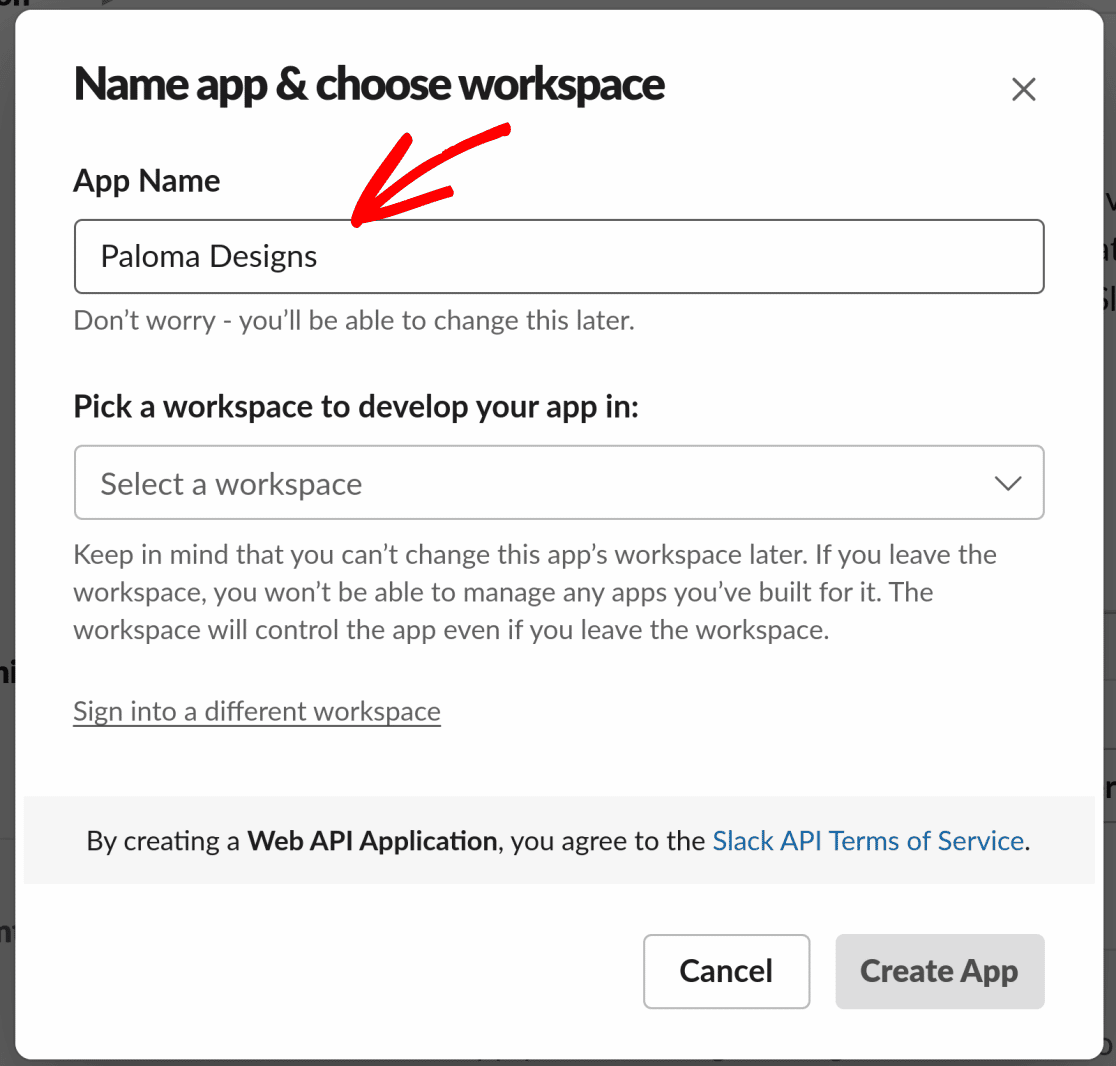
You’ll also need to choose a workspace for your app from the workspace dropdown list.
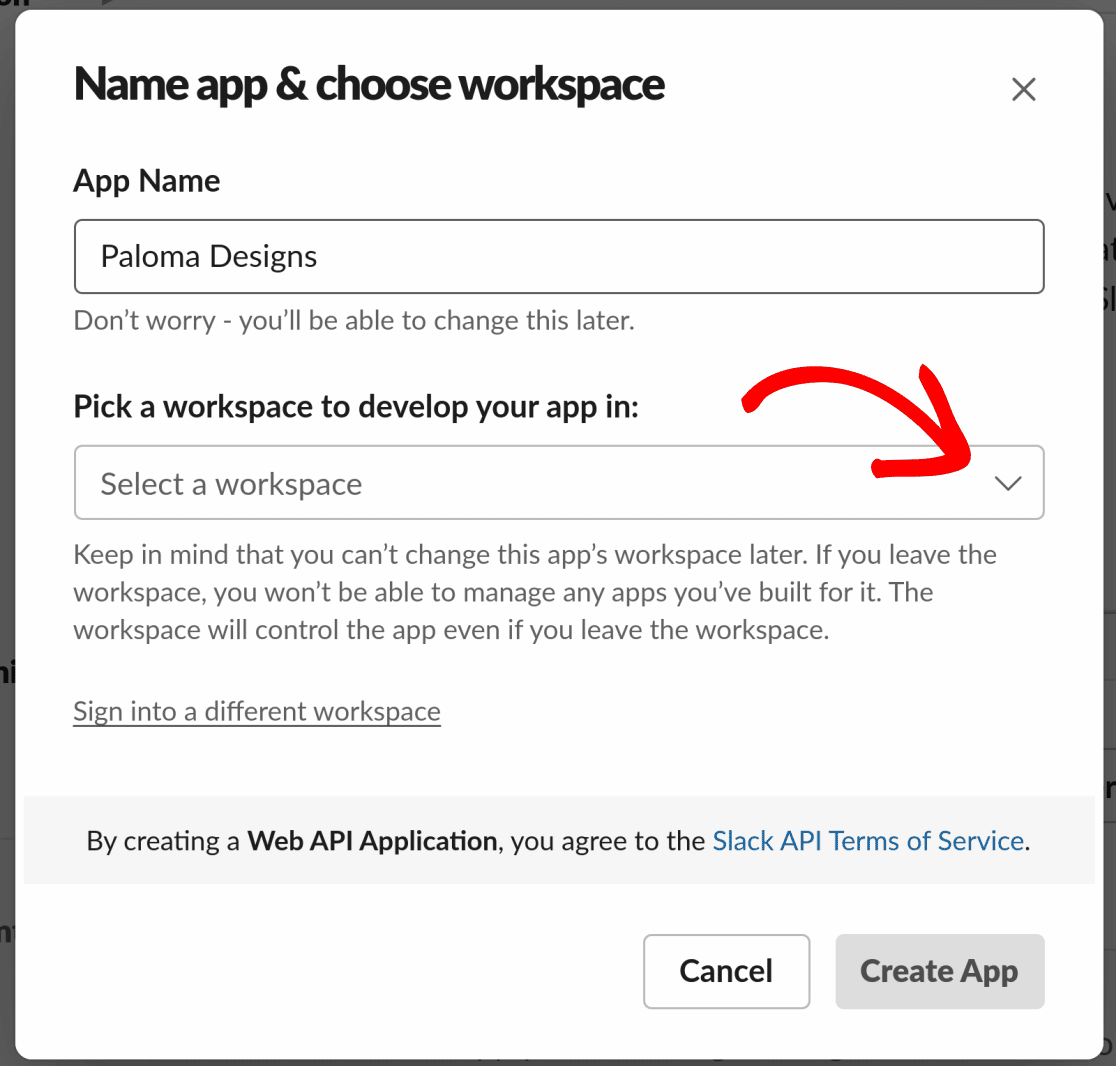
Note: Be sure to choose the correct workspace because this setting can’t be changed after your app has been created. If you’ve chosen the wrong workspace, you’ll need to create your app again.
Once you’ve chosen your workspace, click the Create App button to generate your new Slack app.
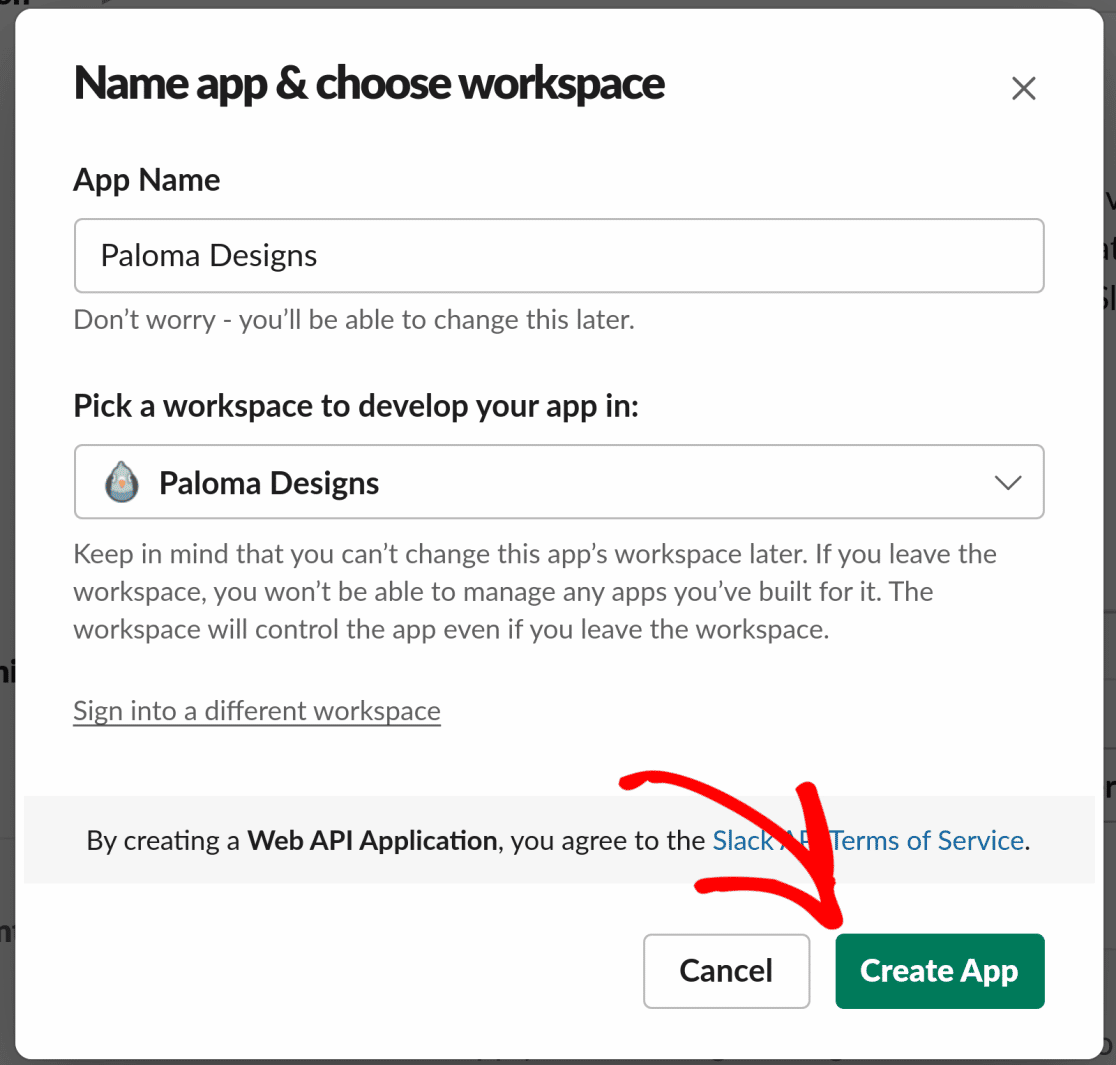
Once your Slack app is created, you can add both short and long descriptions, an app image, and a background color for the app under Display Information.
We’ve included an example of what a finished description would look like below:
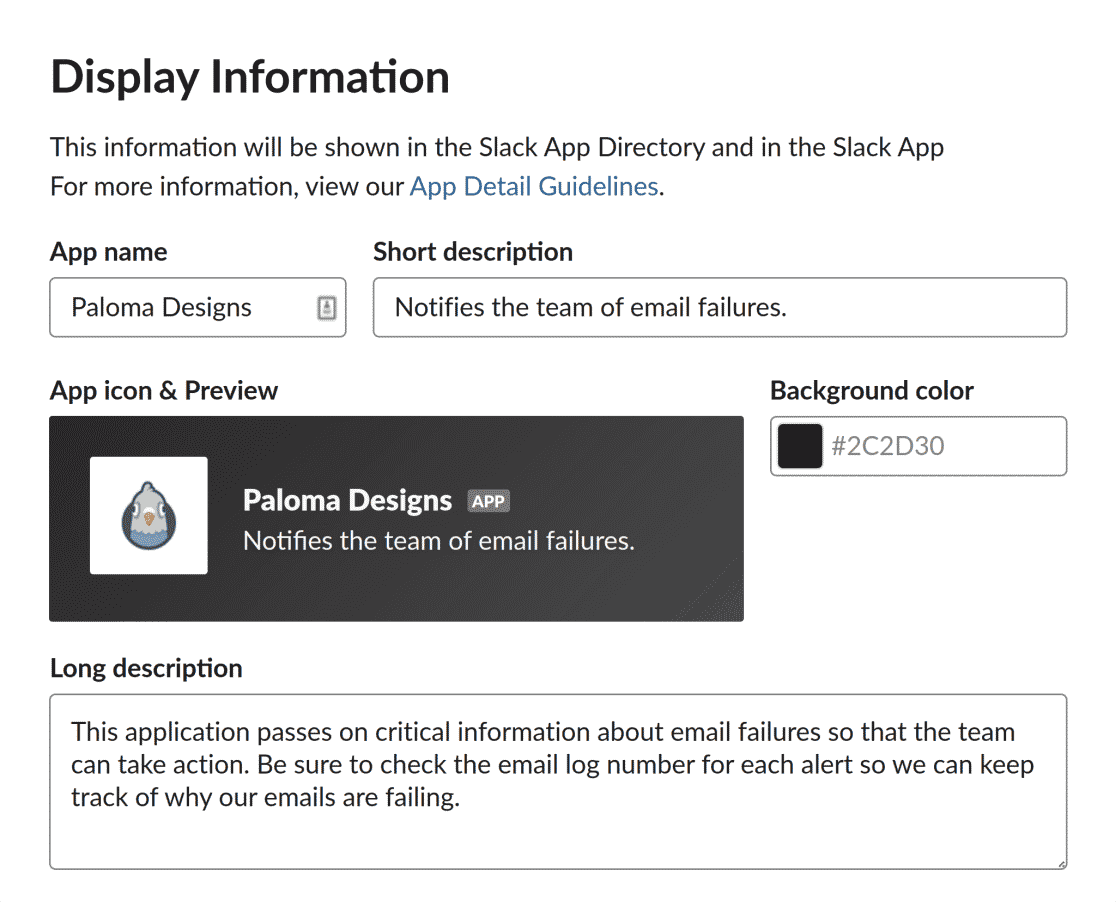
When you’re finished setting up your app as you like, click the Save Changes button at the bottom right of the screen to save your settings.
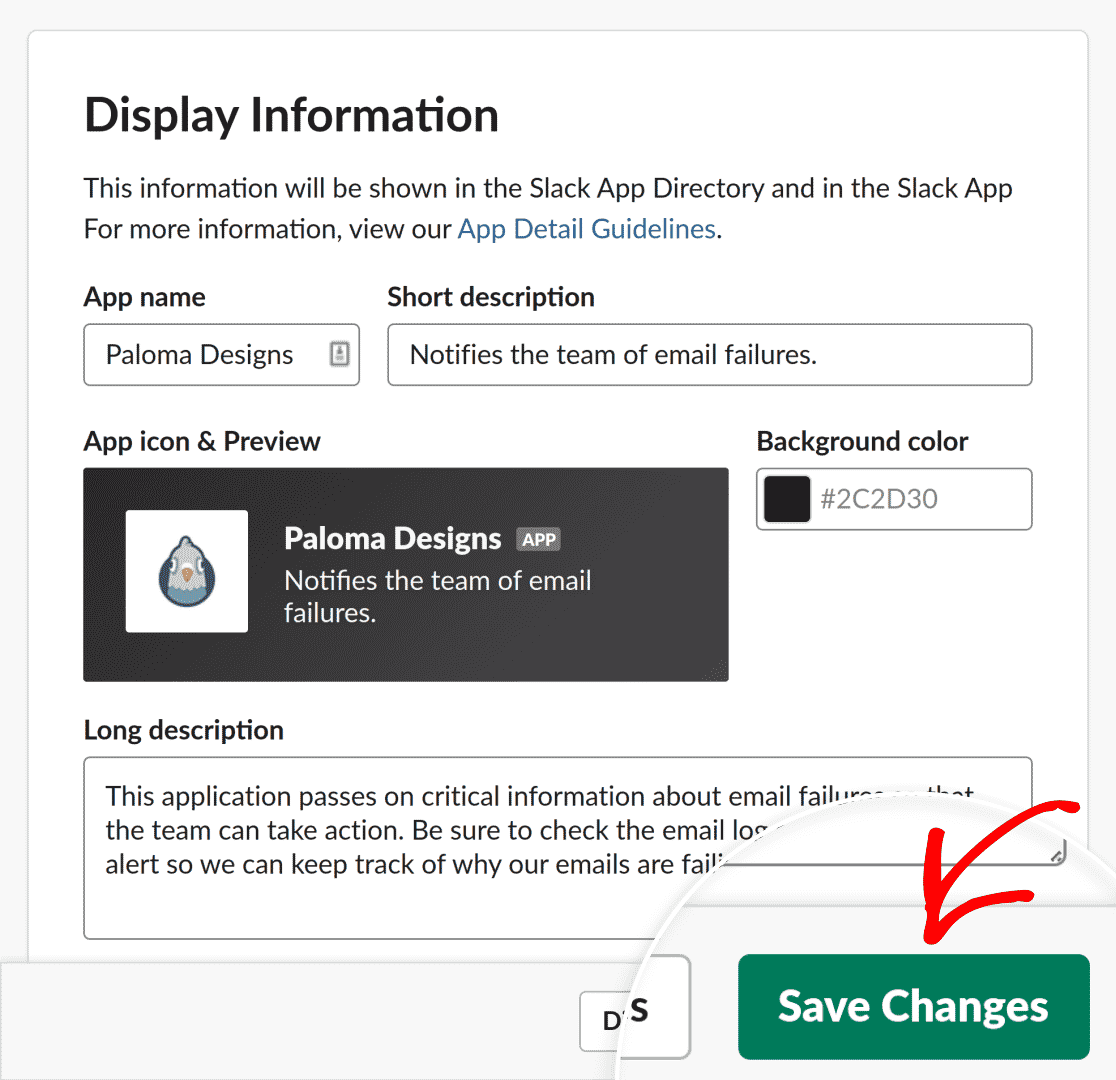
The next step is to enable and copy the webhook needed to connect your Slack app to WP Mail SMTP on your site.
To do this, click on Features » Incoming Webhooks in the sidebar of the Slack API page.
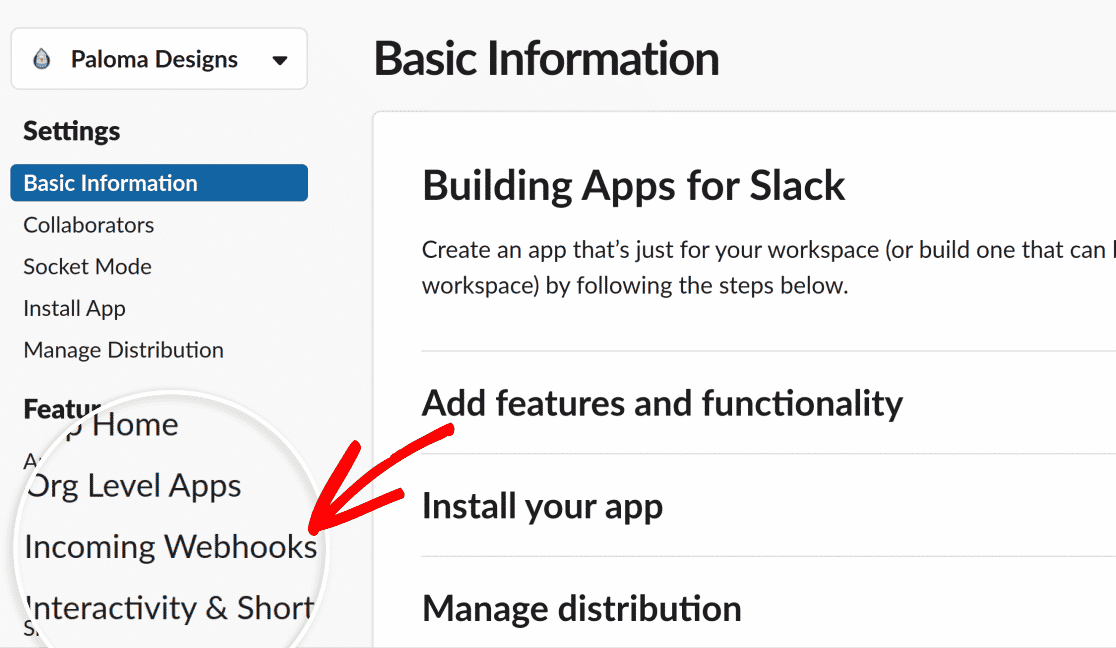
The Incoming Webhooks page allows you to manage all incoming webhooks for your app.
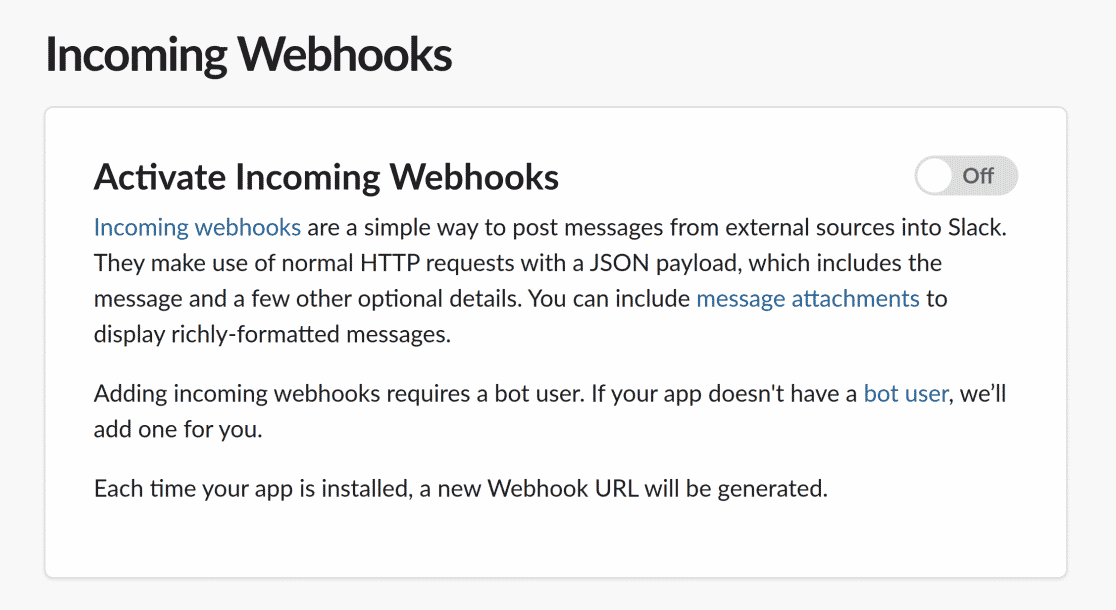
To get started, set the Activate Incoming Webhooks toggle to On.

Next, under Webhook URLs for Your Workspace, click on the Add New Webhook to Workspace button to generate the webhook URL for your app.
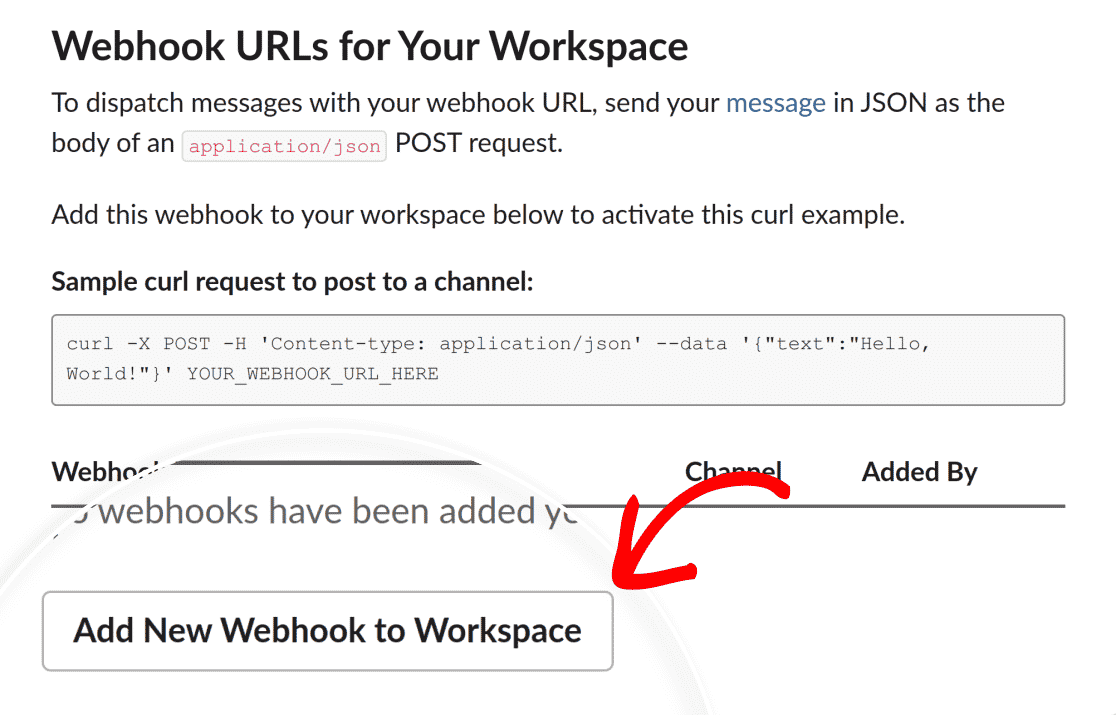
Since your Slack app will send notifications to a channel or individual, you’ll need to choose the intended recipient from the list of available channels and persons. To do this, click on the dropdown list and choose a channel or individual.
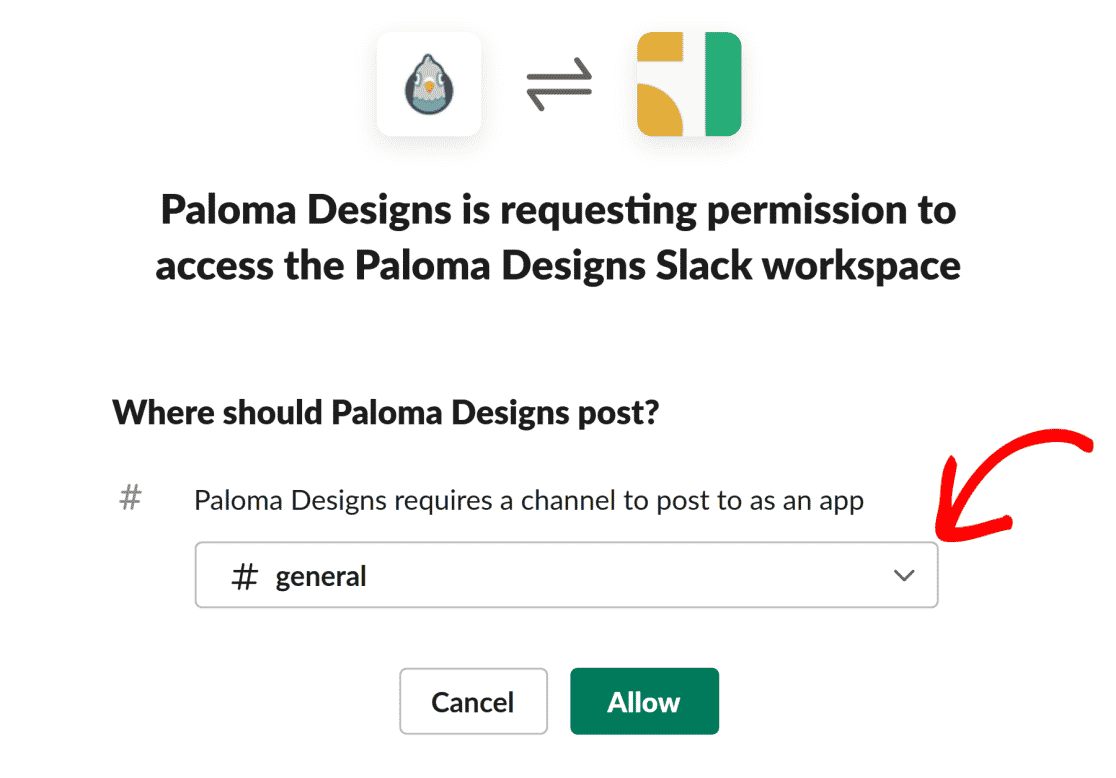
Now grant permission to your app by clicking the Allow button.
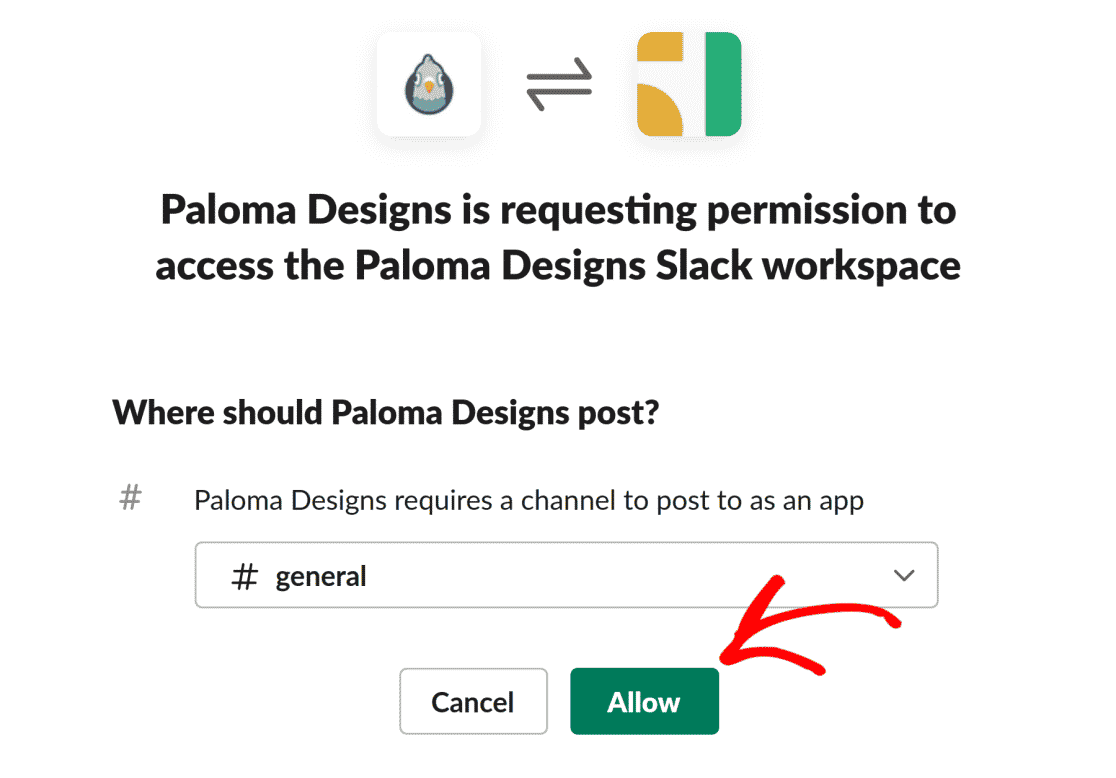
After the operation completes, you’ll be redirected to the Incoming Webhooks page, where you’ll have a new Webhook URL for your app. Copy the Webhook URL from Slack by clicking the Copy button.
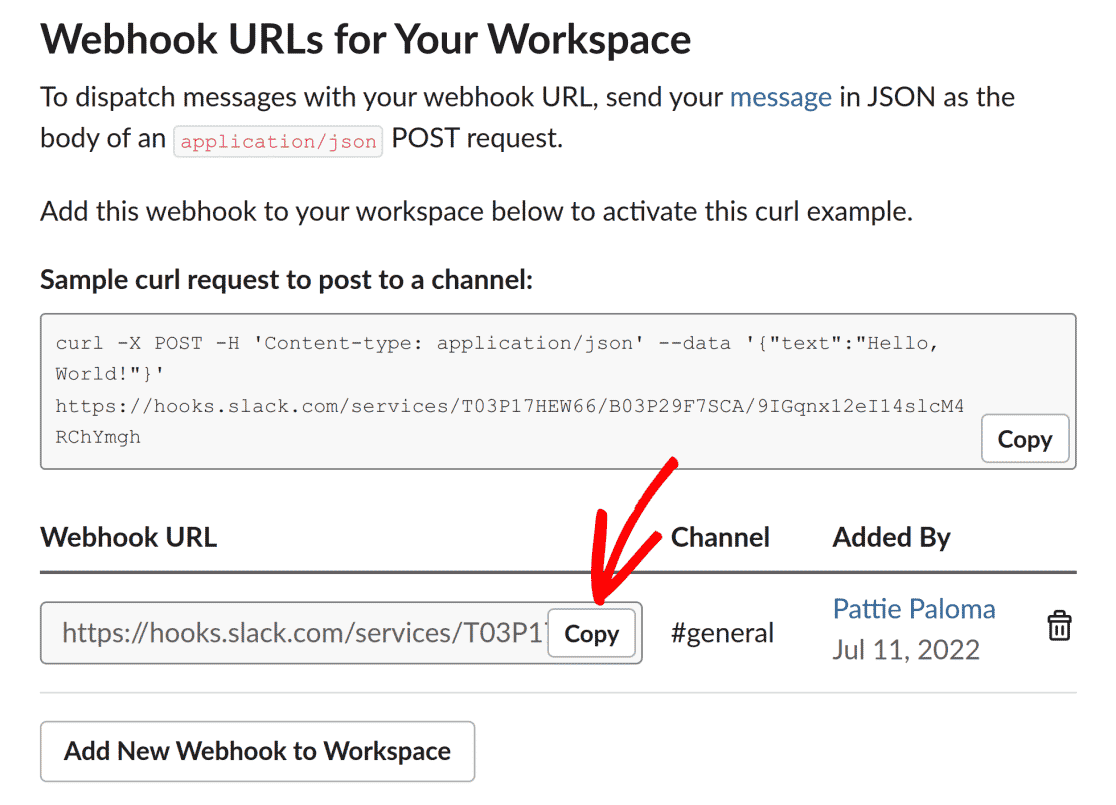
Finally, paste the webhook URL you copied from Slack into the Webhook URL field in your WP Mail SMTP Alert settings.
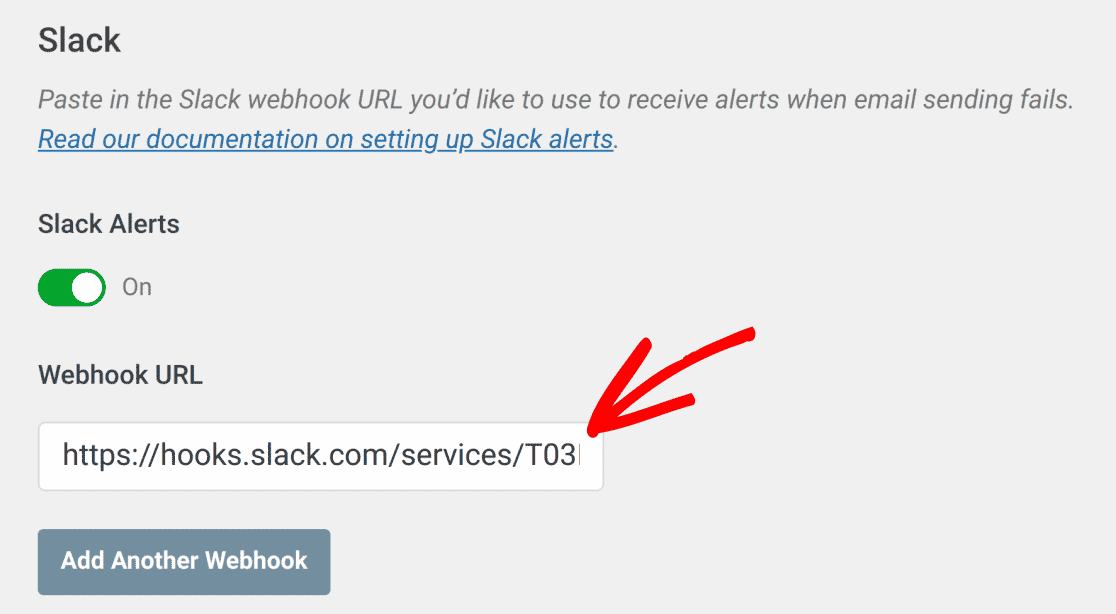
Once you’re done with this step, either save your settings or continue to add other integrations.
Once everything is set up correctly, you’ll get notifications in Slack whenever your site fails to send an email.
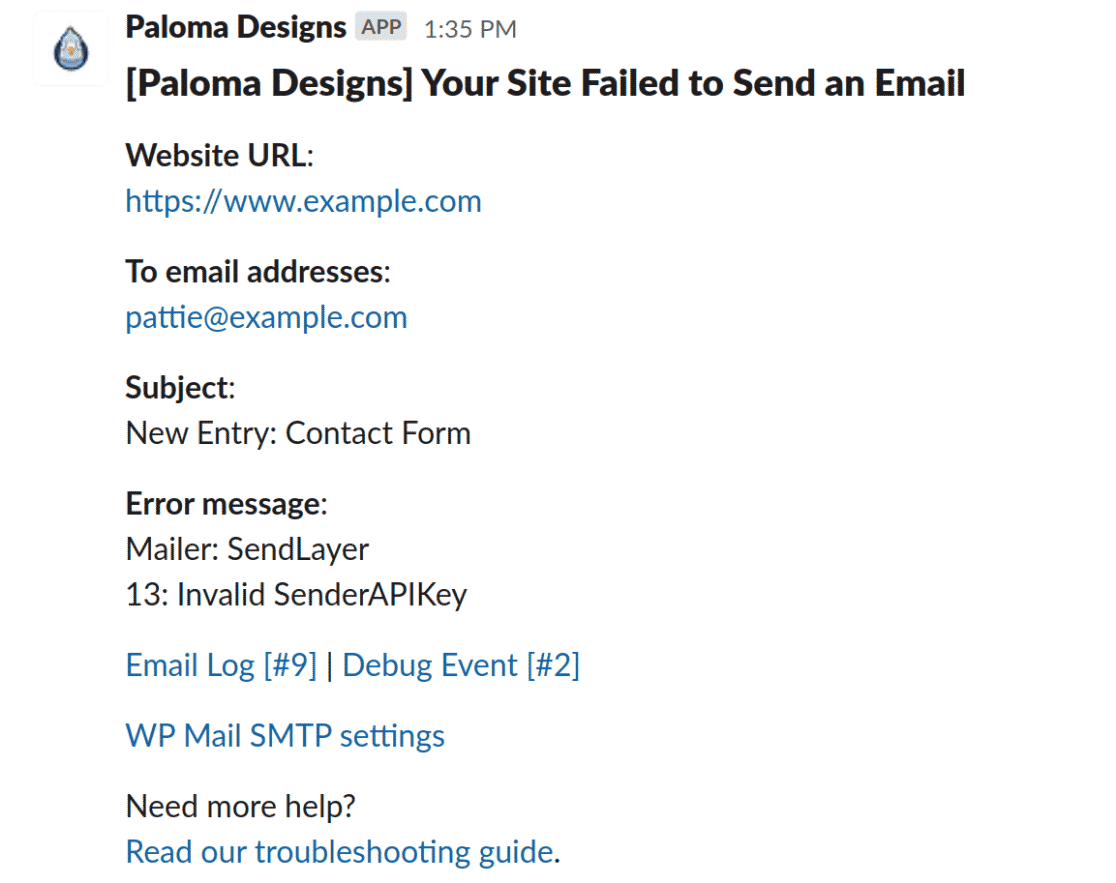
Note: For more information about using webhooks in Slack, check out Slack’s Incoming Webhooks API documentation.
Discord
With our Discord integration, alerts are sent to your Discord servers or to individual channels on your Discord server. Similar to the Slack integration, you can have as many Discord webhook connections as you need.
Setting Up Discord Integration
To get started, you’ll need to create a webhook connection on your Discord server. Then, use the webhook URL to establish a connection between your site and Discord.
To do this, toggle the Discord Alerts option to the ON position.
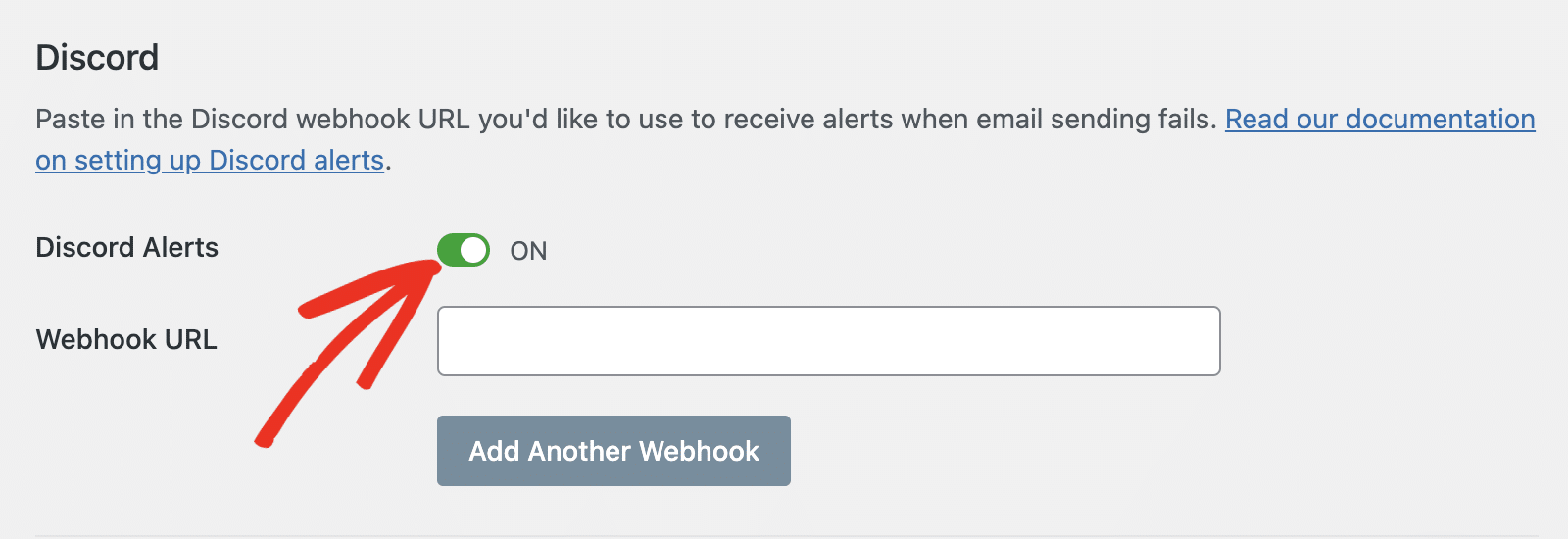
After that, you’ll need to log in to your Discord server. Once there, click the Server’s name at the top left corner to open additional settings.
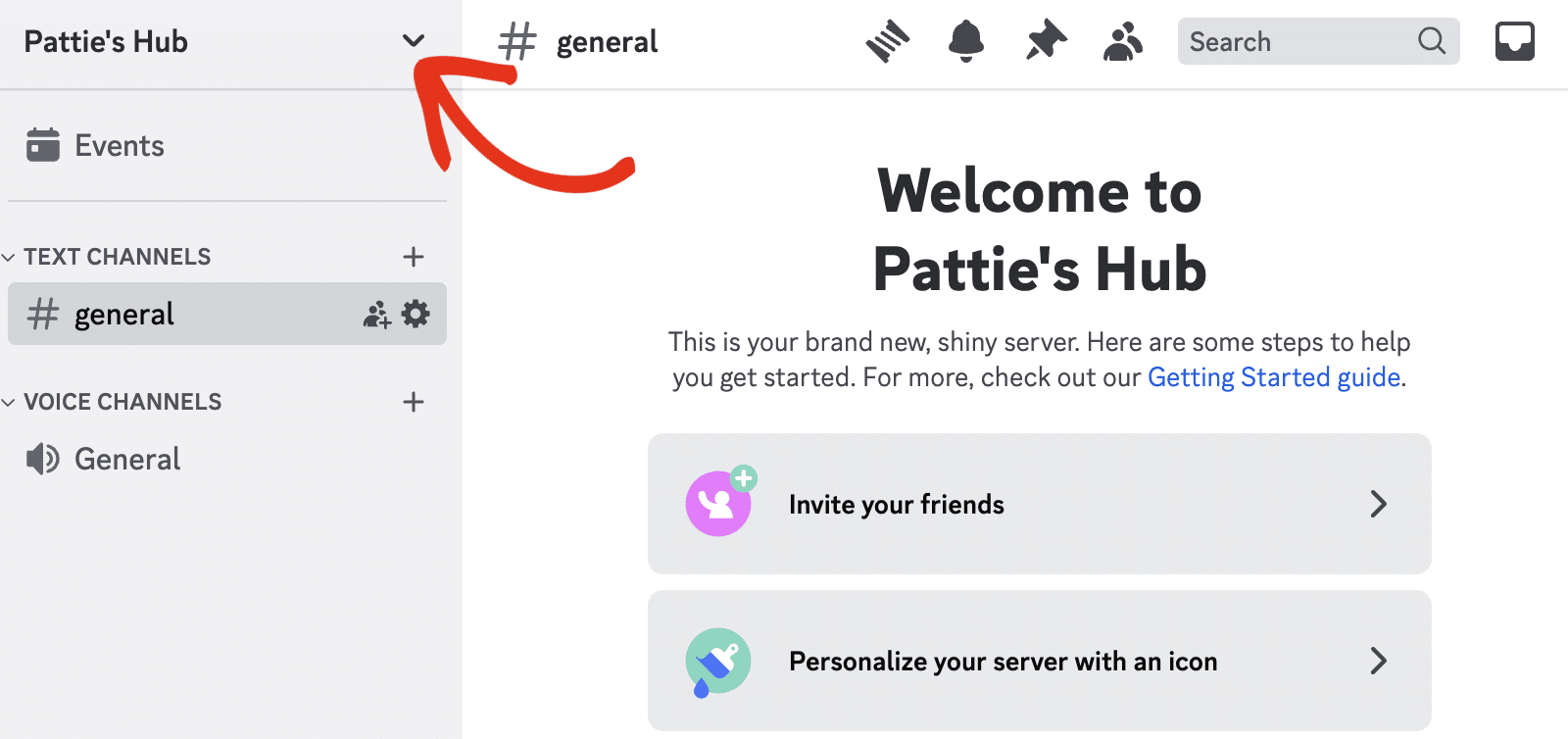
Then, select Server Settings from the dropdown menu.
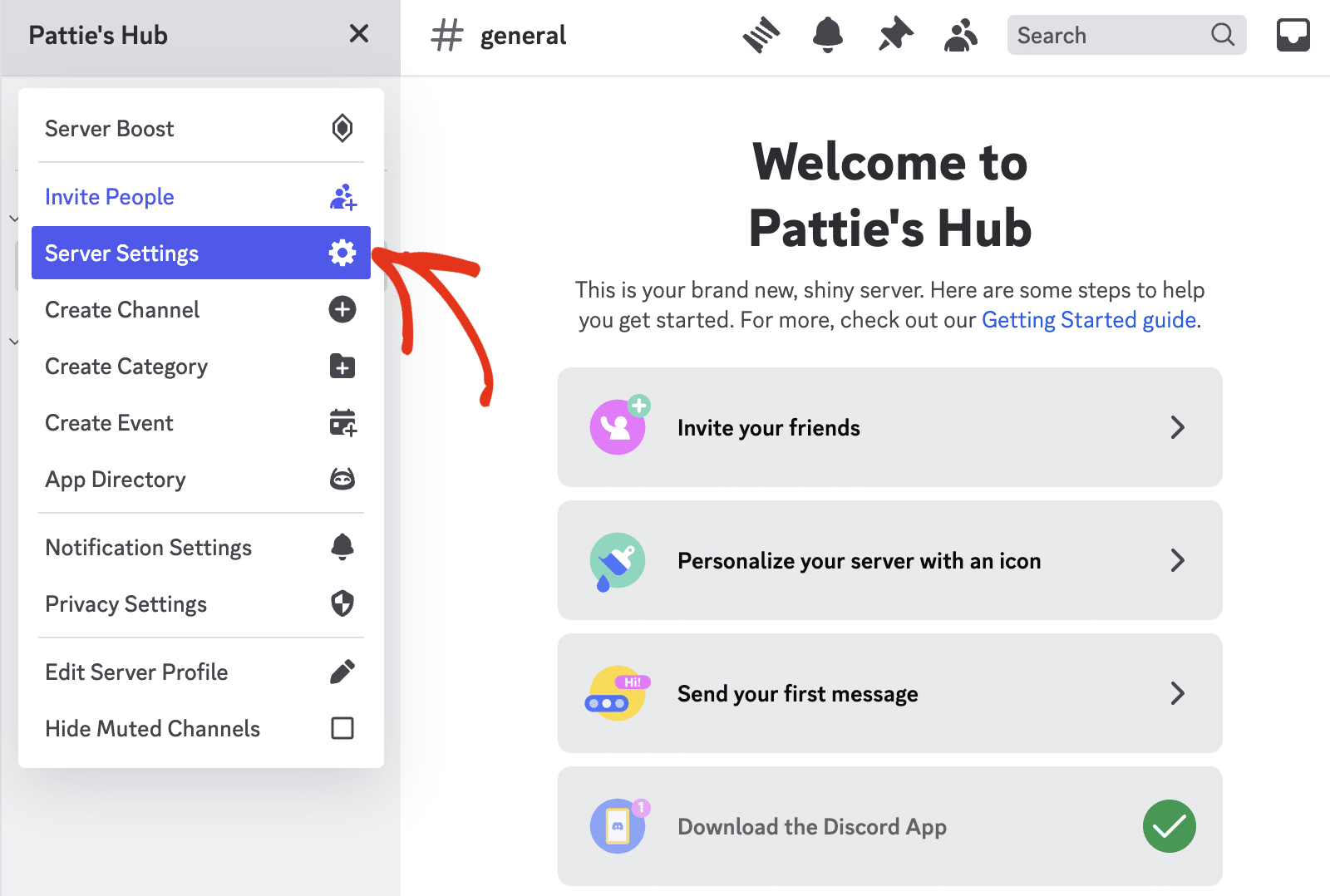
In the Server Overview page, select the Integrations sidebar menu under the APPS section.
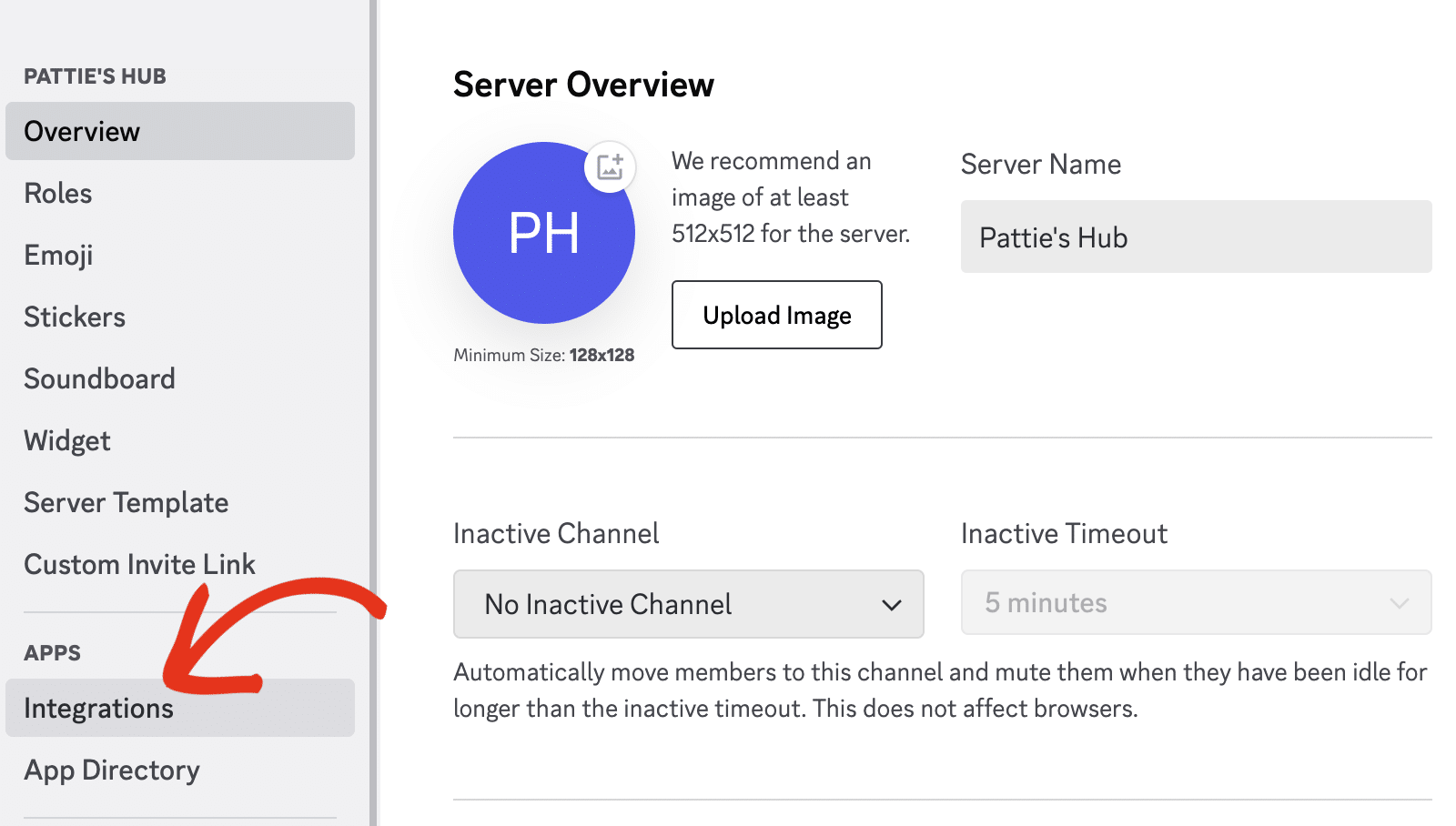
Then click the Create Webhook button to proceed.
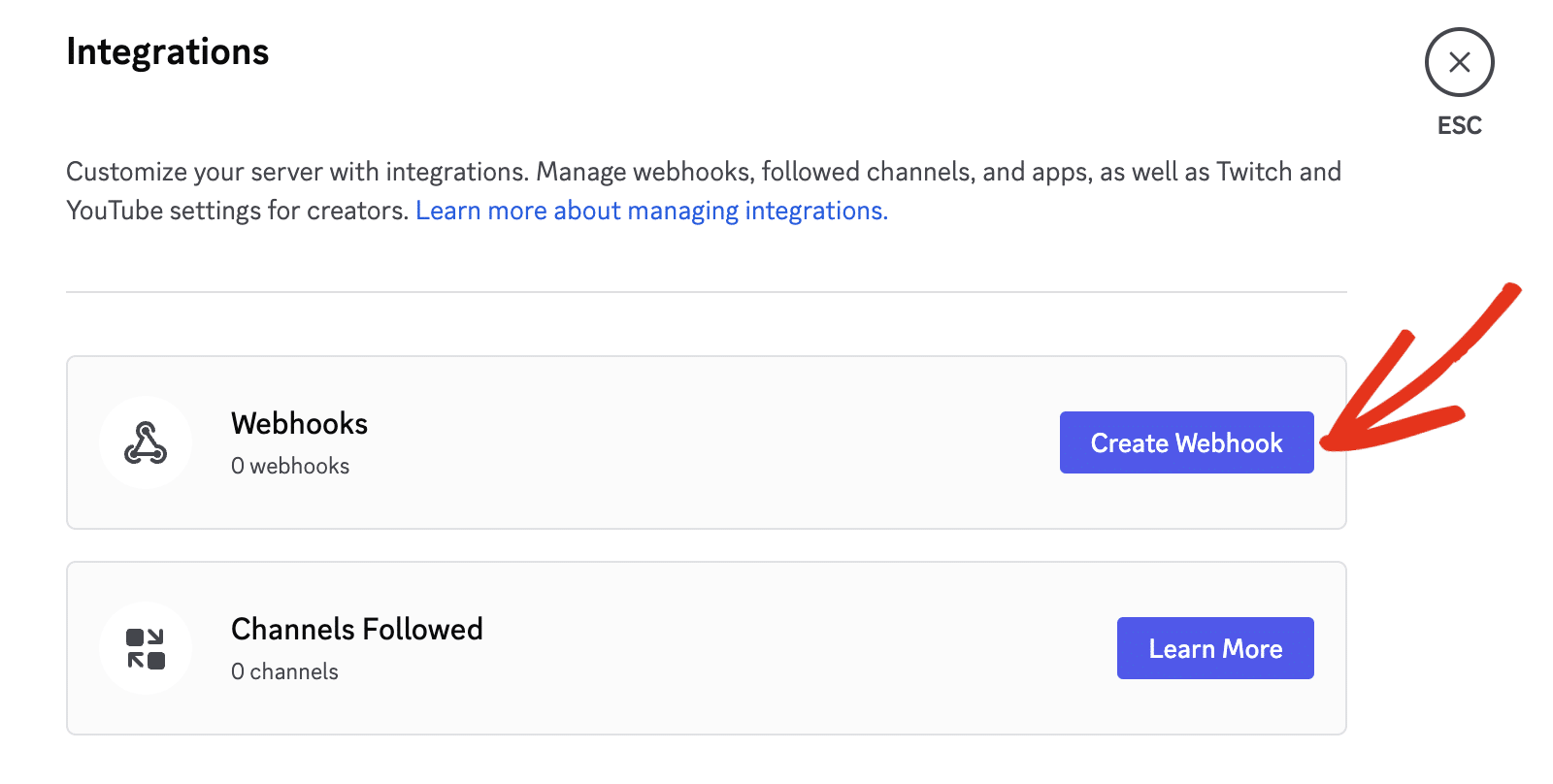
This will generate a new webhook connection for your Discord server. Go ahead and click the Webhook to view additional details.
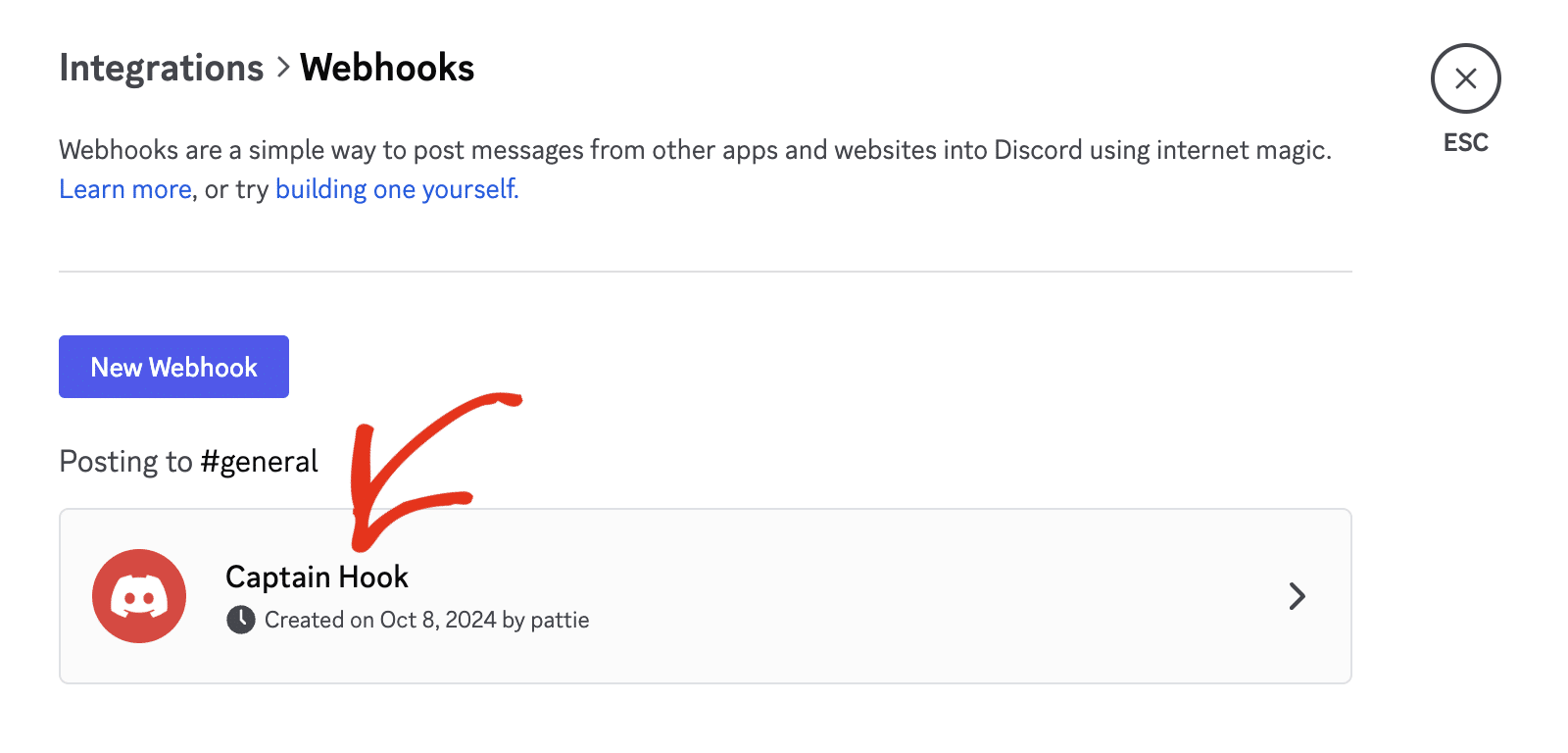
Next, enter a name you’d like to use in the Name field. This name can be helpful if you have multiple webhooks.
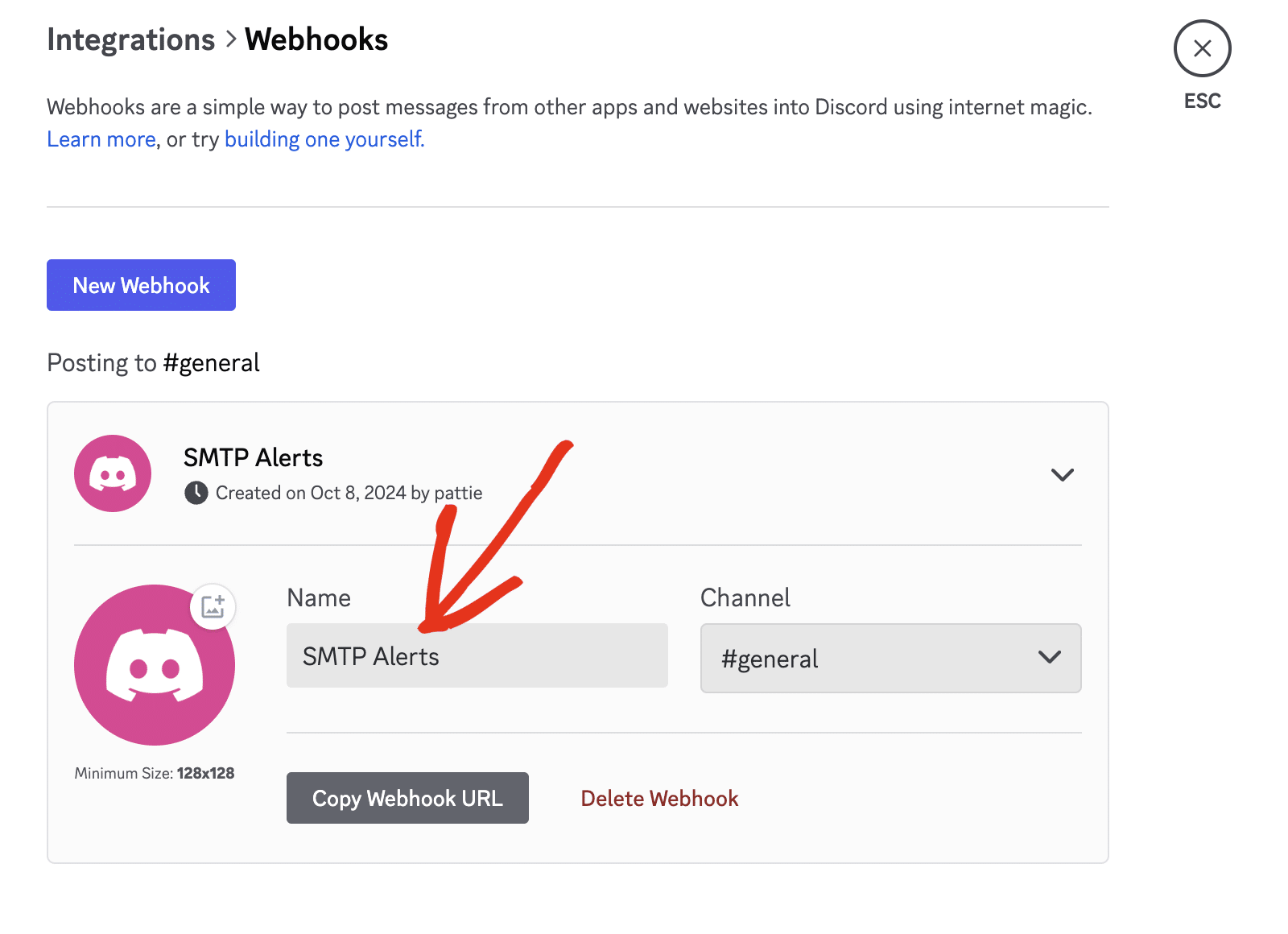
Then, you’ll need to select the channel you’d like to send the email alerts to.
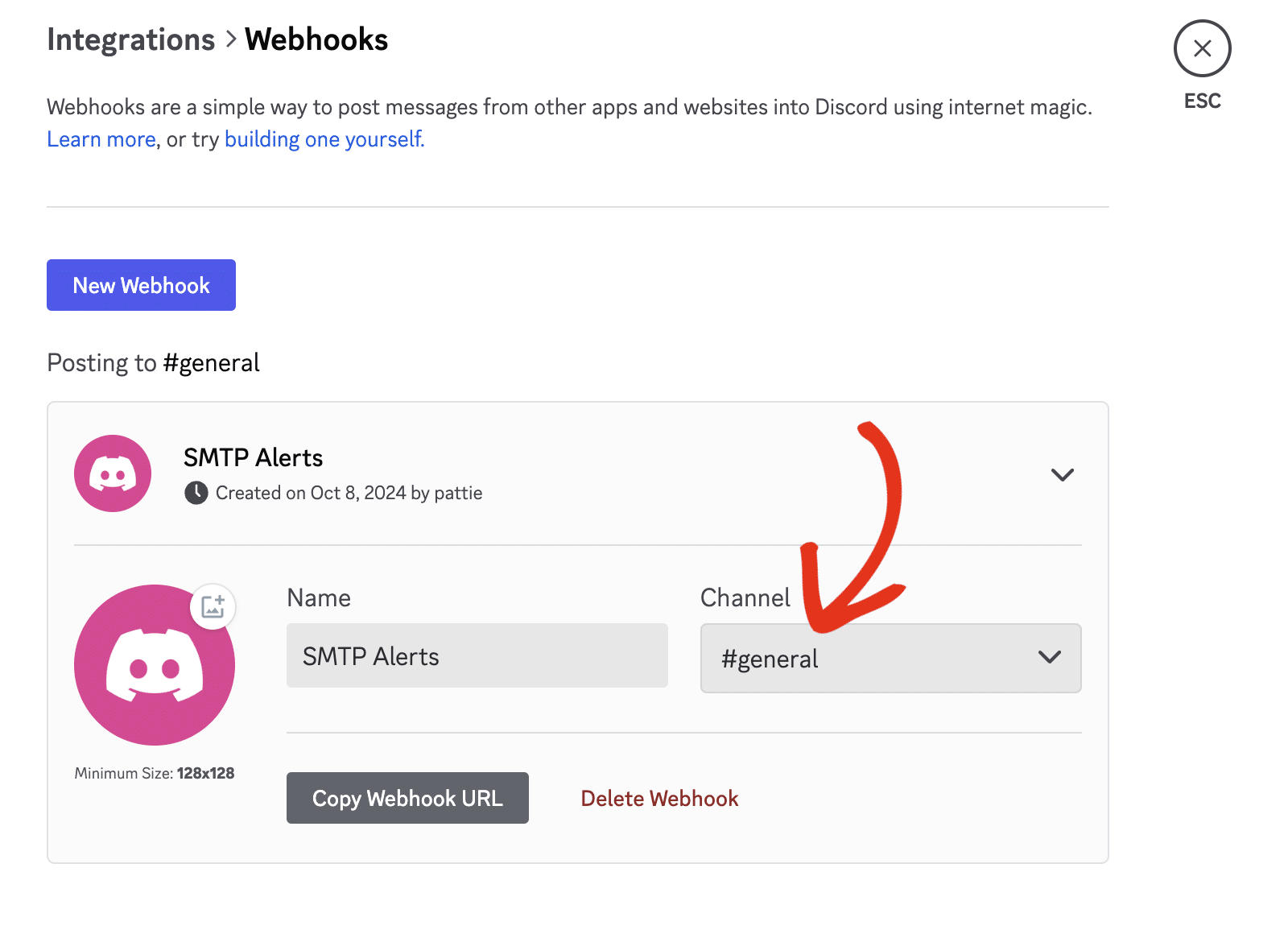
Note: You can update the webhook icon image by clicking the Photo icon next to the Discord logo.
Once done, be sure to click the Save Changes button to update your webhook.
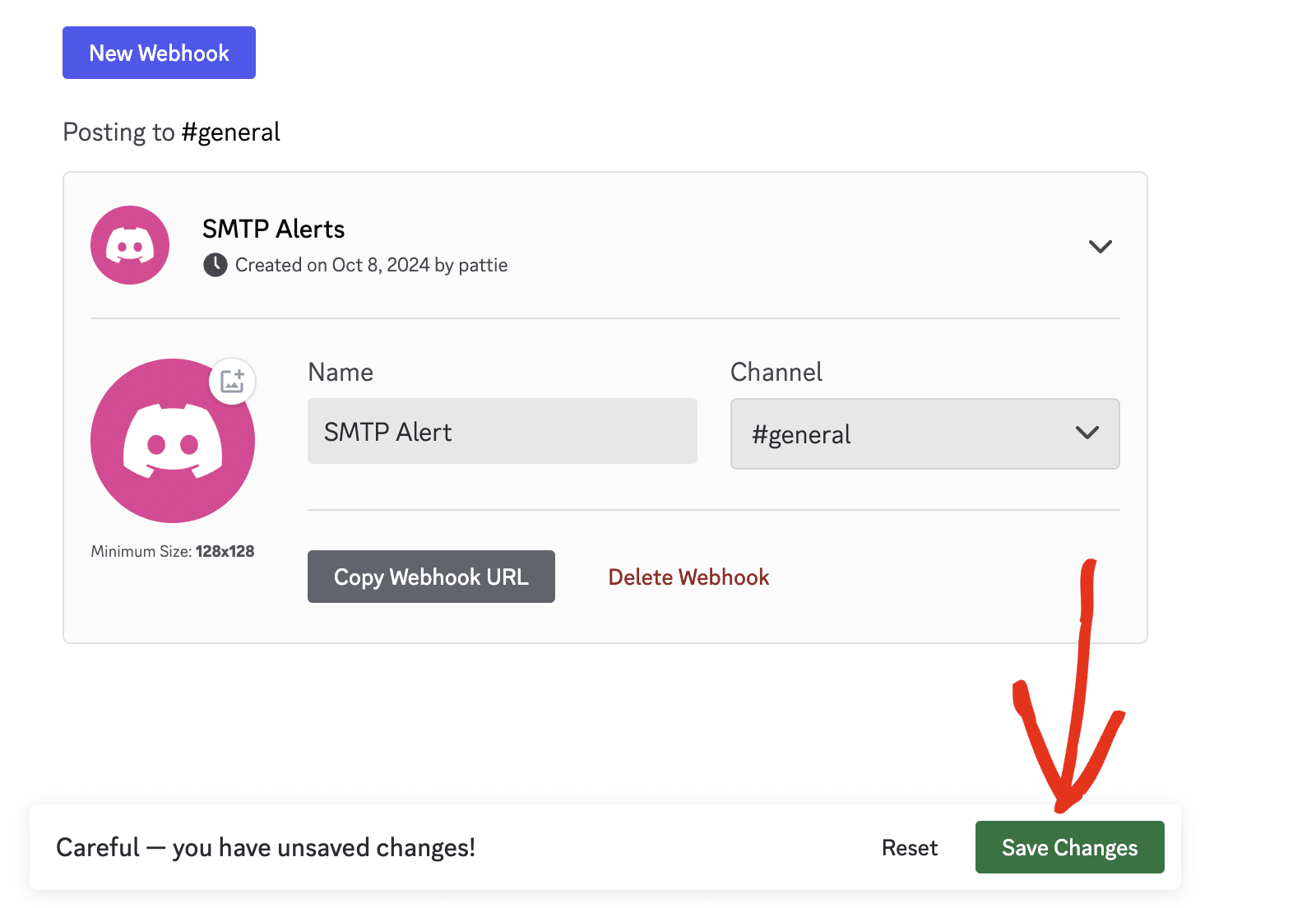
Now, click the Copy Webhook URL button for your new webhook connection.
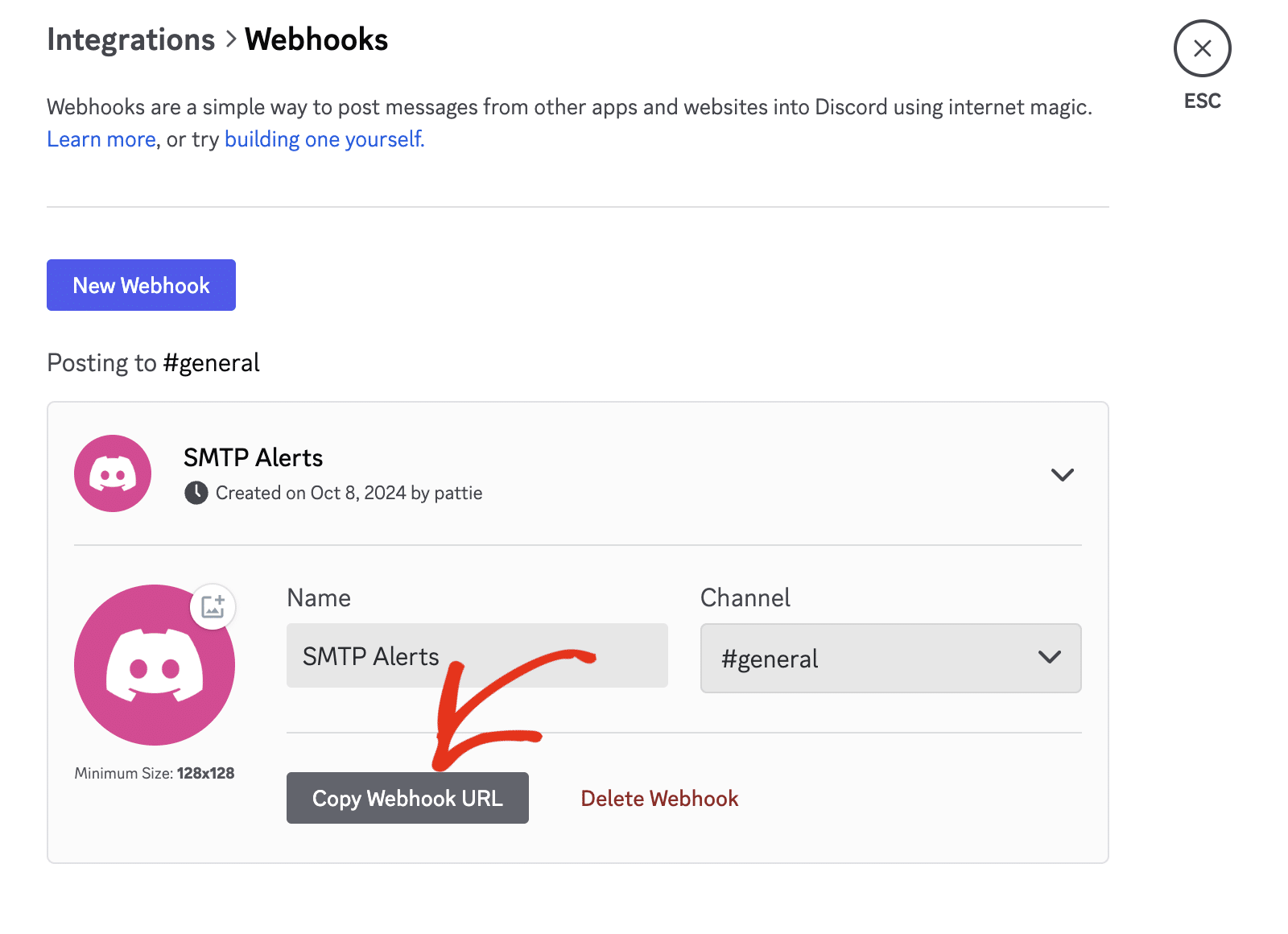
After that, return to your WP Mail SMTP Alerts settings page and paste the URL into the Webhook URL field.

Next, either save your settings or continue to add other integrations.
Once everything is set up correctly, you’ll get notifications in your Discord Server whenever your site fails to send an email.
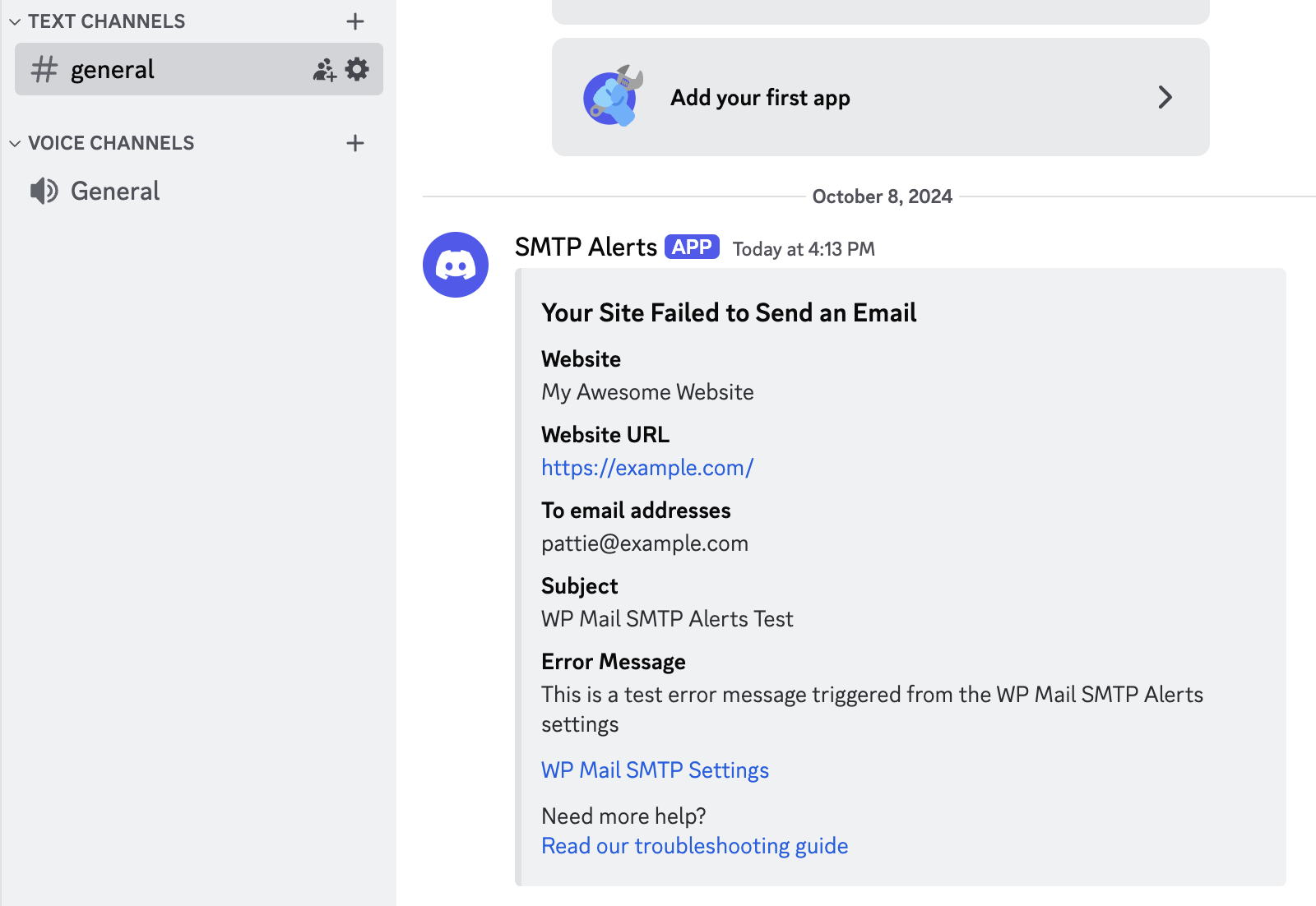
Microsoft Teams
If your team uses Microsoft Teams, you can configure alerts for individual channels on your team’s workspace.
Like the Slack integration, you can have as many Microsoft Teams configurations as needed. The Microsoft Teams integration uses webhooks to facilitate communication.
Setting Up Microsoft Teams Integration
To use the Microsoft Teams integration, you’ll need to configure a webhook connection on the channel you’d like to receive the alert. Then, add the webhook URL you generate from Microsoft Teams to your site.
Start by toggling the Microsoft Teams Alerts option to the ON position.
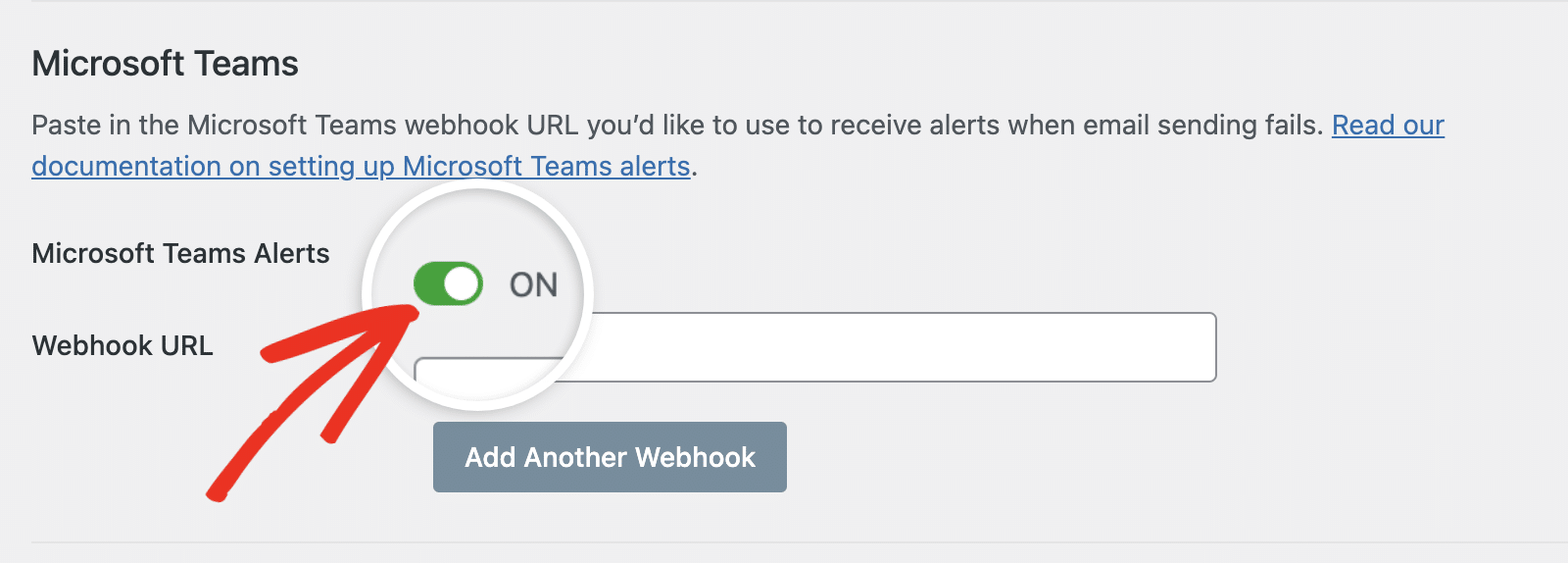
Next, log in to your Microsoft Teams workspace. Once there, open the channel you’d like to configure to receive alerts. Then click on the 3 dot icons next to the channel name to open additional settings.
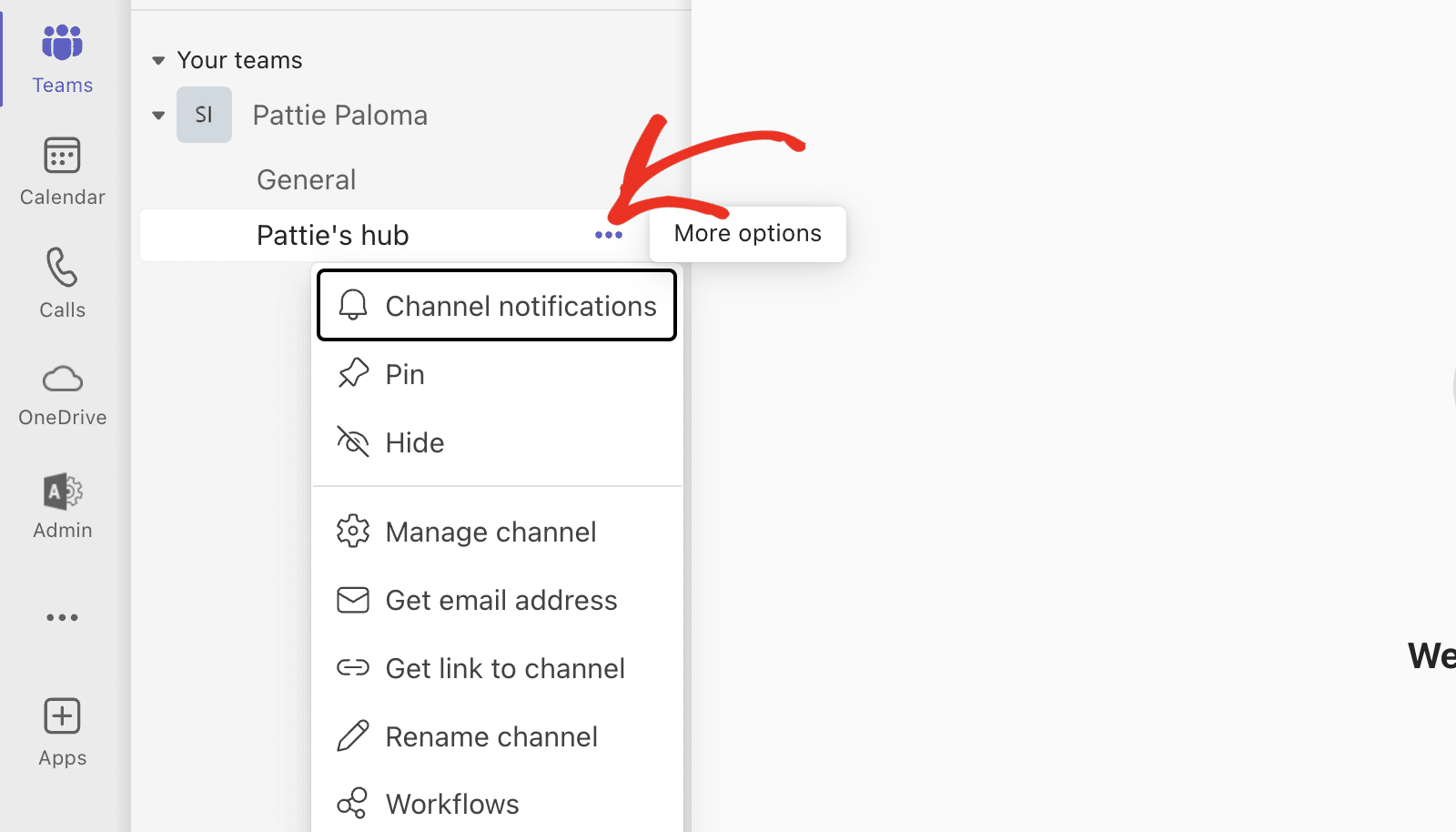
After that, select the Workflows option to continue.
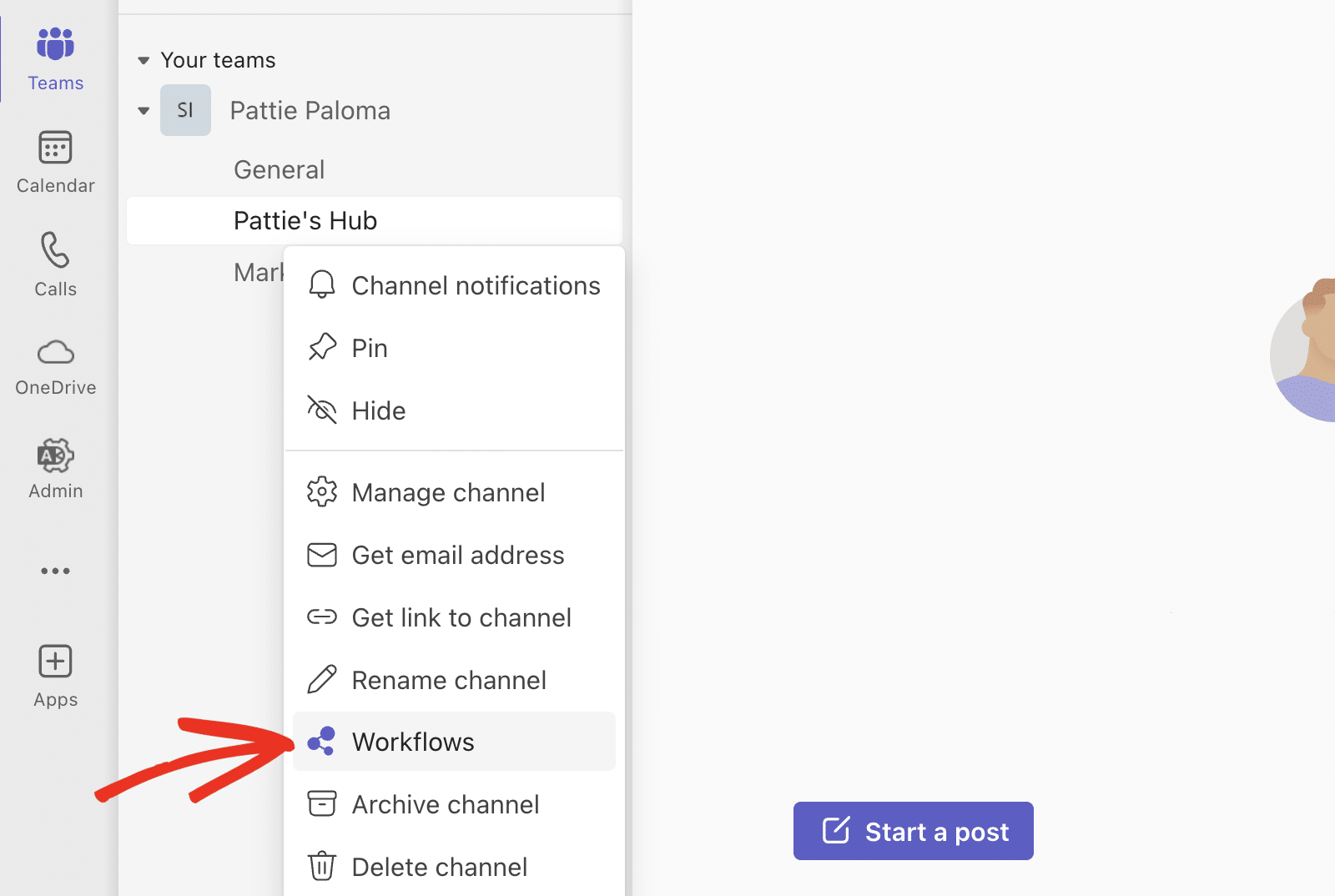
In the overlay that appears, type ‘webhook’ into the search field.
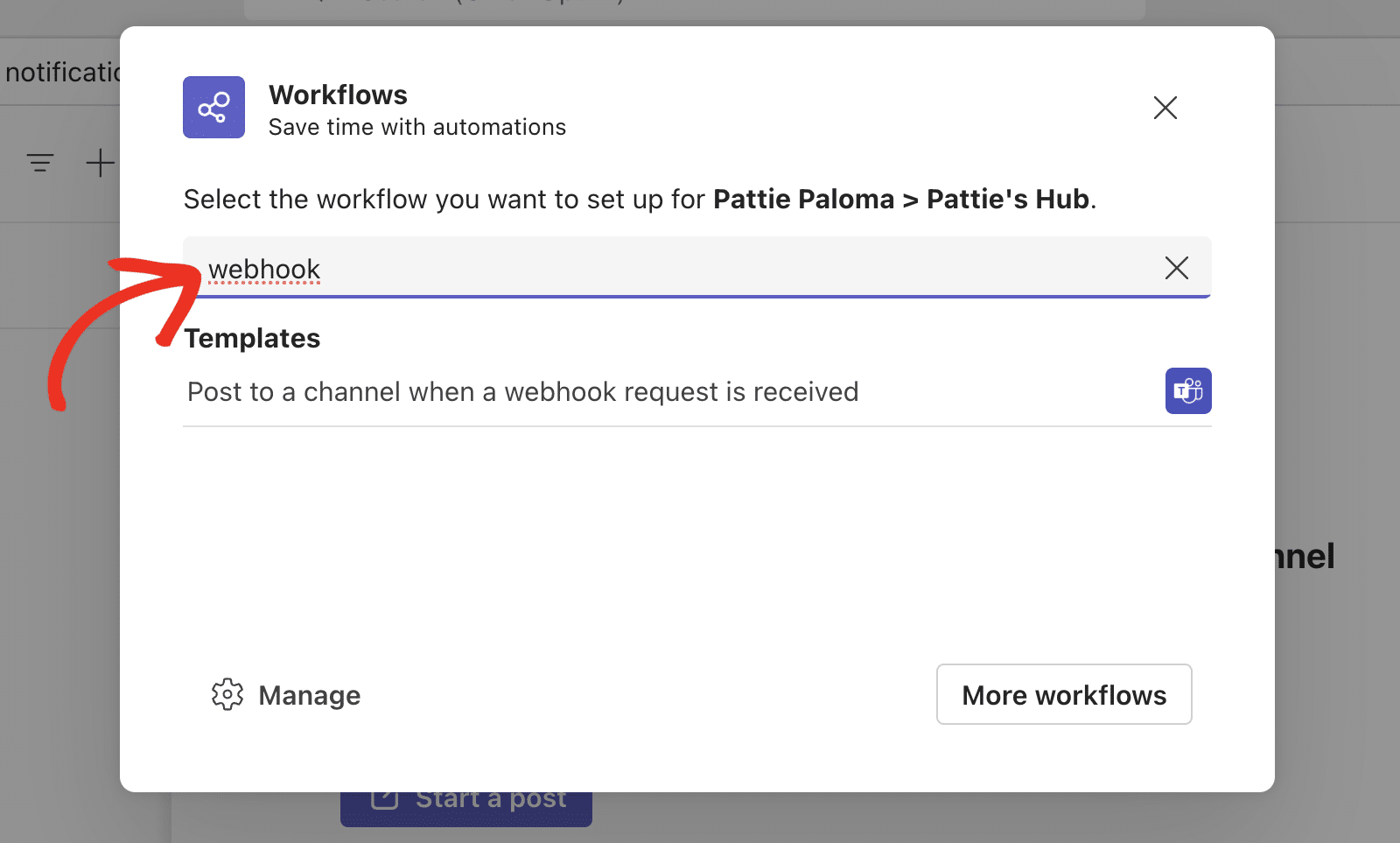
Then, select the Post to a channel when a webhook request is received option.
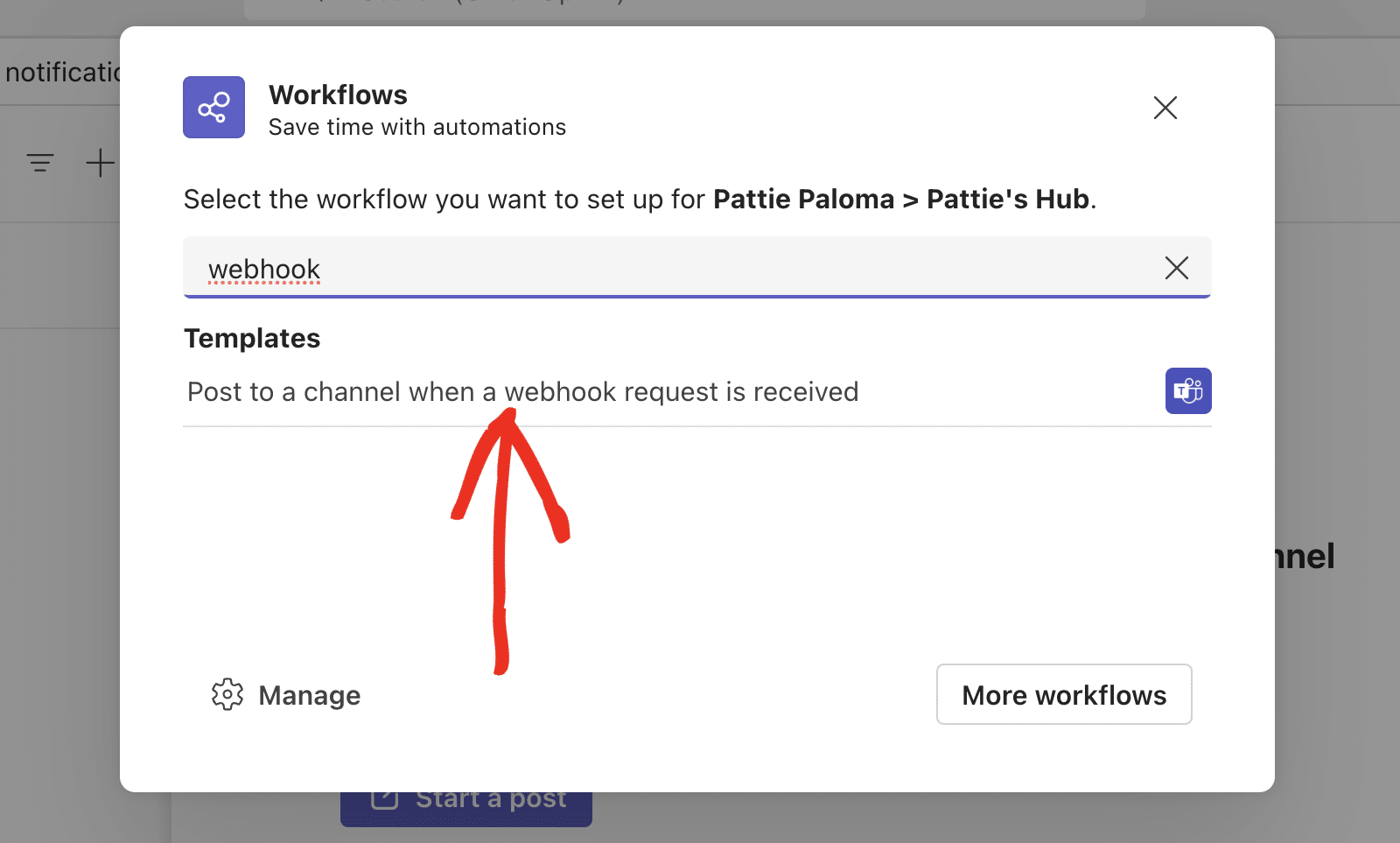
Next, you’ll need to enter a name for your webhook in the Name field. We suggest using a descriptive name that defines the purpose of the webhook connection.
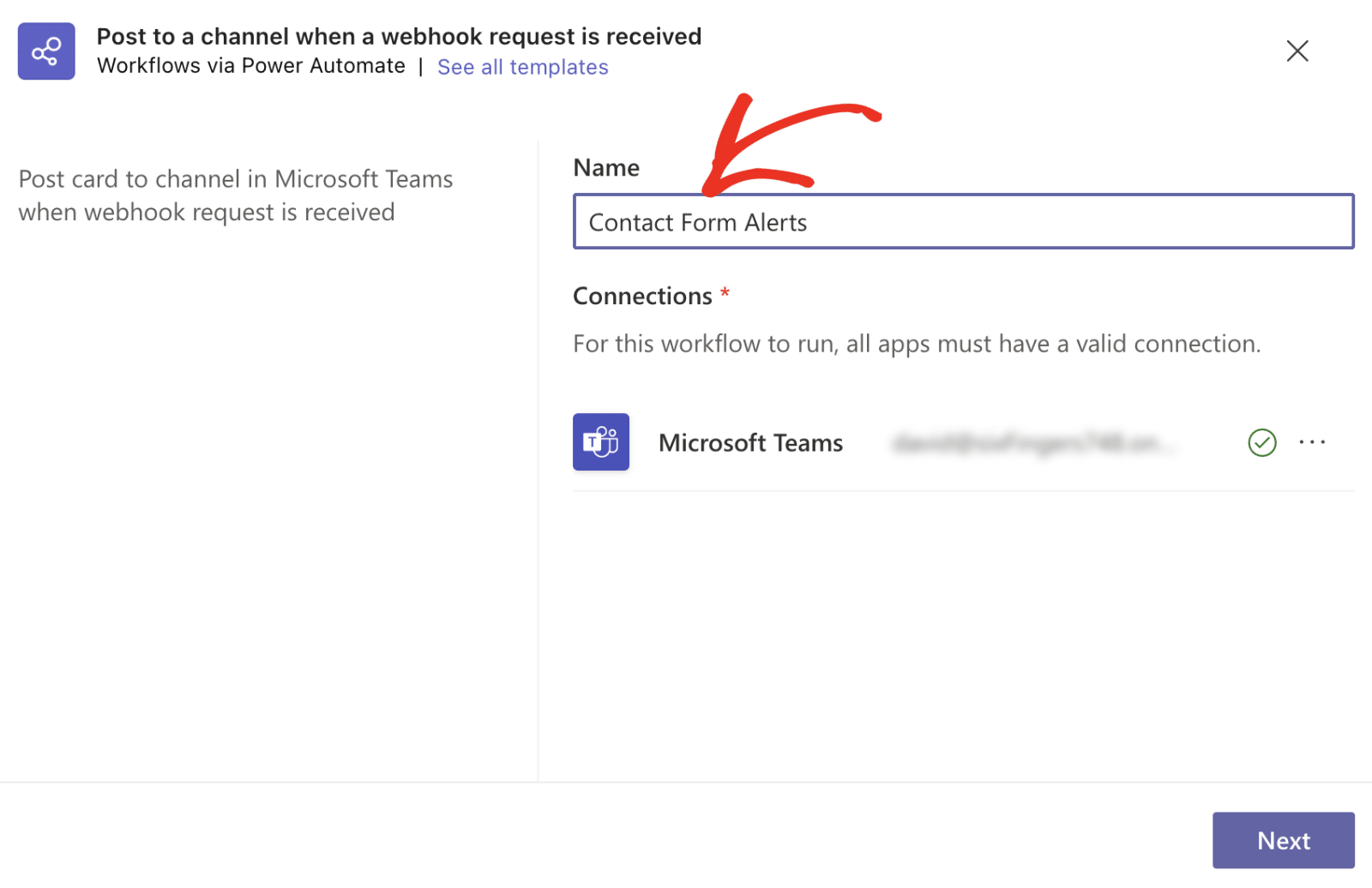
After that, click the Next button to continue.
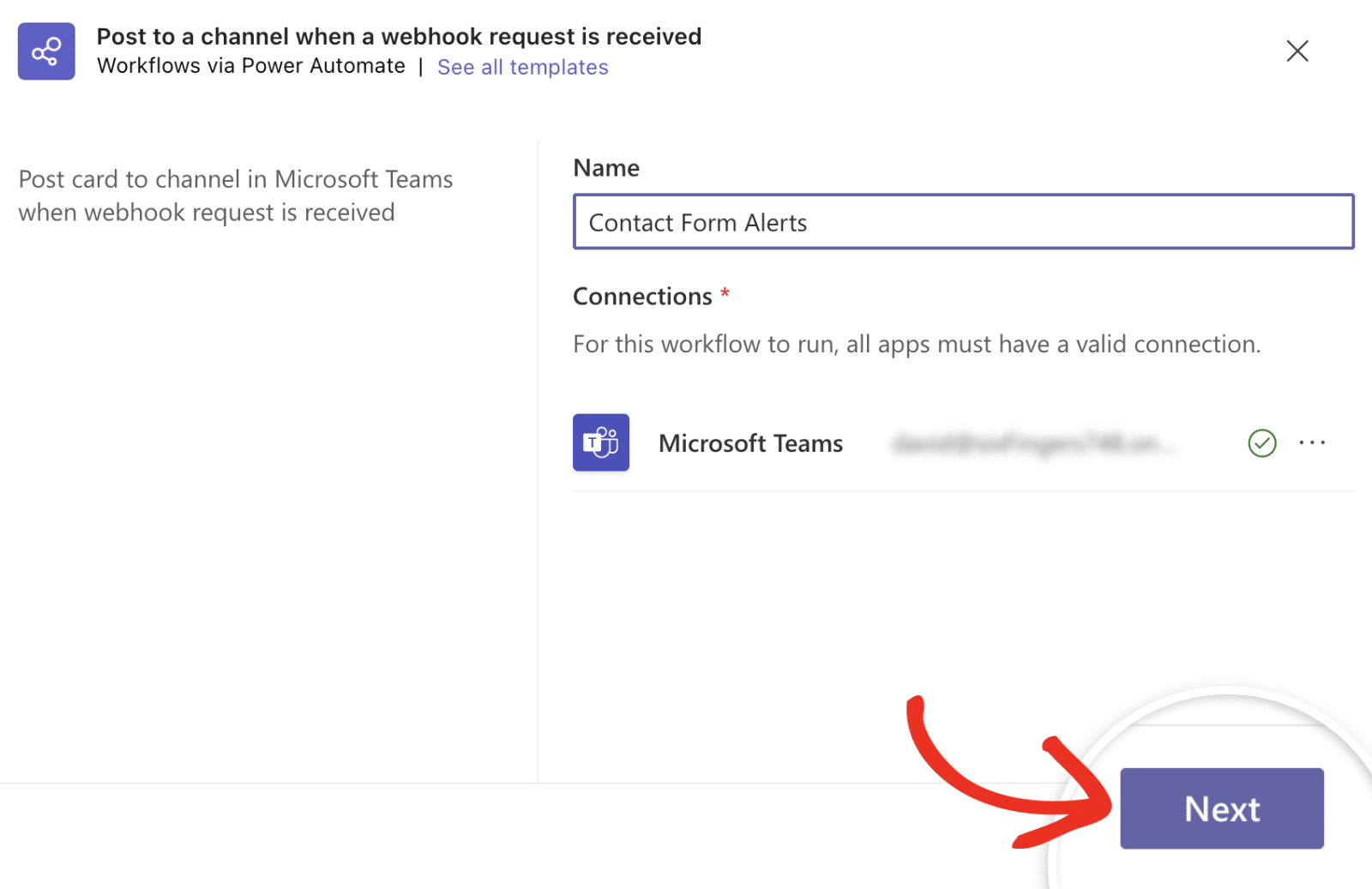
On the next page, you’ll need to select the team and channel where you’d like to send the notification from the Microsoft Teams Team and Microsoft Teams Channel dropdown, respectively.
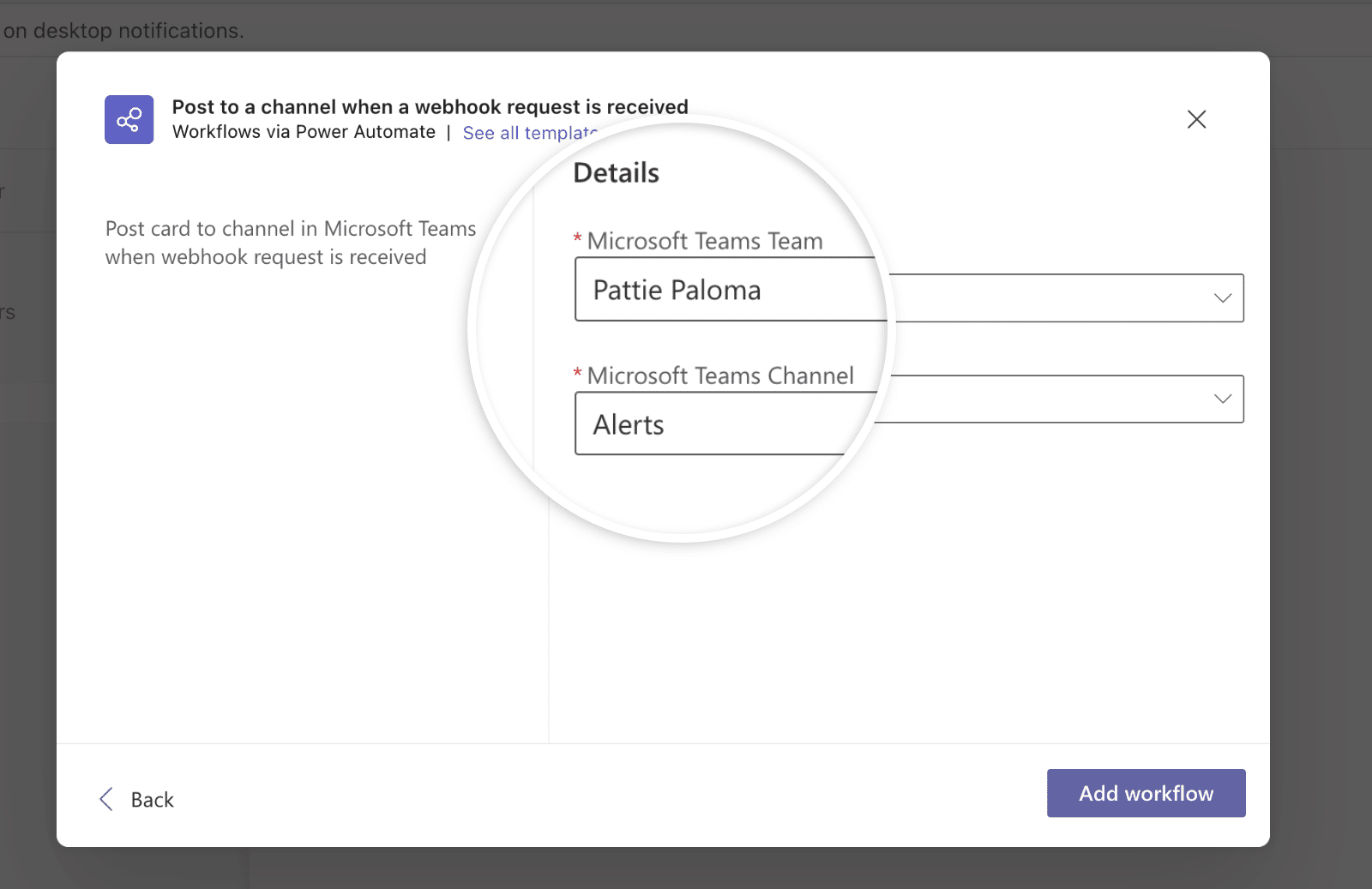
Then click the Add workflow button to complete the configuration.
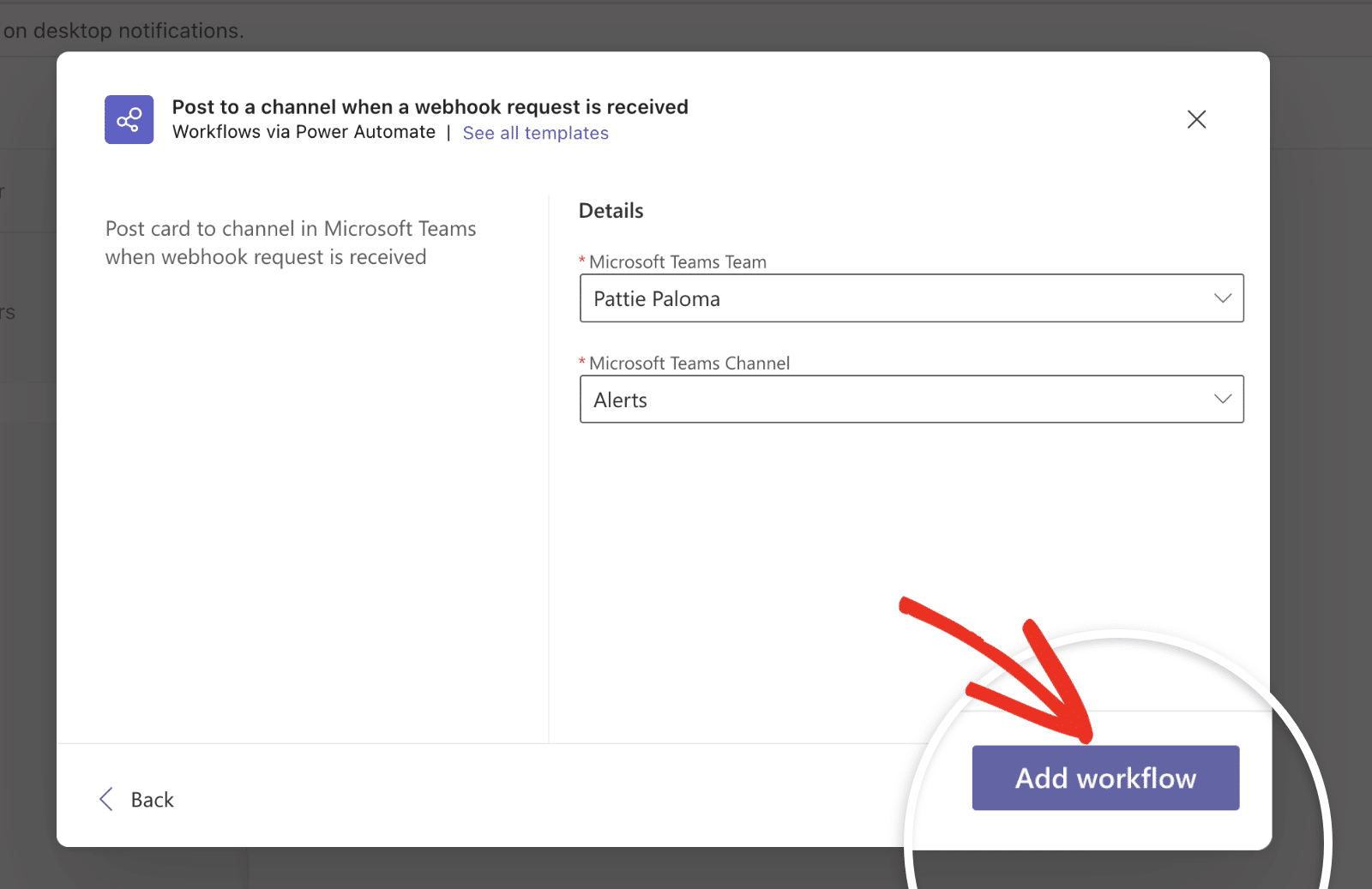
You should see a message that the workflow was added successfully. Go ahead and click the copy icon next to the webhook URL.
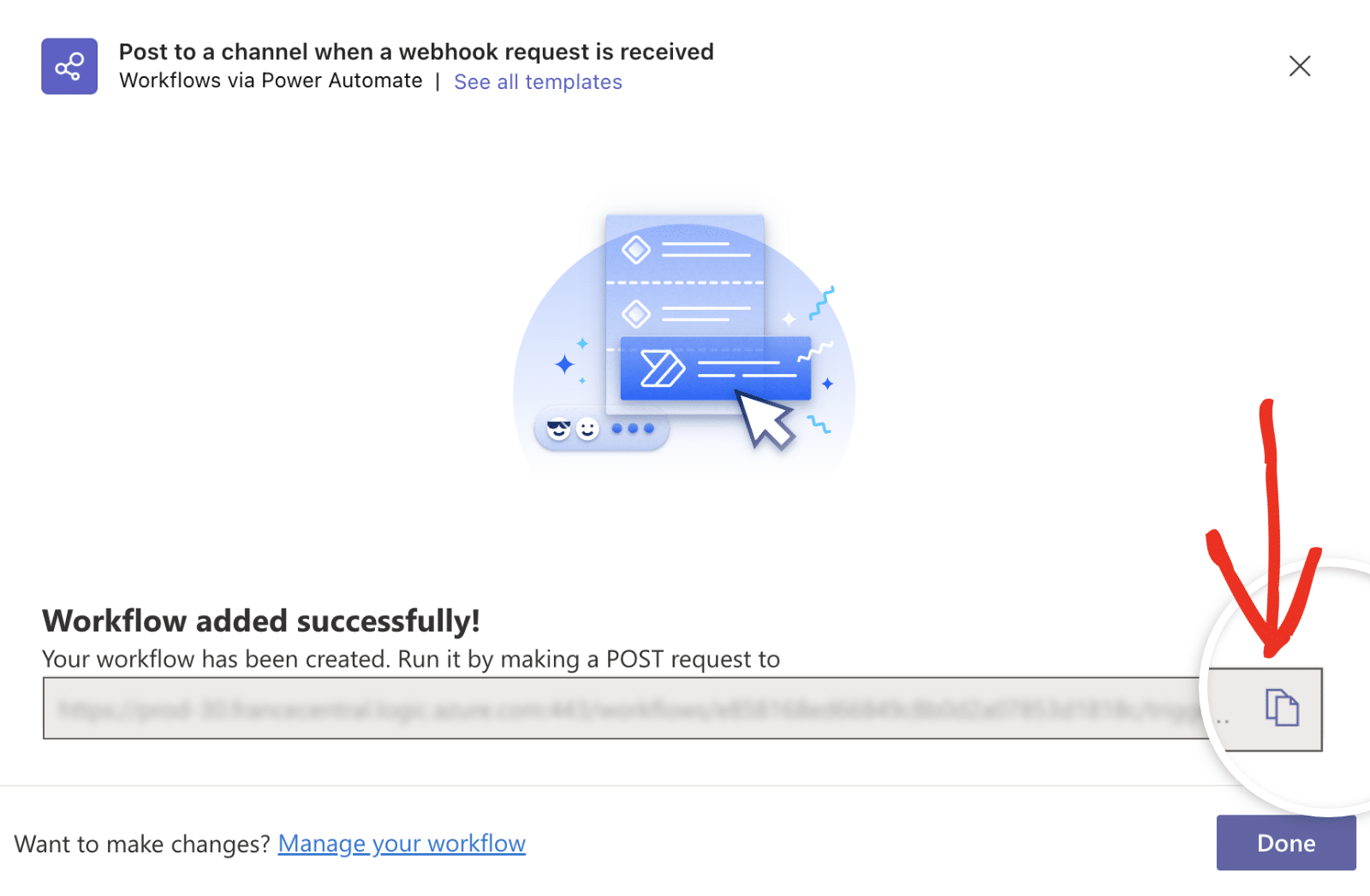
Now, return to your WP Mail SMTP Alerts settings page and paste the URL into the Webhook URL field.
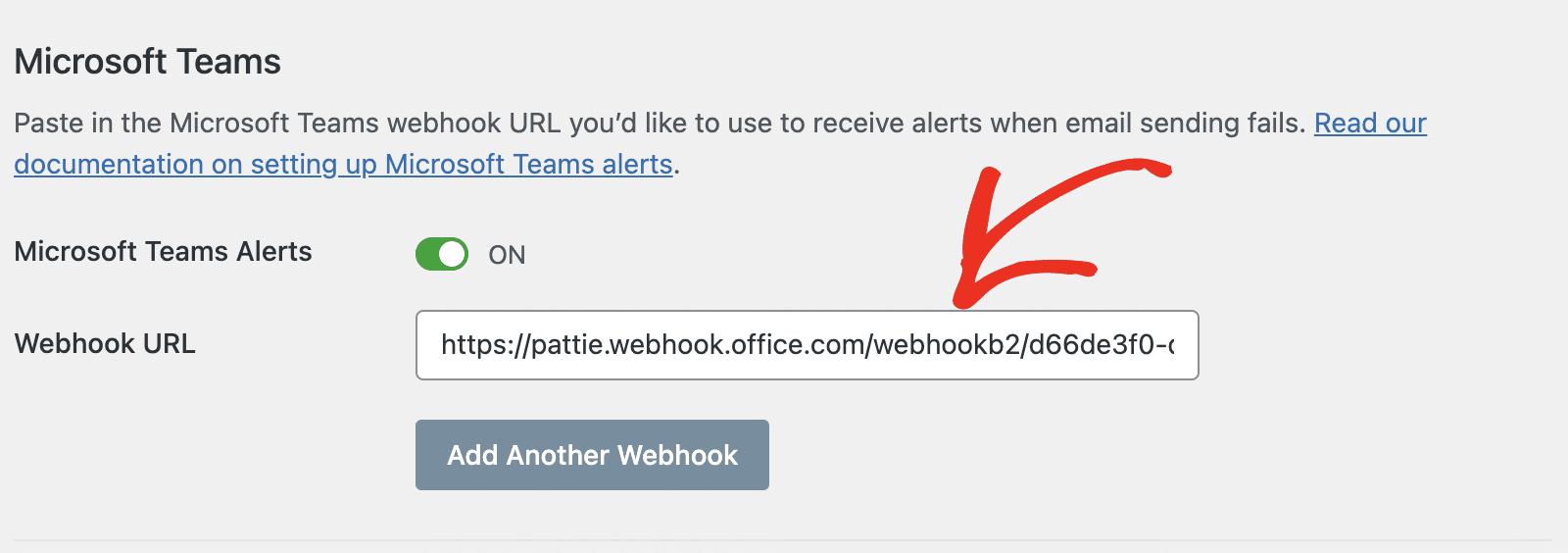
After that, either save your settings or continue to add other integrations.
Once everything is set up correctly, you’ll get notifications in Microsoft Teams whenever your site fails to send an email.
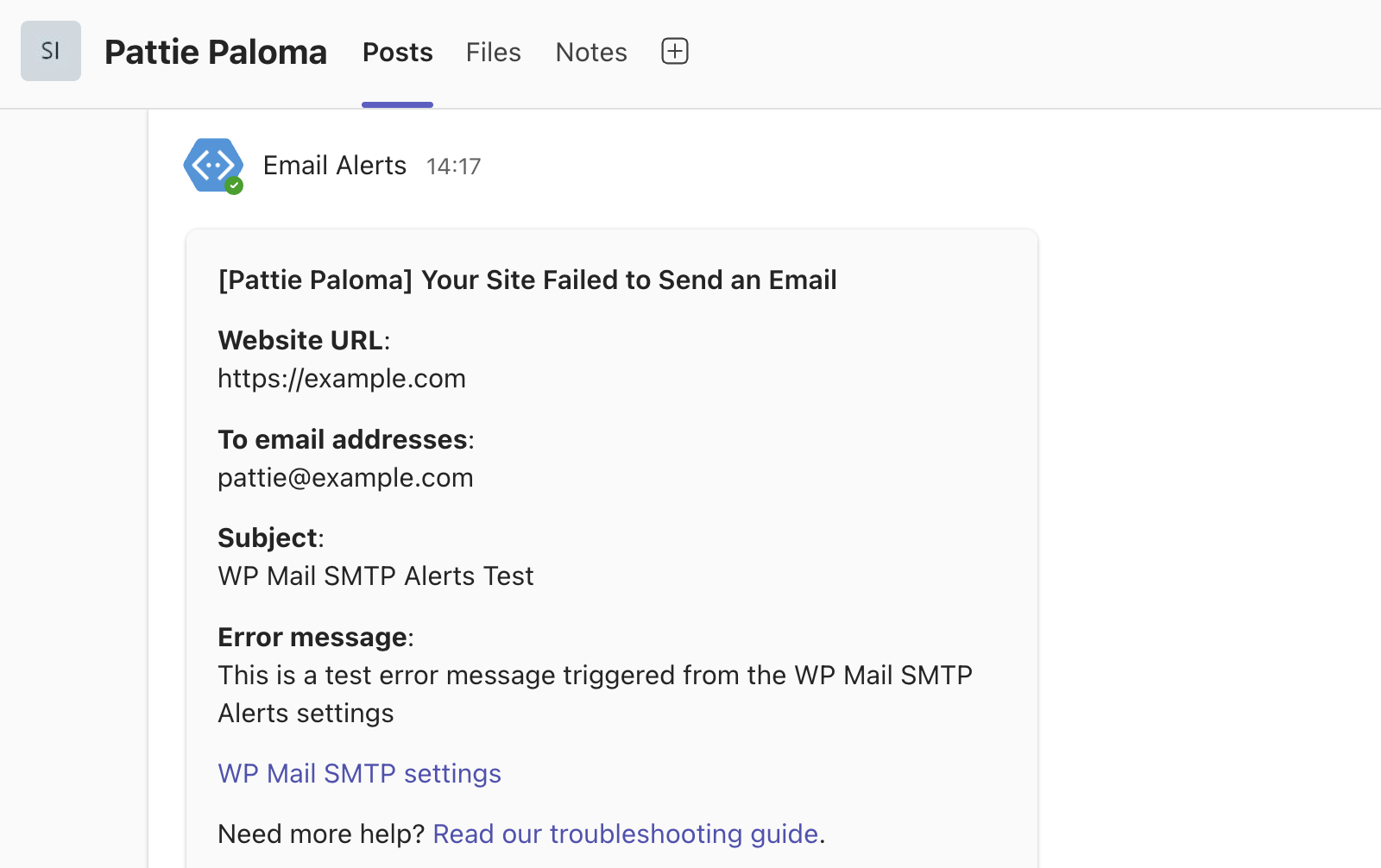
SMS via Twilio Alerts
With Twilio integration, email alerts can be sent from your site to any mobile device. SMS alerts are sent via your Twilio phone number.
Due to SMS character limits, this service integration cannot provide you with extensive details. Instead, the message you receive will include the title and log number corresponding to the error that triggered the alert.
As with Slack, there is no limit on the number of Twilio connections.
Setting Up Twilio Integration
To set up Twilio integration, ensure that you have the SMS via Twilio Alerts option toggled to the on position.

If you don’t already have a Twilio phone number, you’ll need to create one. To do this, log in to your Twilio account and click the Get a Twilio phone number button.
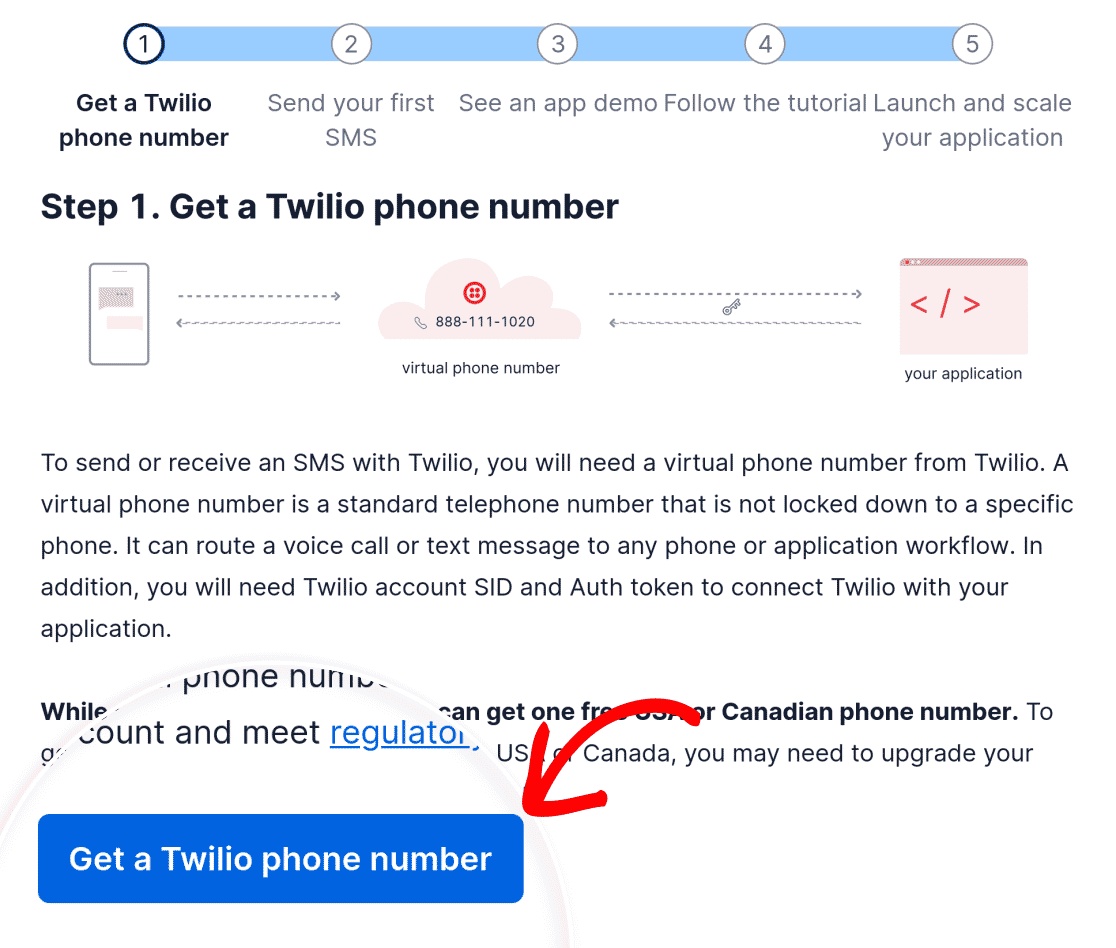
Once your number has been successfully generated, you’re ready to continue setting up Twilio integration on your site.
First, copy your Account SID from the Twilio console.
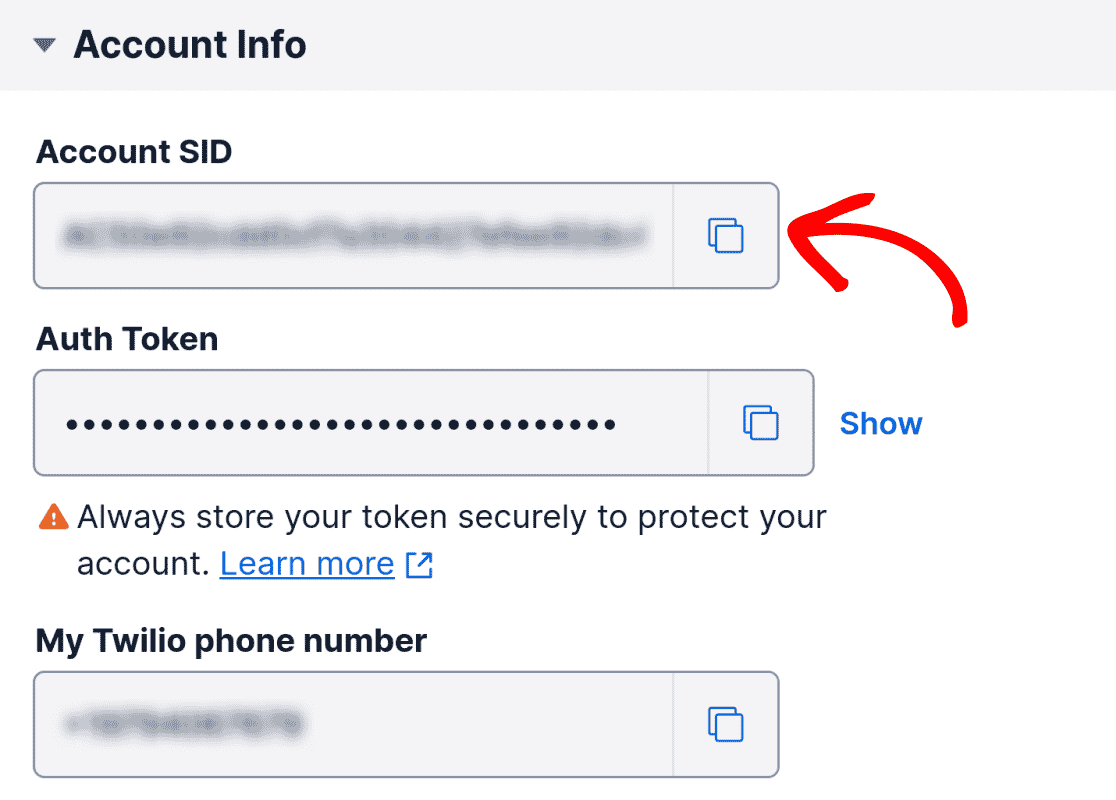
Then, paste your Account SID into the Twilio Account ID field in WP Mail SMTP.
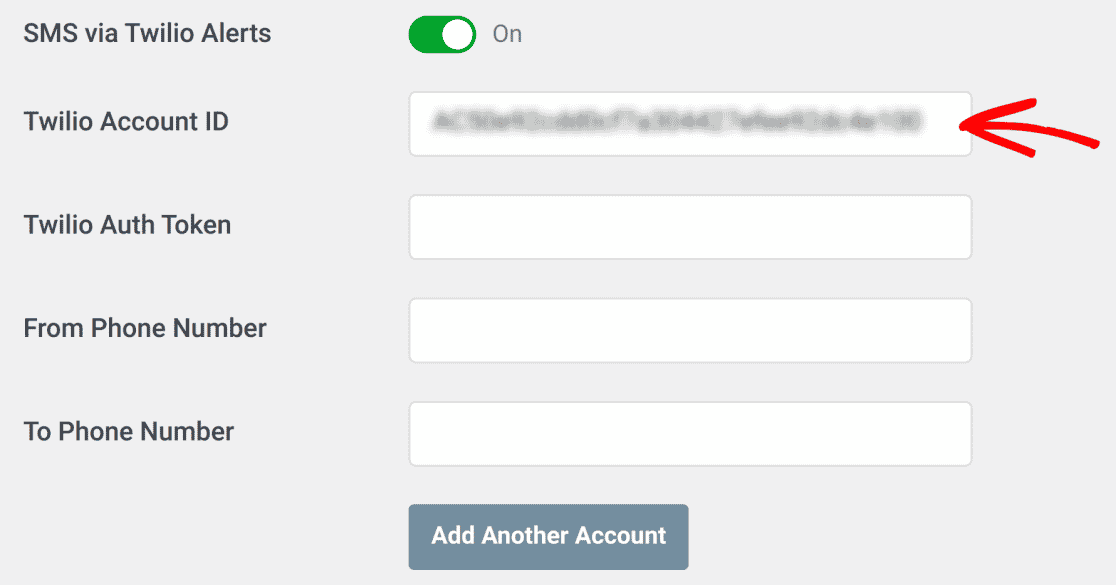
You’ll also need to copy the Auth Token from the Twilio console.
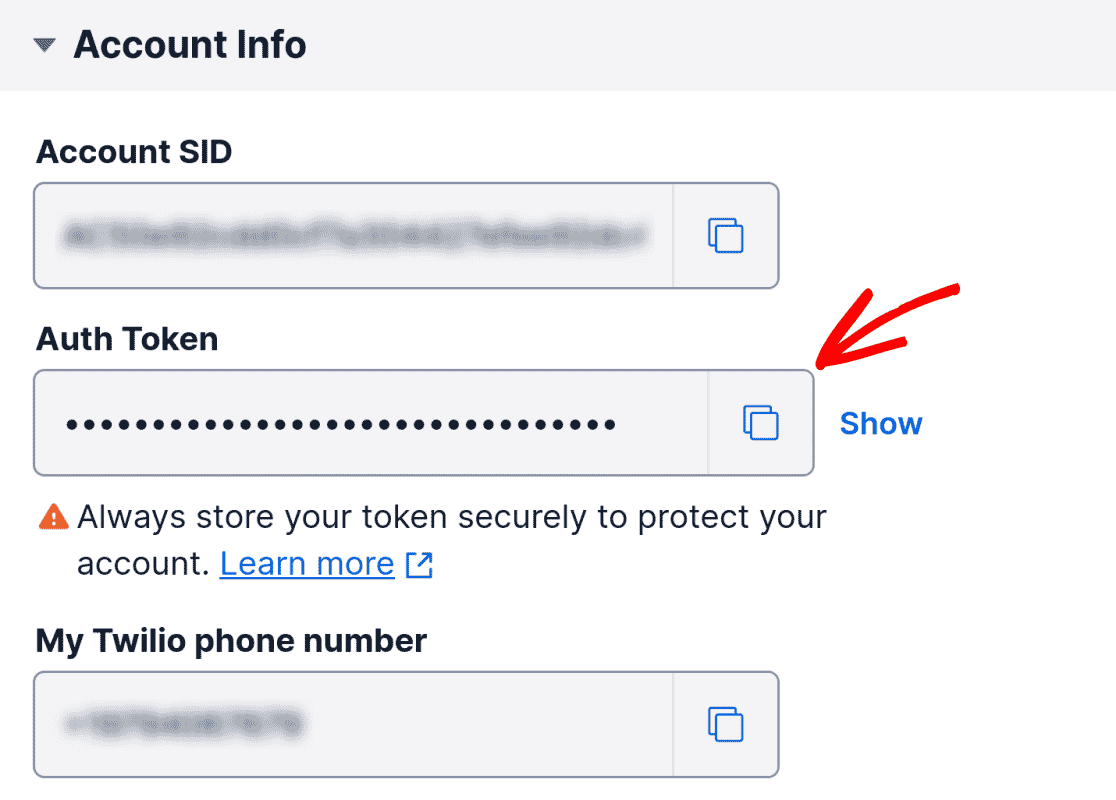
Next, paste the Auth Token in the Twilio Auth Token field in WP Mail SMTP.
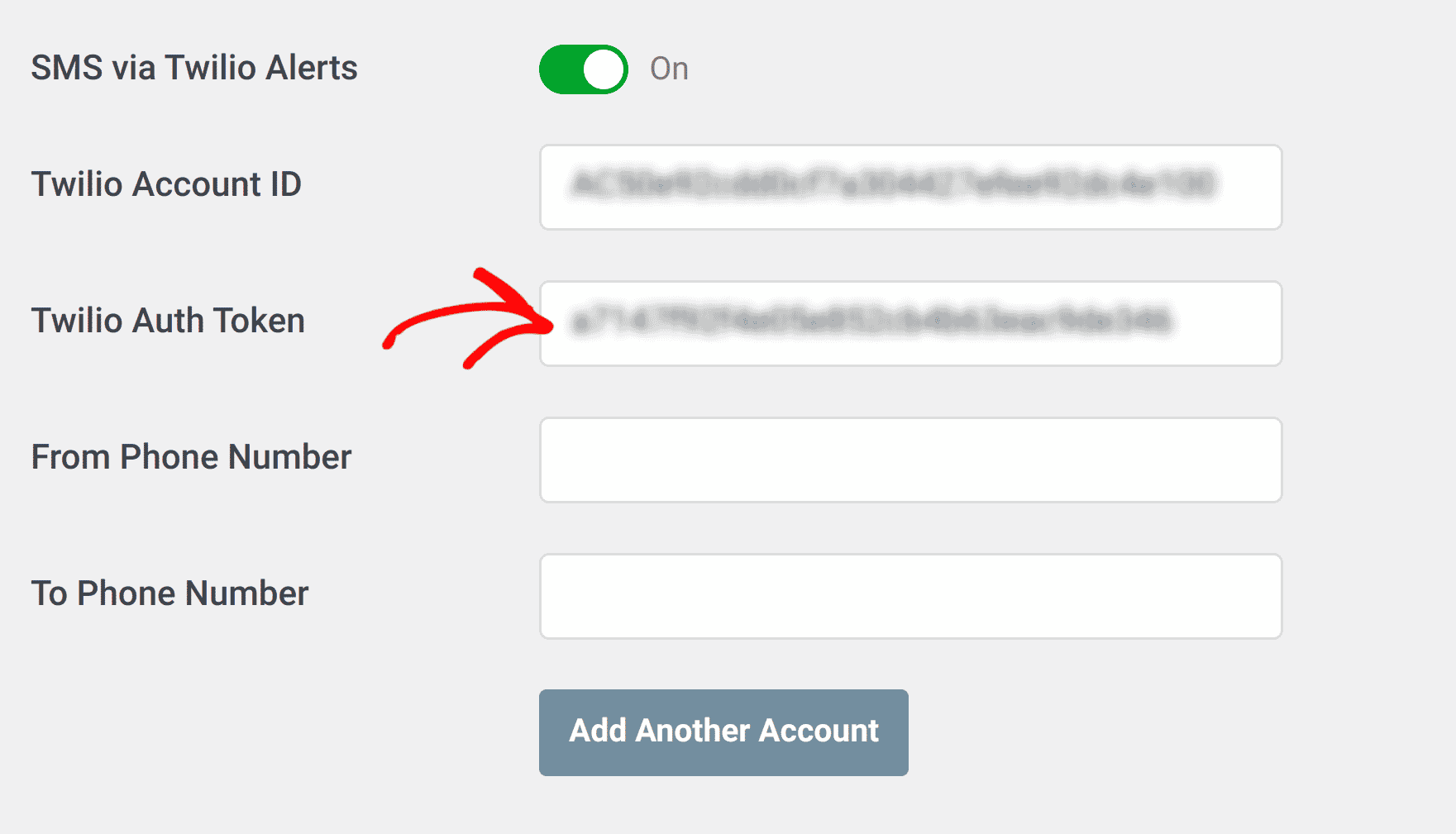
Now, copy your Twilio phone number from the Twilio console.
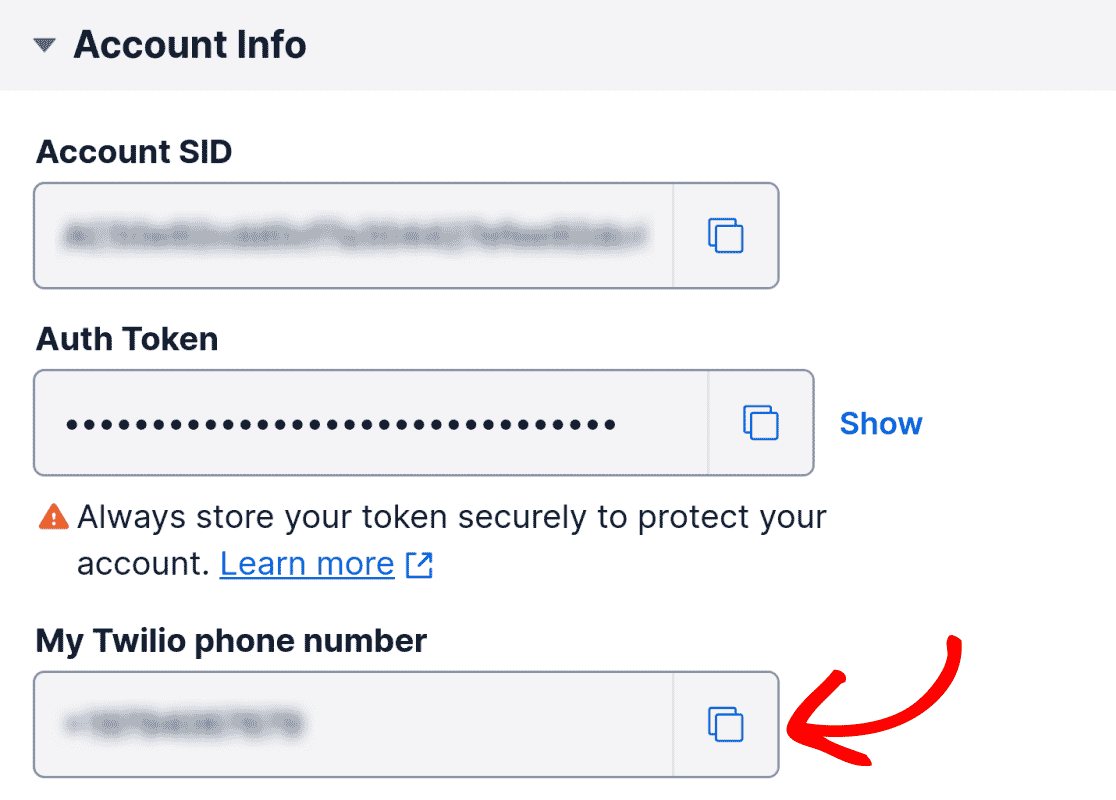
In your Alerts settings in WP Mail SMTP, paste your Twilio phone number in the From Phone Number field.
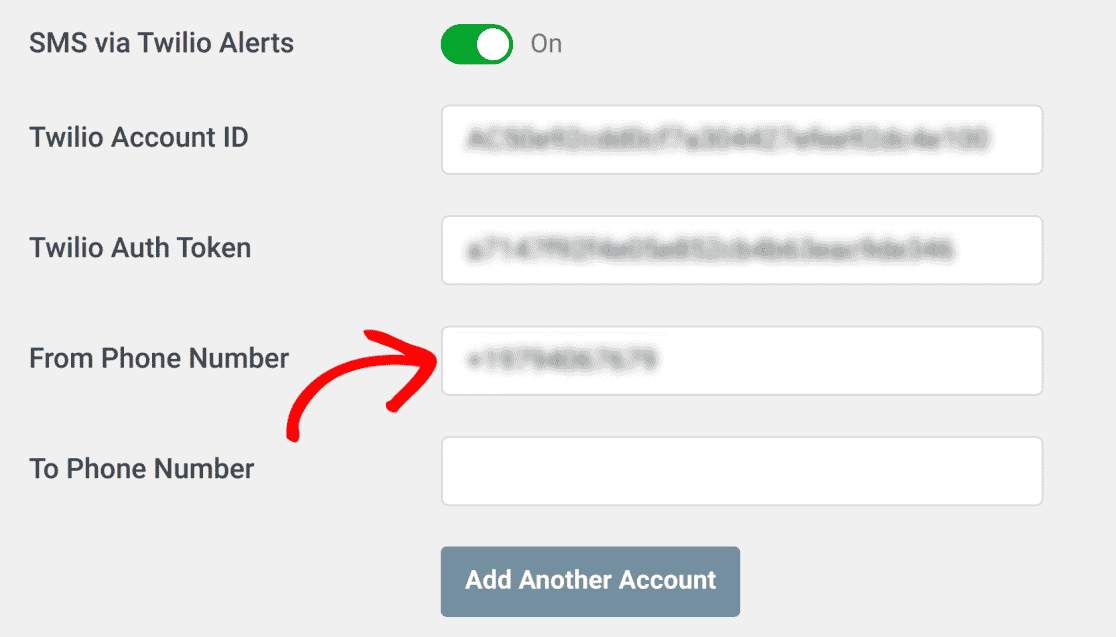
Finally, add the phone number that will receive alerts in the To Phone Number field.
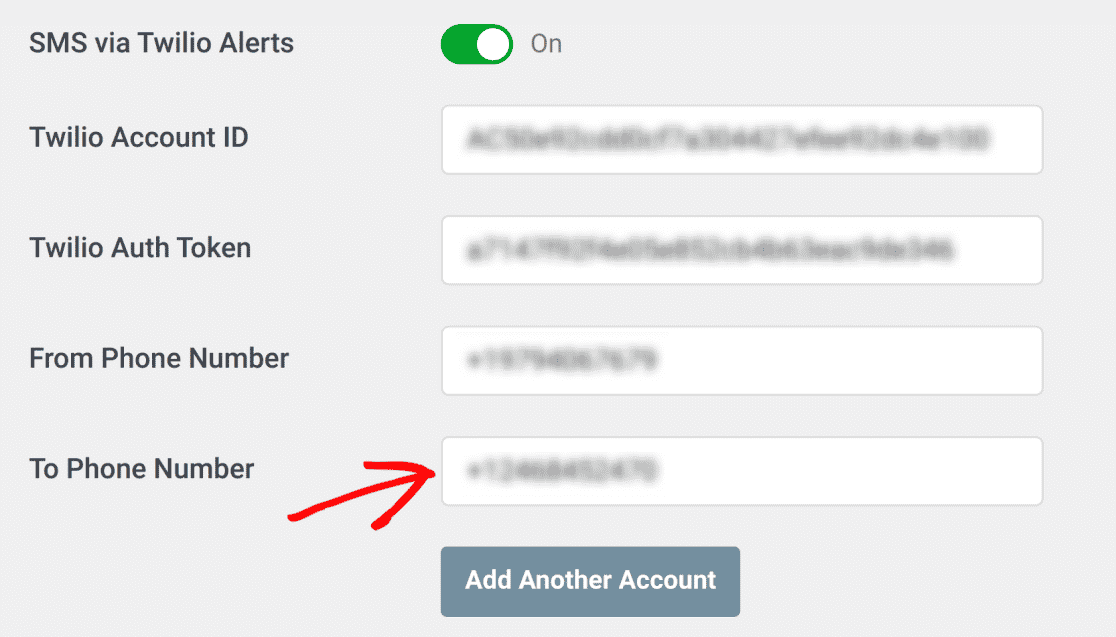
You can now continue to set up other integrations or save your settings.
Note: If you aren’t receiving Twilio SMS alerts after following the setup process, see our FAQ section to help get you on track.
Webhooks
With webhooks integration, your site can send notifications through any service with webhooks support. As with the Slack and Twilio integrations, there’s no limit on the number of webhooks integrations.
Note: Webhooks alerts are sending POST requests with JSON payloads.
Setting Up Webhooks Integration
First, to integrate Webhooks with your site, set the Webhook Alerts toggle to the on position.
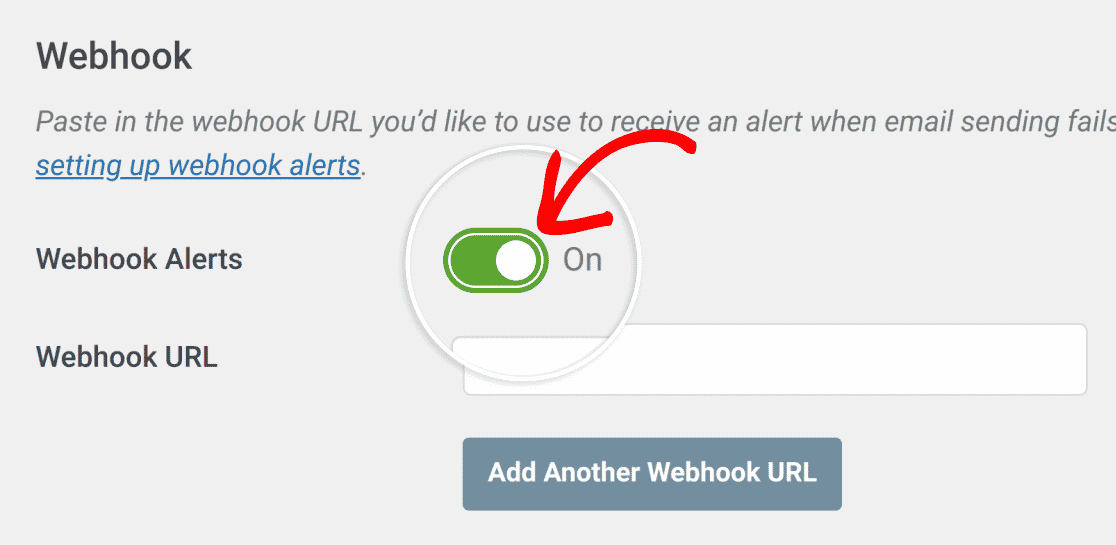
Next, copy the Webhook URL from the service you’d like to utilize and place it in the Webhook URL field.

If you’d like to add another webhook integration, click Add Another Webhook URL.

Another Webhook URL field will become available.
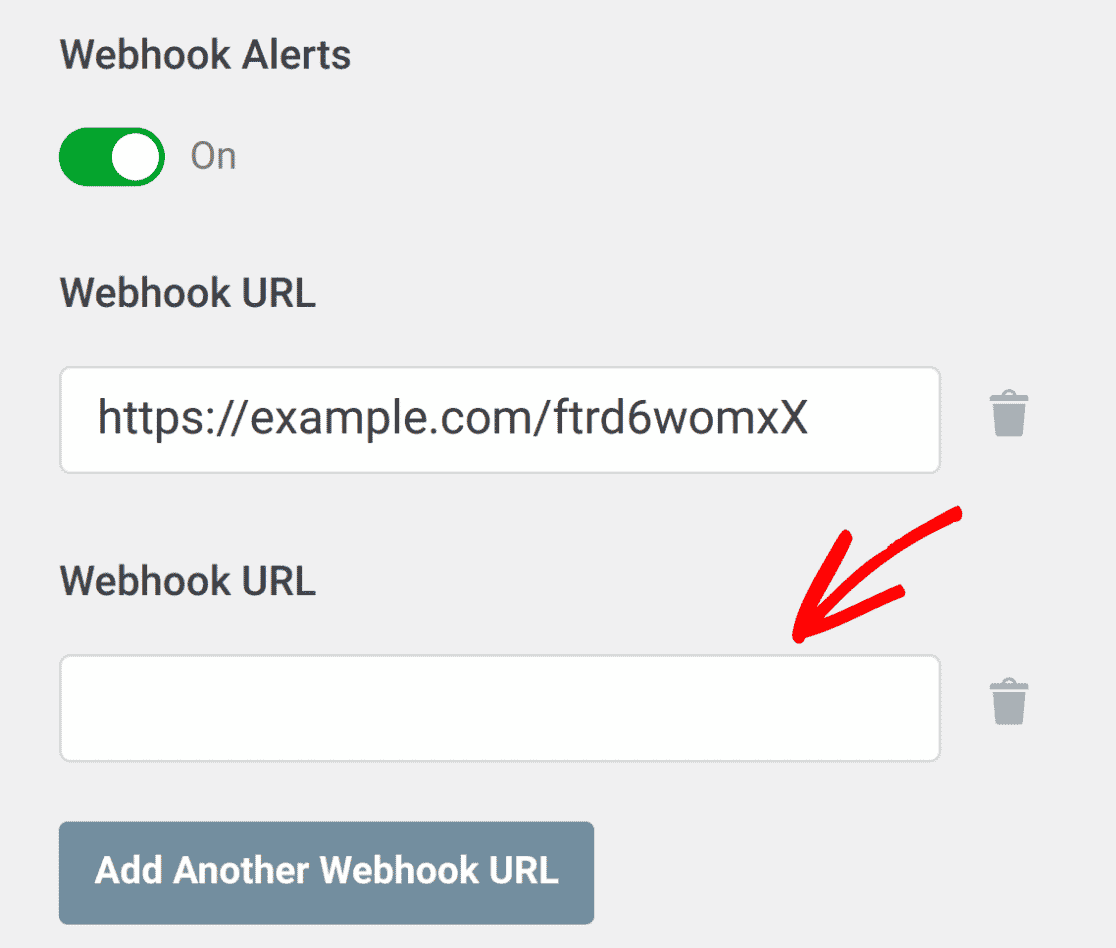
To add an additional webhook integration, paste the new webhook URL in the new Webhook URL field.
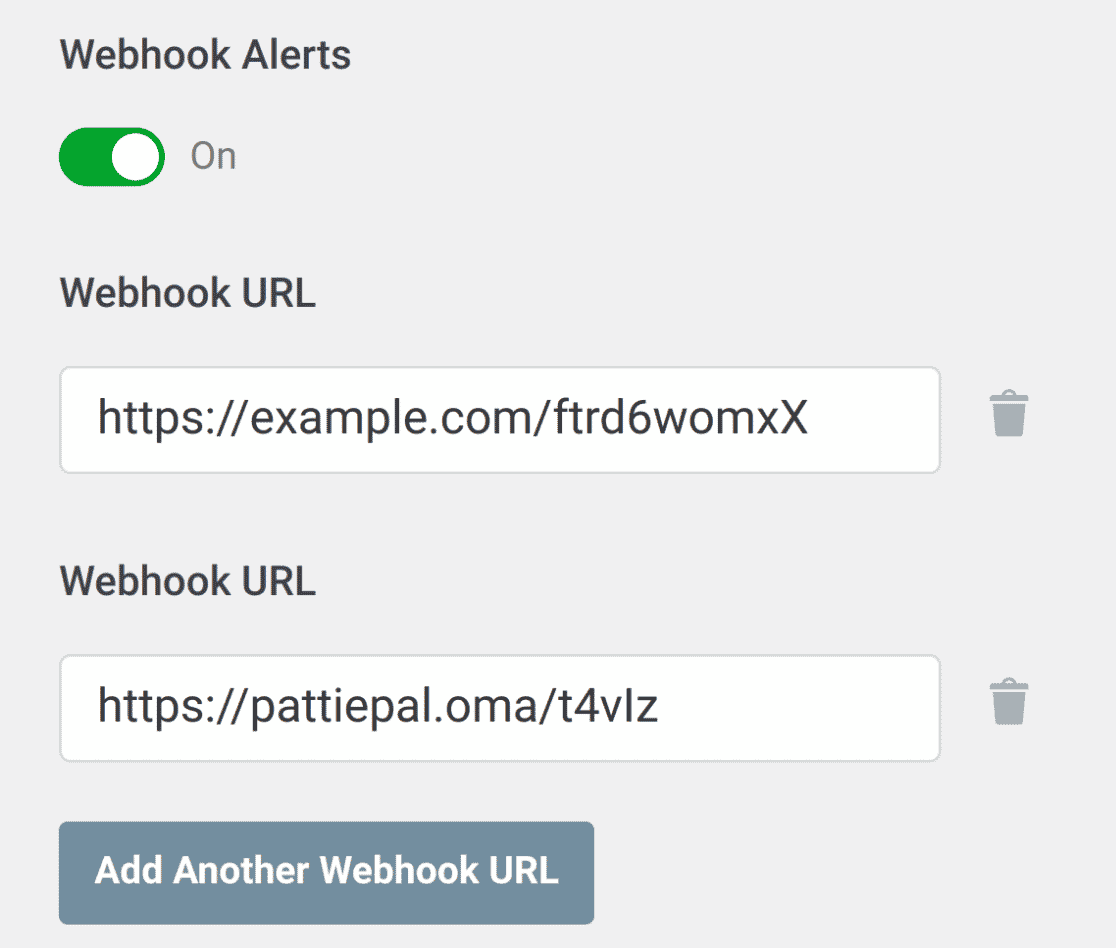
We’ve included the output of an example webhook alert below:
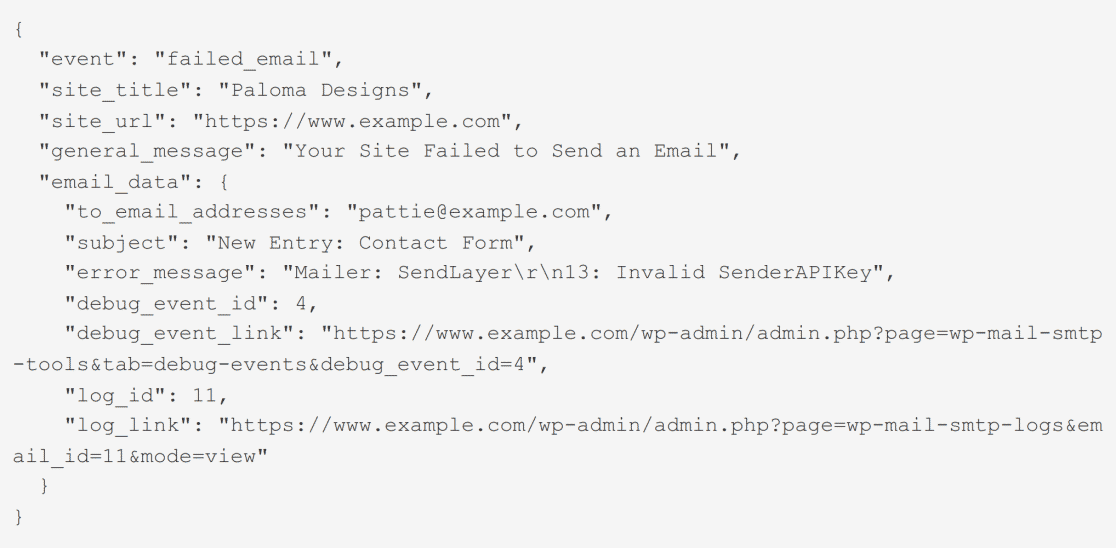
Once you’ve finished setting up your webhooks integrations, don’t forget to save your settings.
Push Notifications
With push notifications, you’ll be able to receive native alerts about your site’s email status from the browser you enabled the feature. You can enable it on any browser or device you’d like, including mobile devices.
WP Mail SMTP lets you set up an unlimited number of push notification alerts for your site.
Setting Up Push Notifications
Start by toggling the Push Notifications Alerts option to the ON position.

After that, click the Enable push notifications on this device button to proceed.
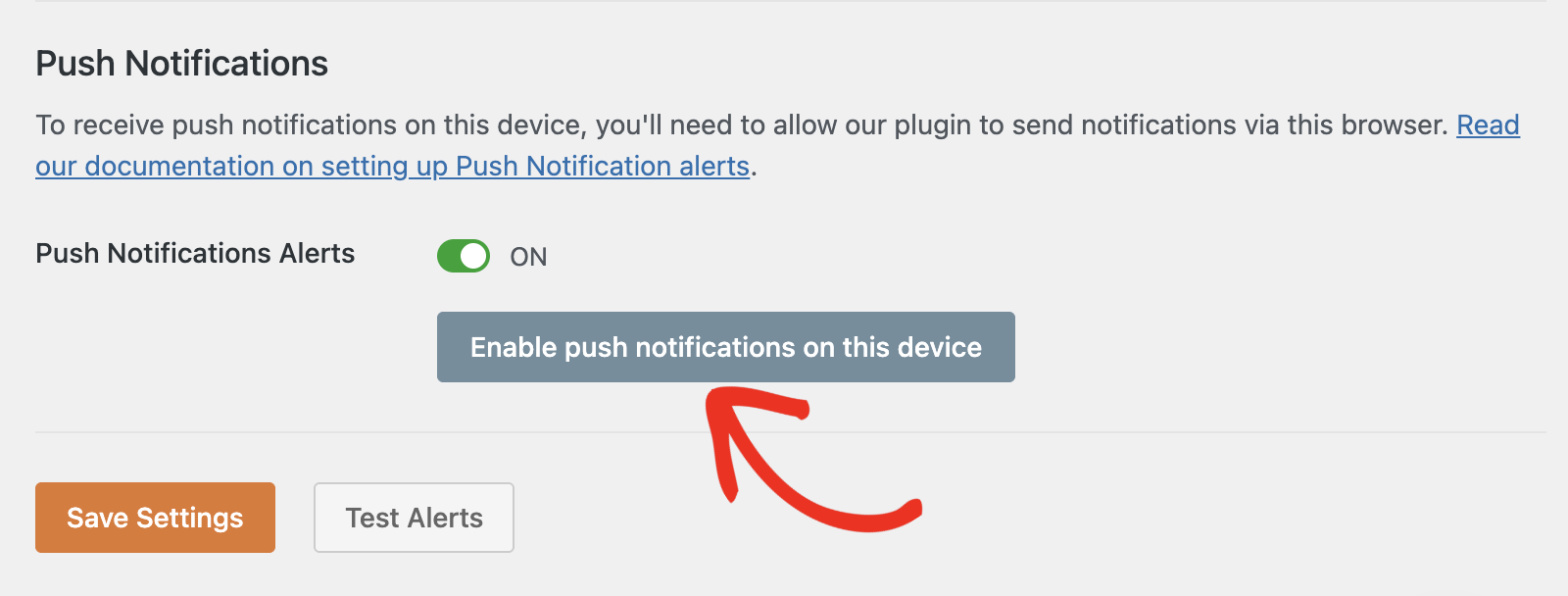
A pop-up will appear below the address bar on your browser. Go ahead and click Allow to enable push notifications for the browser.

Note: If you mistakenly choose Block, you won’t receive push alerts on that device. However, you can reset your selection. See our FAQ for more details.
You’ll see your browser’s user agent added as the value for the Connection Name field. You can update the value of this field to any name you’d like.
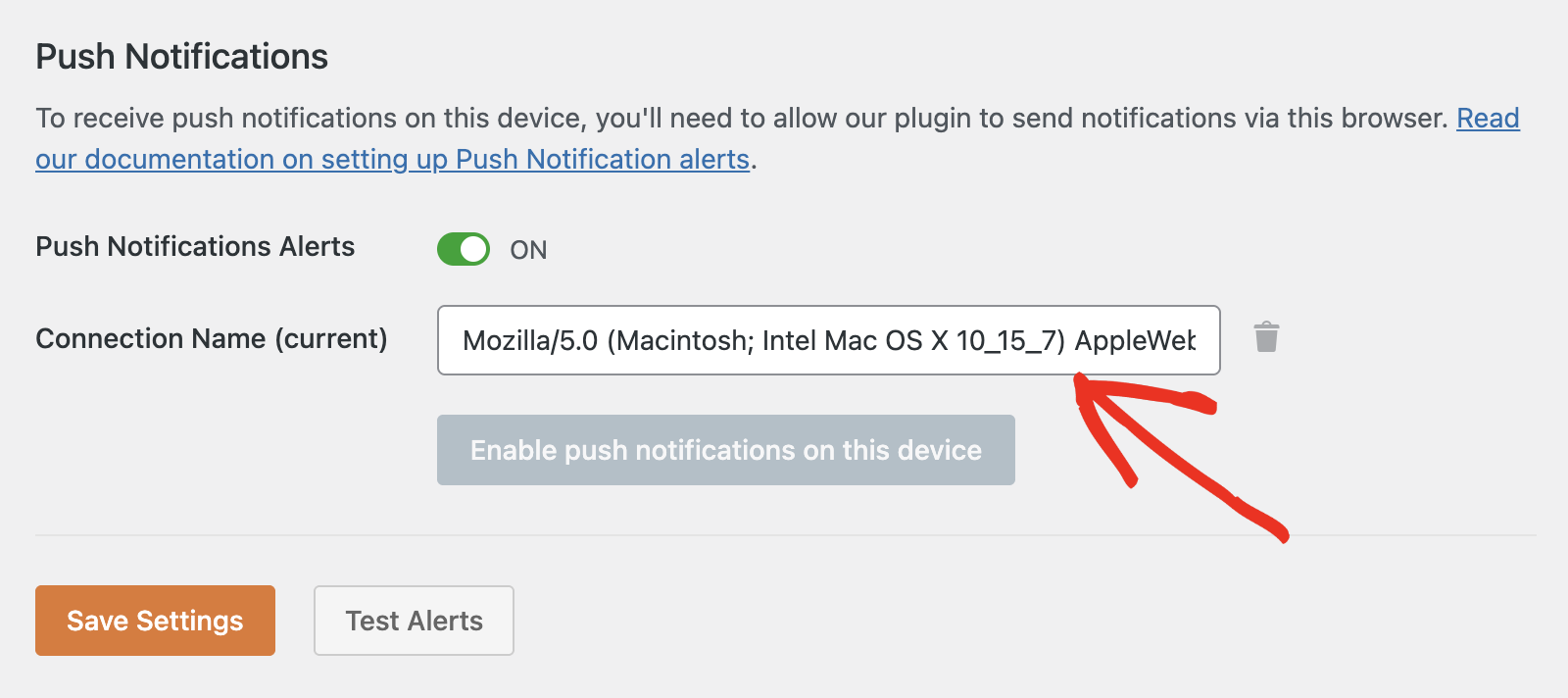
The Enable push notifications on this device button will be disabled after enabling push notifications on that device. However, you can add another push notification channel by accessing your site on a different browser or device.
On the new device, simply click Enable push notifications on this device and allow the browser access to your site.
iPhone Users
If you use an iPhone device to access the Alerts screen, you won’t be able to enable push notifications by default.
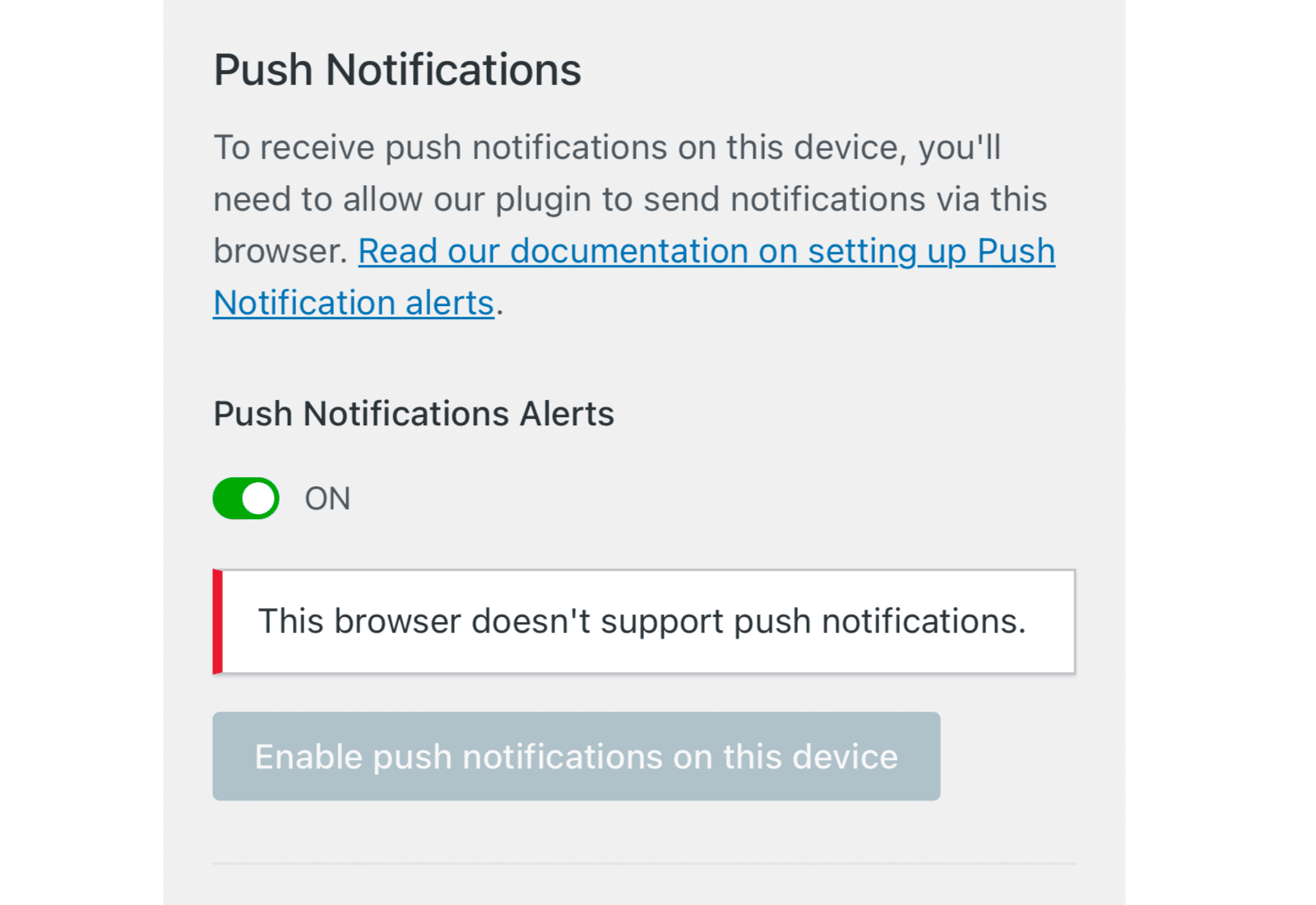
However, there is a straightforward workaround to fix the issue. For this, navigate to WP Mail SMTP » Settings and make sure to select the Alerts tab. Next, click on the Share icon on your iPhone browser.
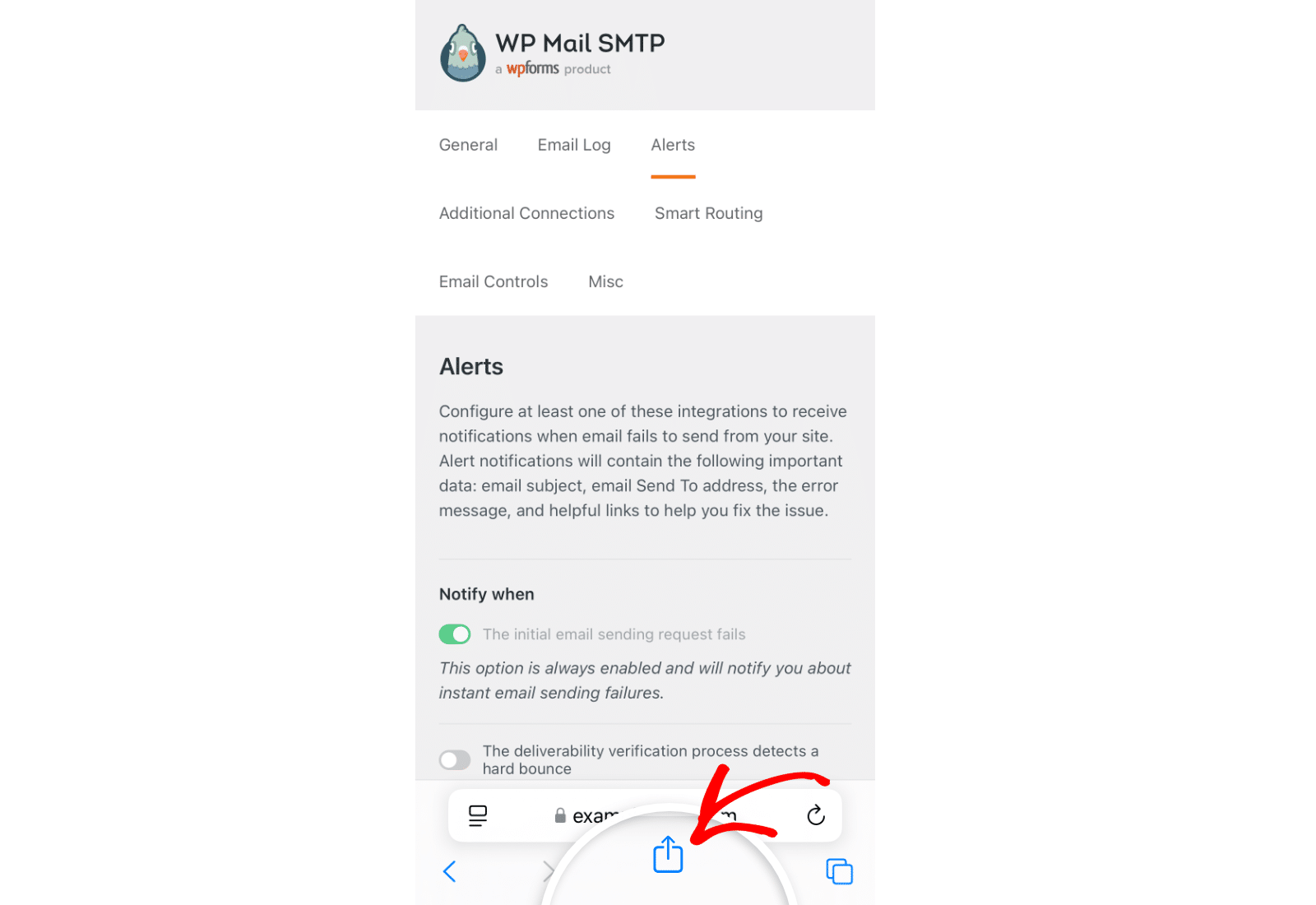
After that, scroll down and select Add to Home Screen.
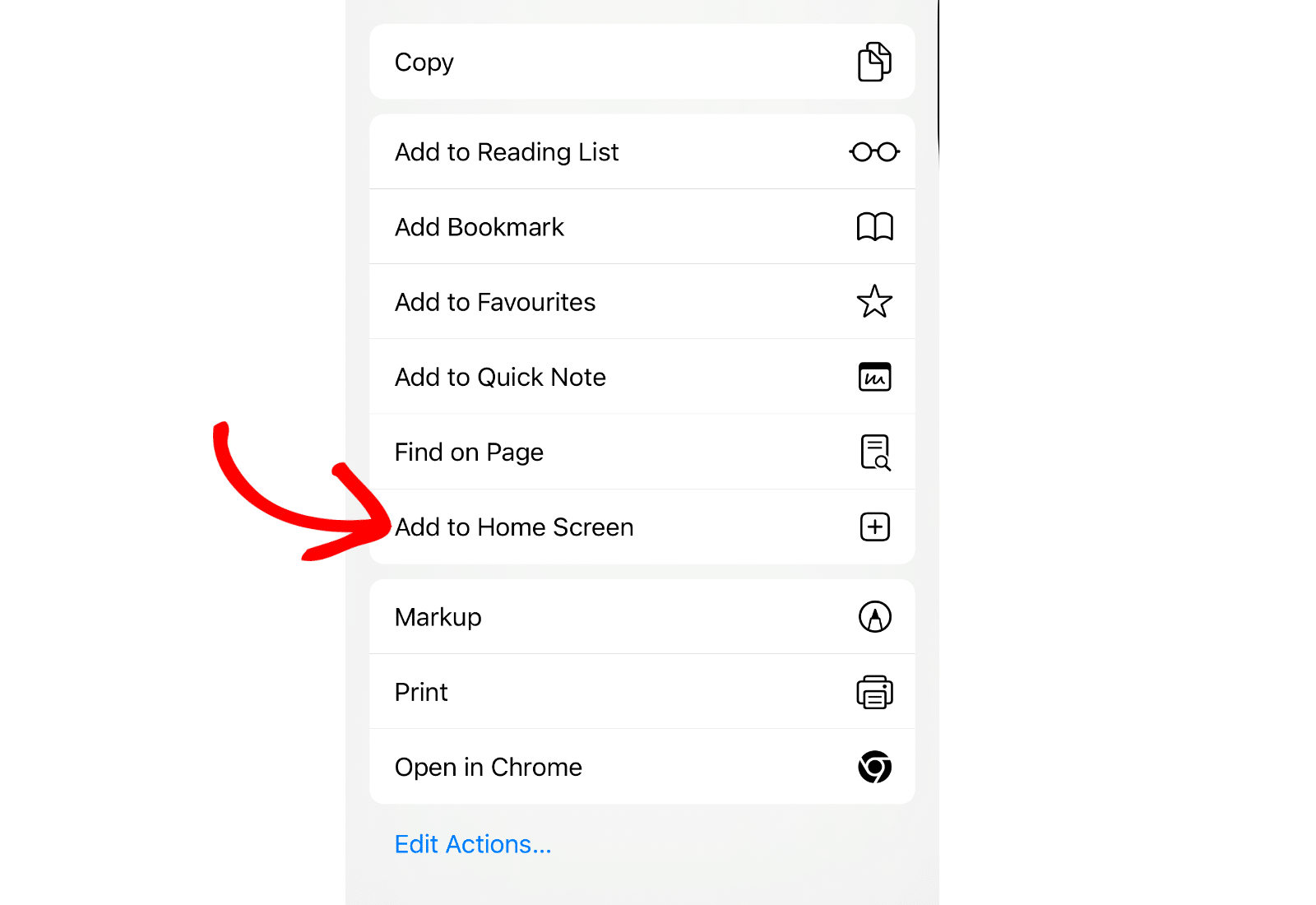
This will create an app icon on your home screen to access the Alerts settings page. Go ahead and click on the icon to open your site’s settings page.
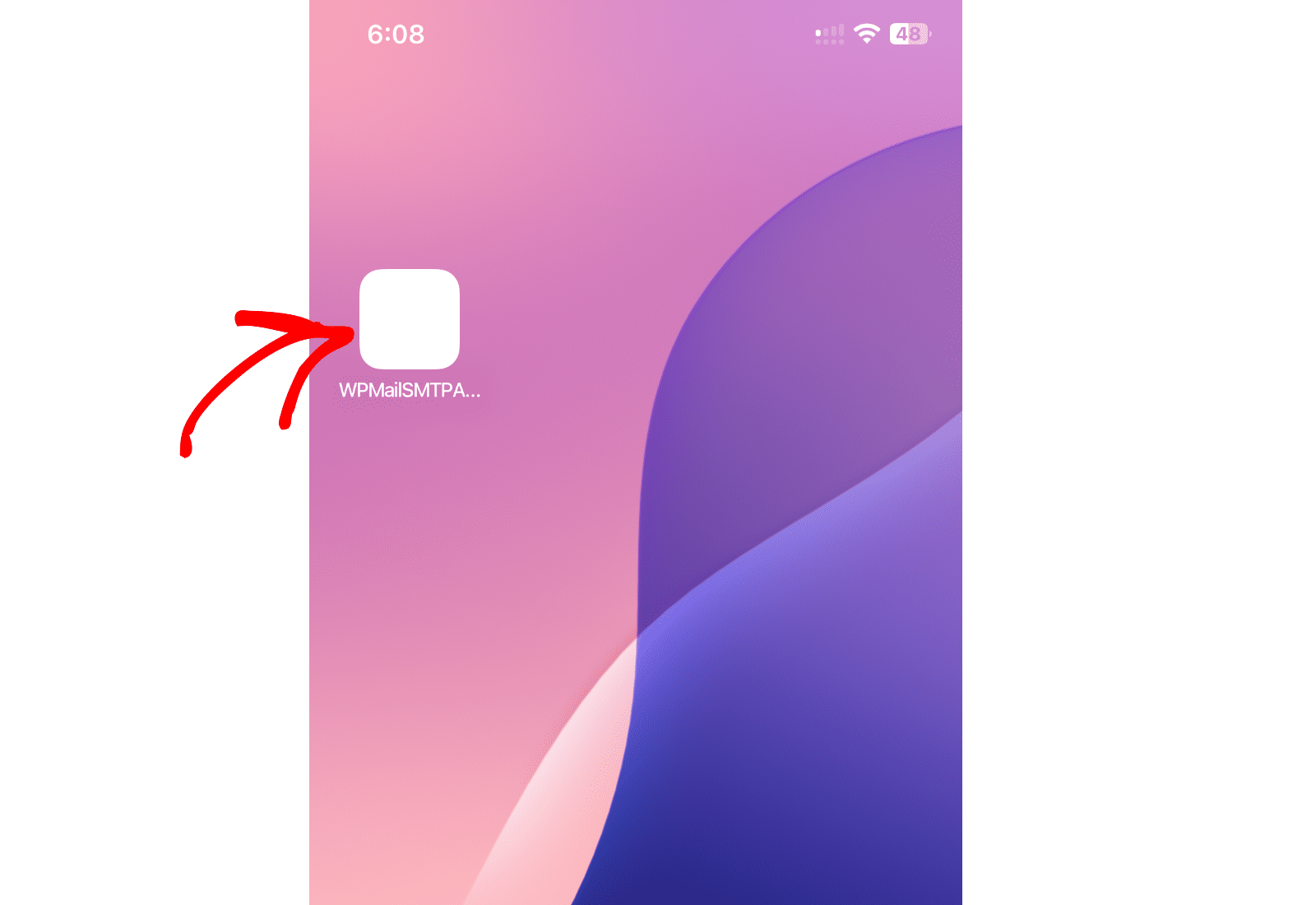
After clicking on it, you’ll be directed to the Alerts screen. From here, scroll to the Push Notifications section and click the Enable push notifications on this device button.
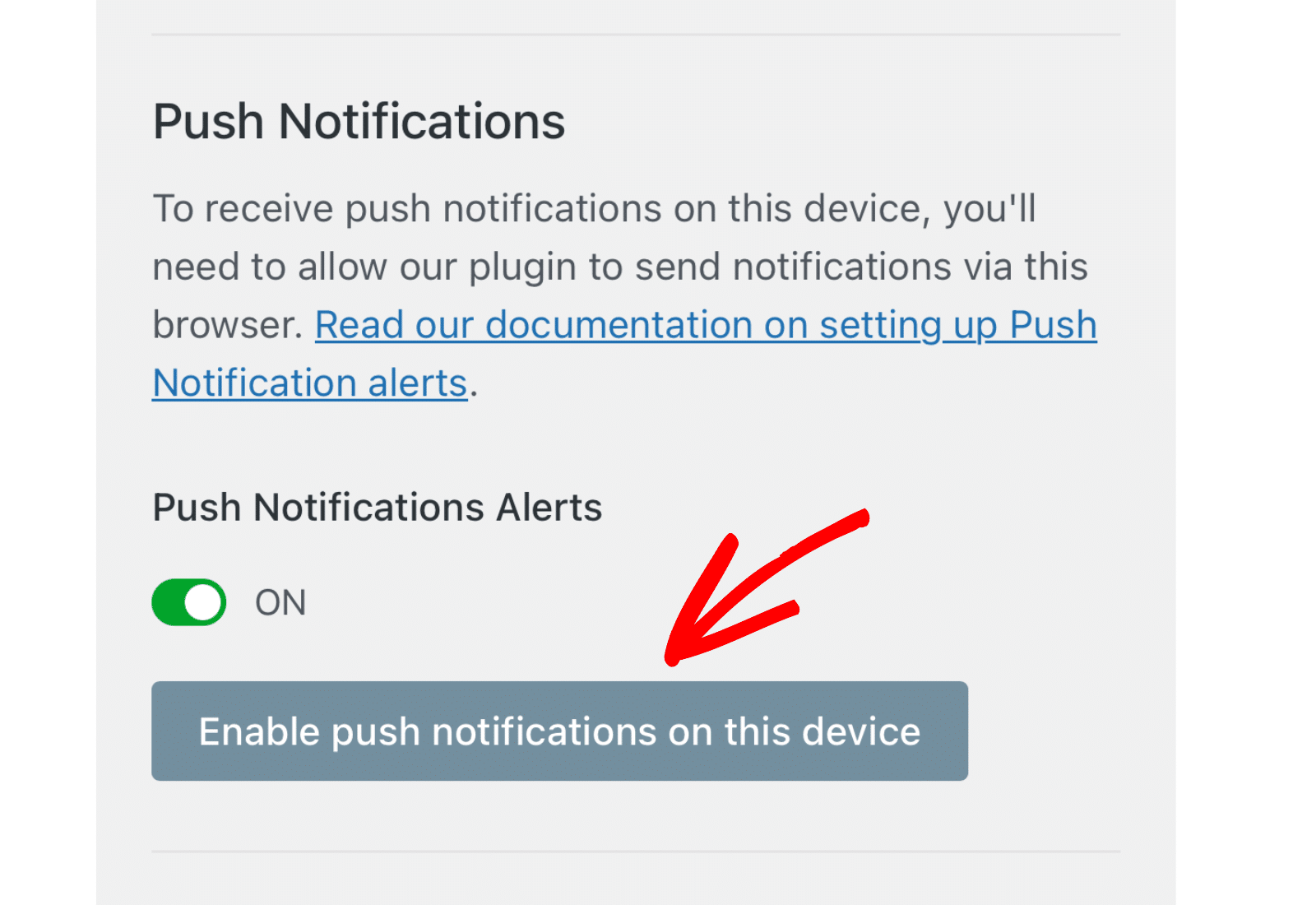
Then select Allow to enable it.
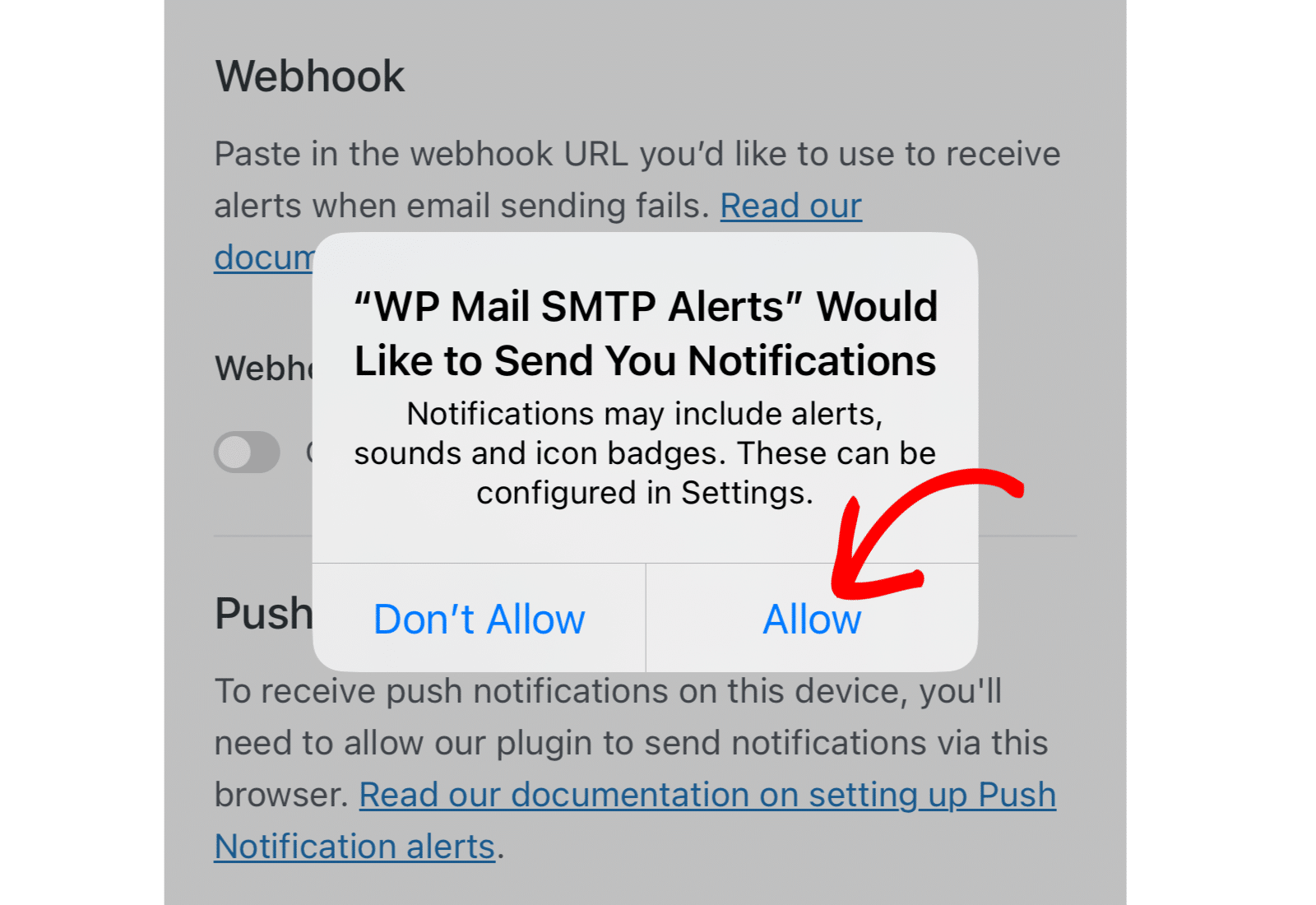
Once you’ve finished setting up your push notification integrations, don’t forget to save your settings.
If everything is properly configured, you’ll get a push notification on your browser whenever your site fails to send an email.
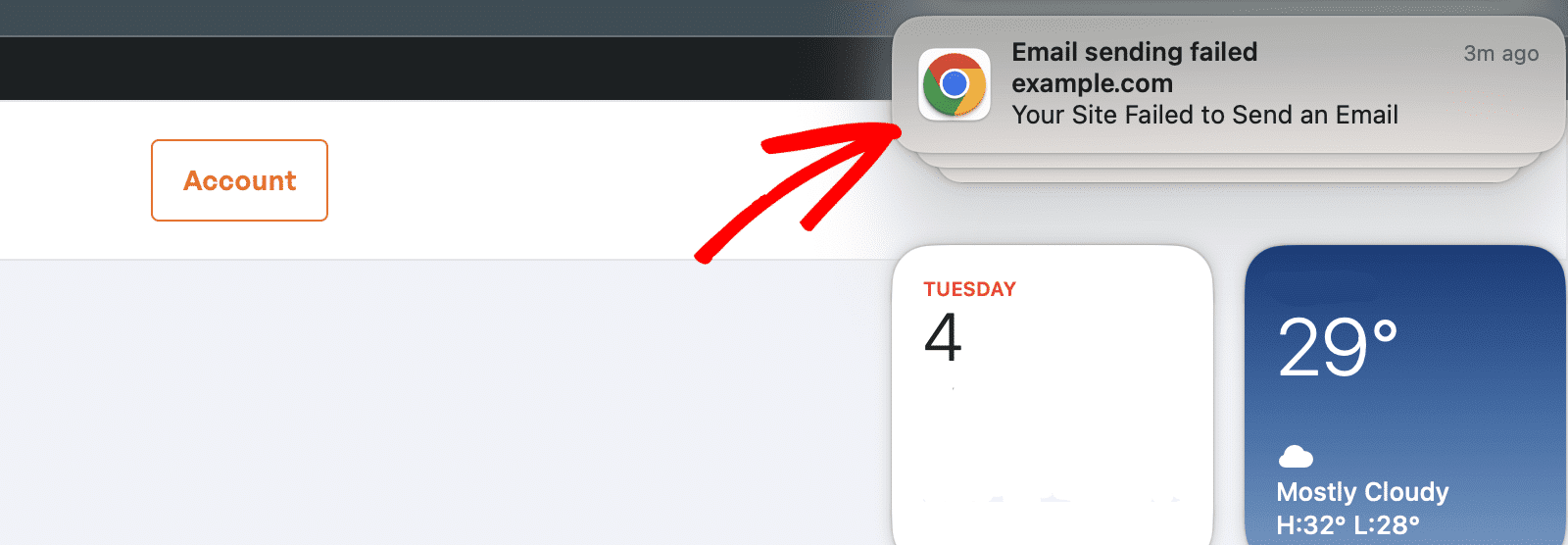
Here’s how it looks on mobile devices as well.
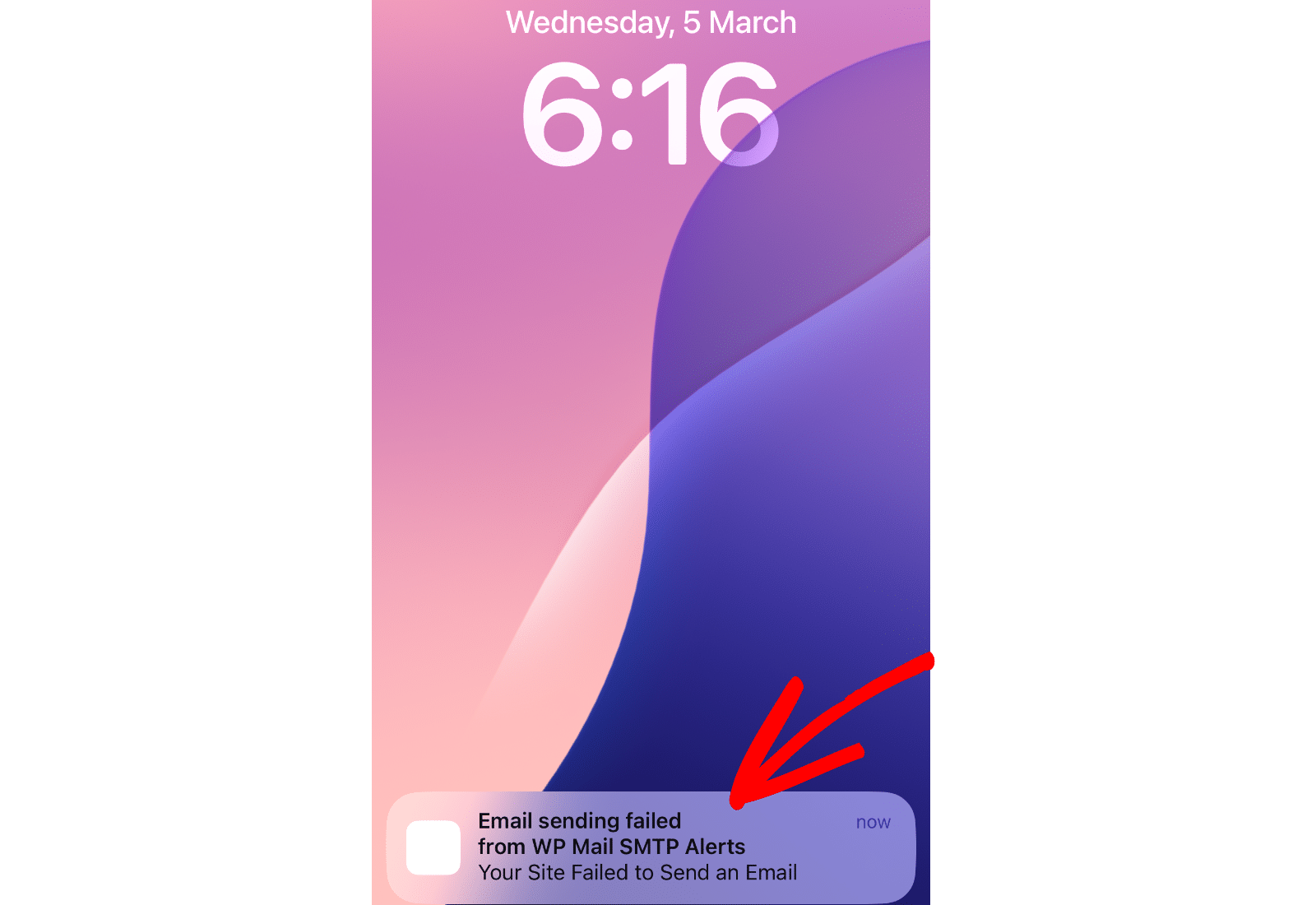
With our WhatsApp integration, you’ll be able to connect WP Mail SMTP to your WhatsApp account and receive notifications for failed emails on your website.
Similar to most of our other integrations, you can have as many WhatsApp configurations as needed. The WhatsApp integration uses Meta’s WhatsApp API and Webhook connection to facilitate communication.
Setting Up WhatsApp Alerts Integration
To use the WhatsApp integration, you’ll need to create a custom app on the Meta developer dashboard. Then, enable WhatsApp connection for the app you created and retrieve the authentication details.
Start by toggling the WhatsApp Alerts option to the ON position.
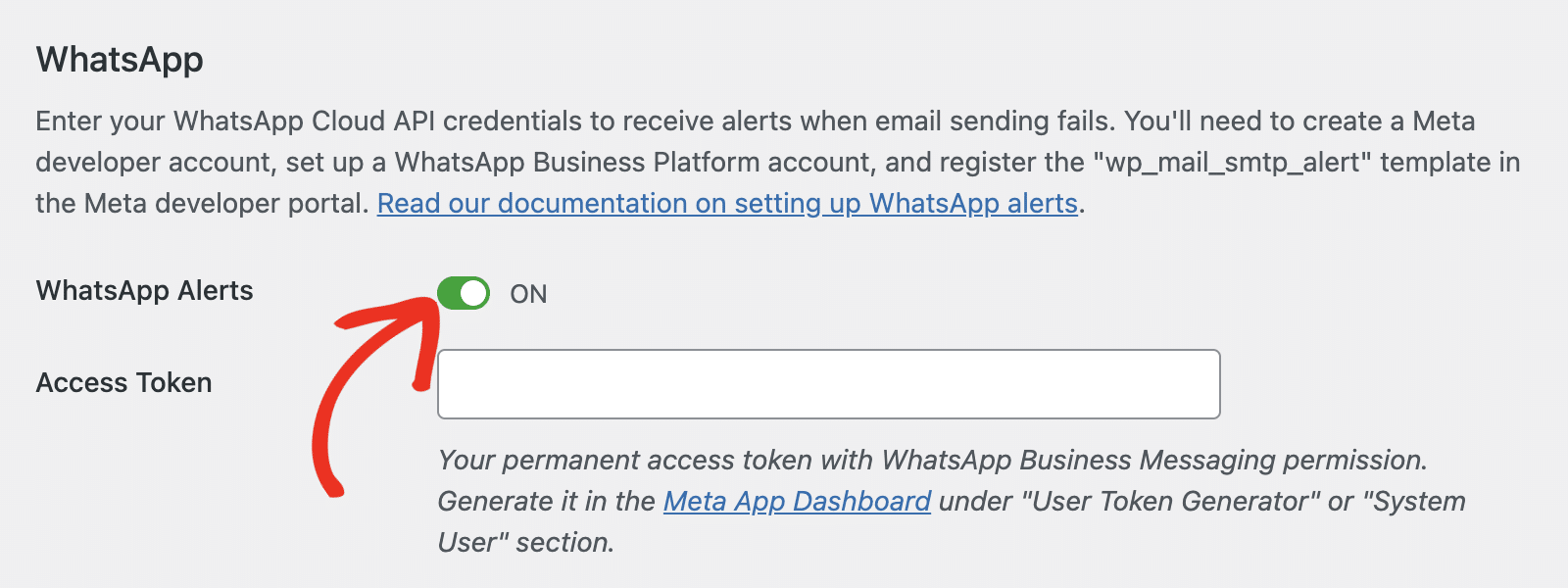
Additional options will appear after enabling WhatsApp Alerts. You’ll need to retrieve your Access Token, WhatsApp Business ID, and Phone Number ID from Meta developer dashboard. Here’s how to get the required details. You can leave this browser tab open as we’ll return to it later.
Creating an App
First, log in to your Meta developer account or create a new one if you already have one.
Once you’re logged in, go to the My Apps page and click the Create App button.

After that, enter a name for your app in the App name field. Then, enter your email in the App contact email field and click Next.

Select the Other option in the Use cases section and click Next to proceed.
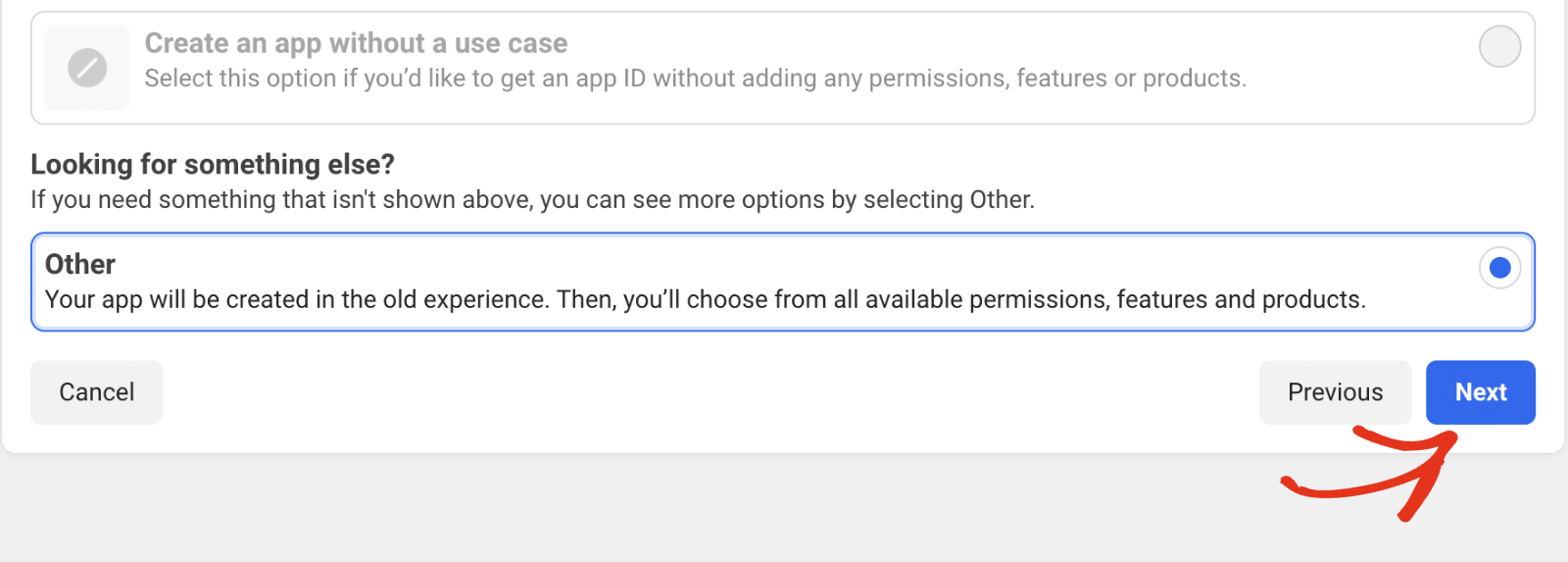
After that, select Business as the app type and click Next.
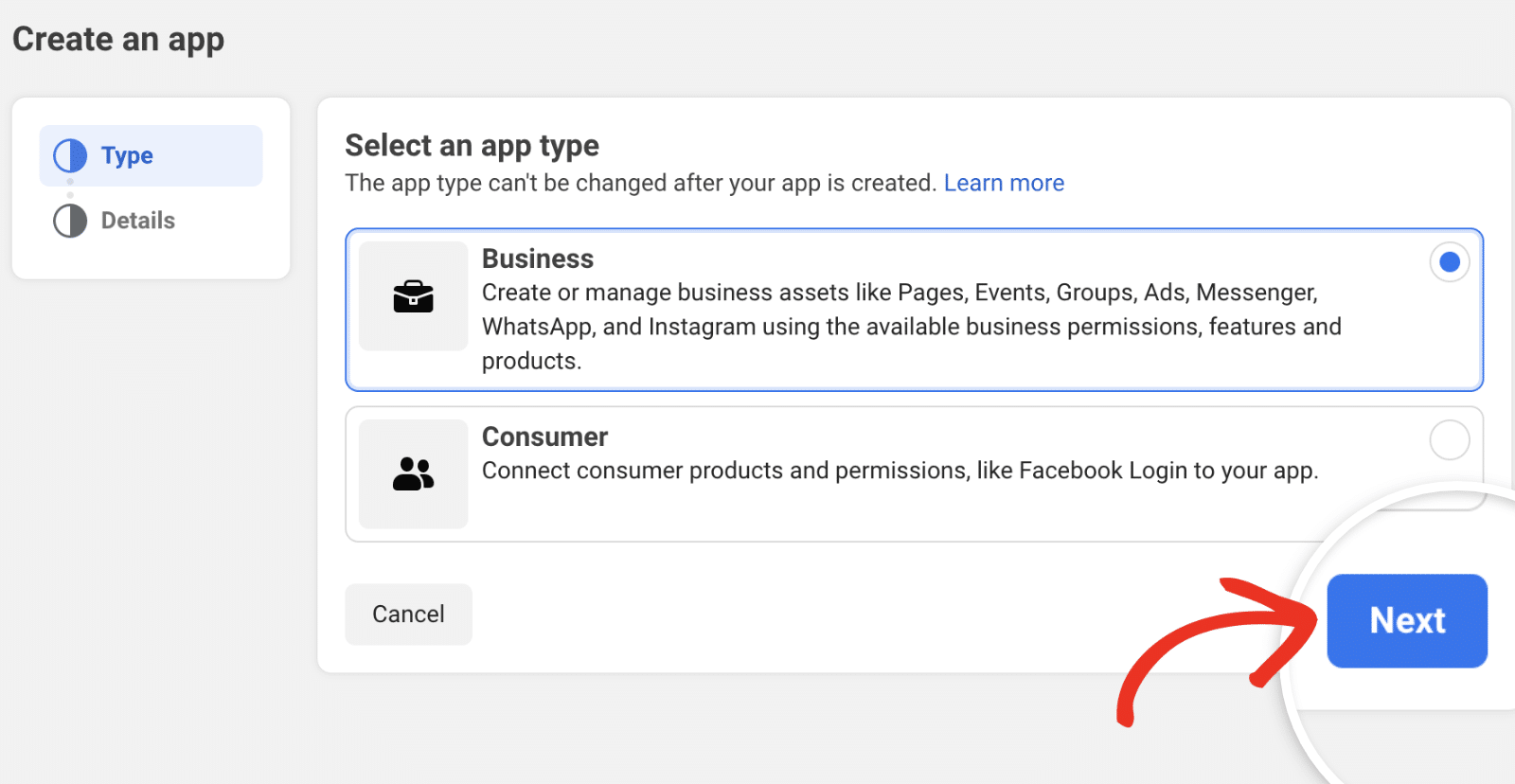
Finally, confirm your app details and click Create app to complete the app creation process.
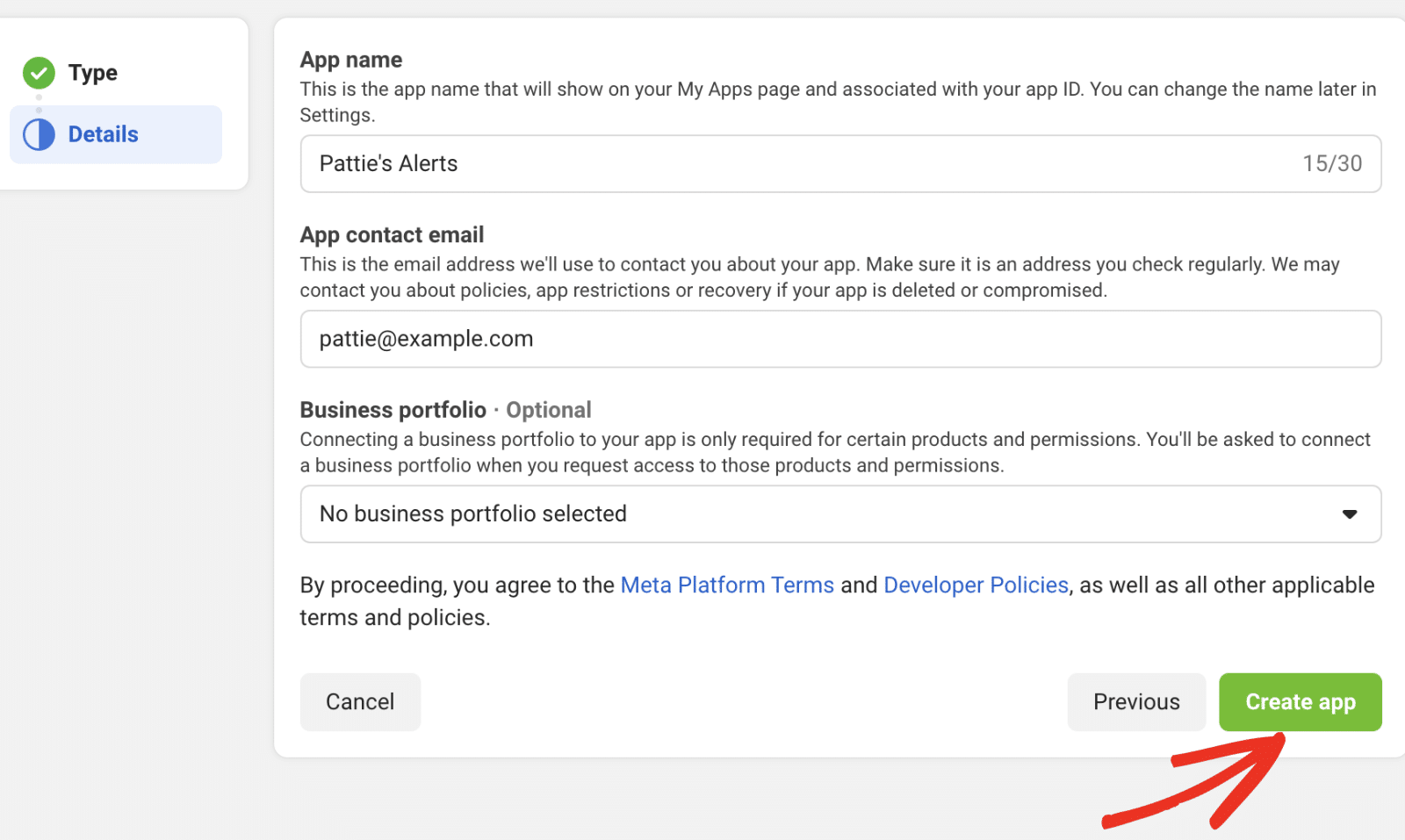
This will direct you to the app dashboard. From there, scroll to the Add products to your app section and click Set up under the WhatsApp section.
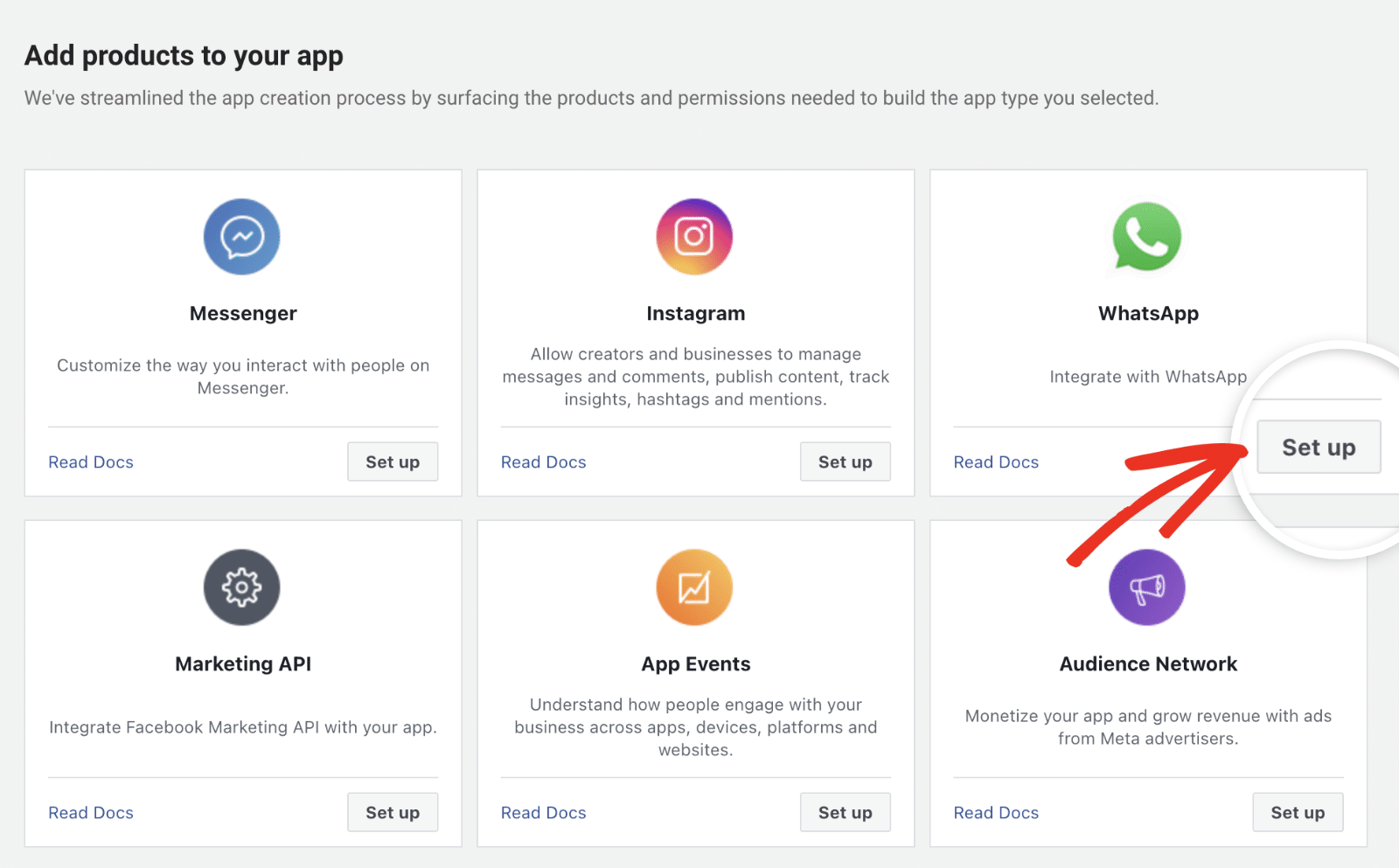
WhatsApp Business API requires you to select a business profile to associate your app with. Go ahead and choose a profile from the Select a business portfolio dropdown.
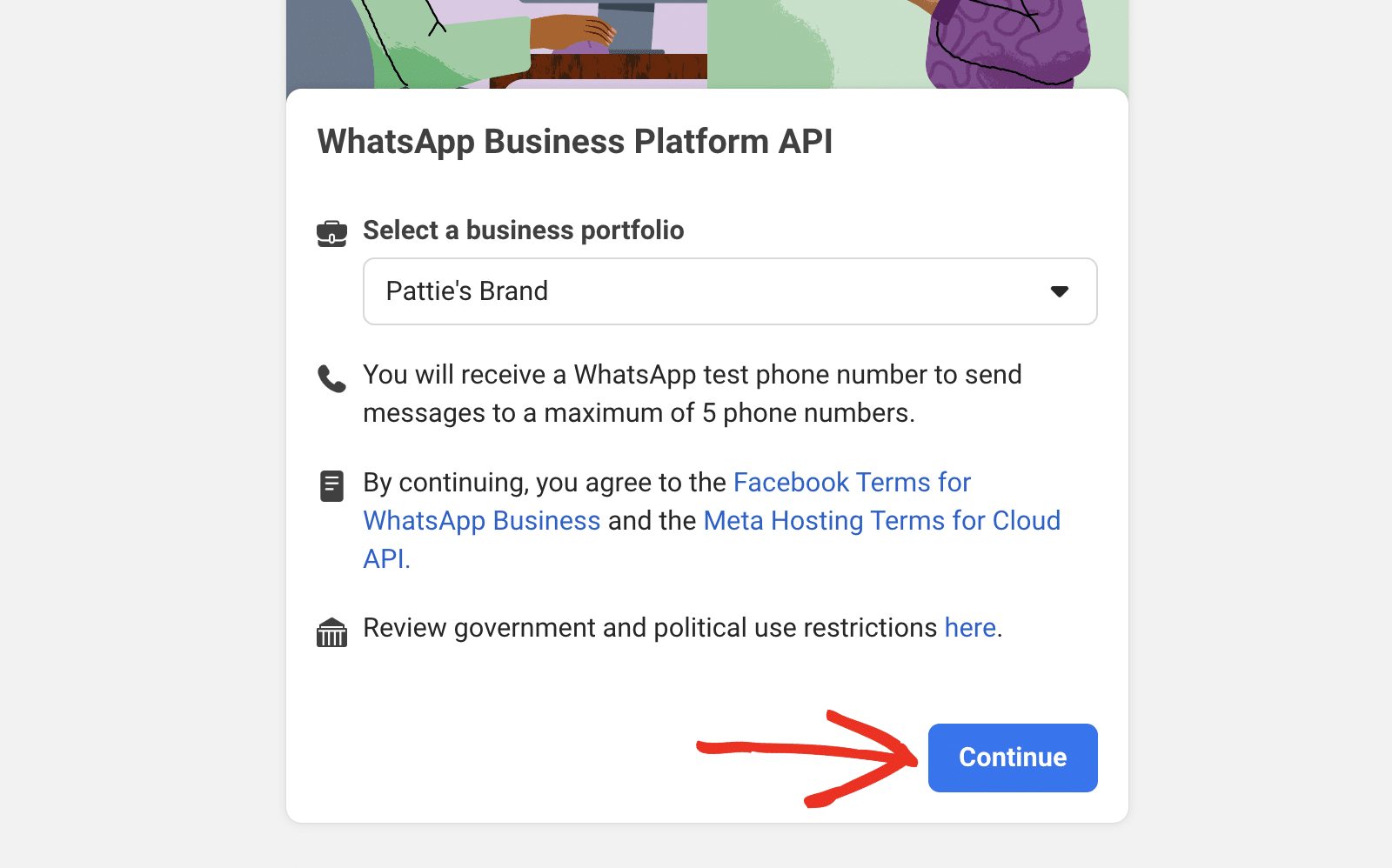
If you don’t have a business profile, you’ll be prompted to create one before proceeding. Click Continue to proceed.
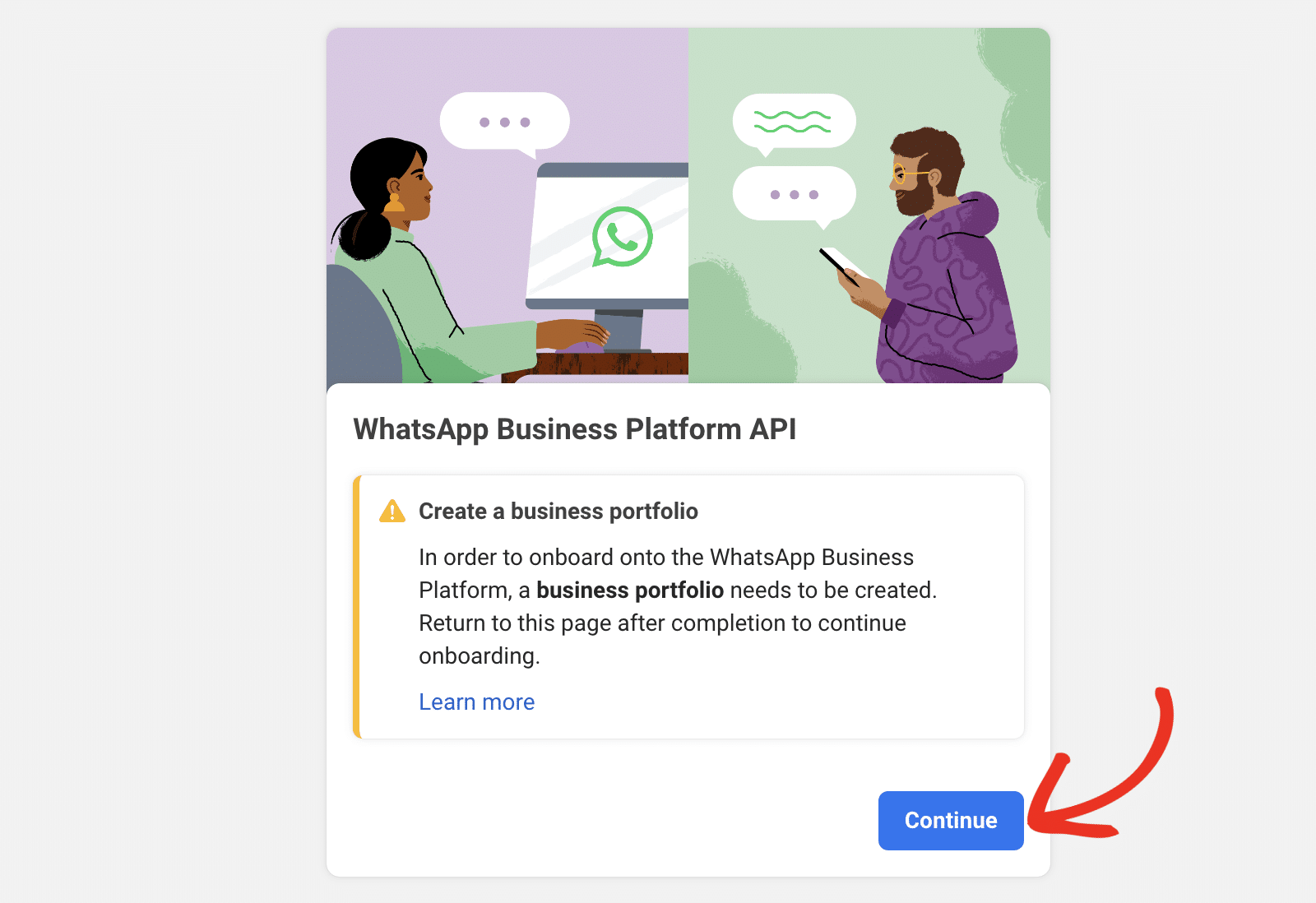
Then, fill out the new business portfolio registration form and click Submit.
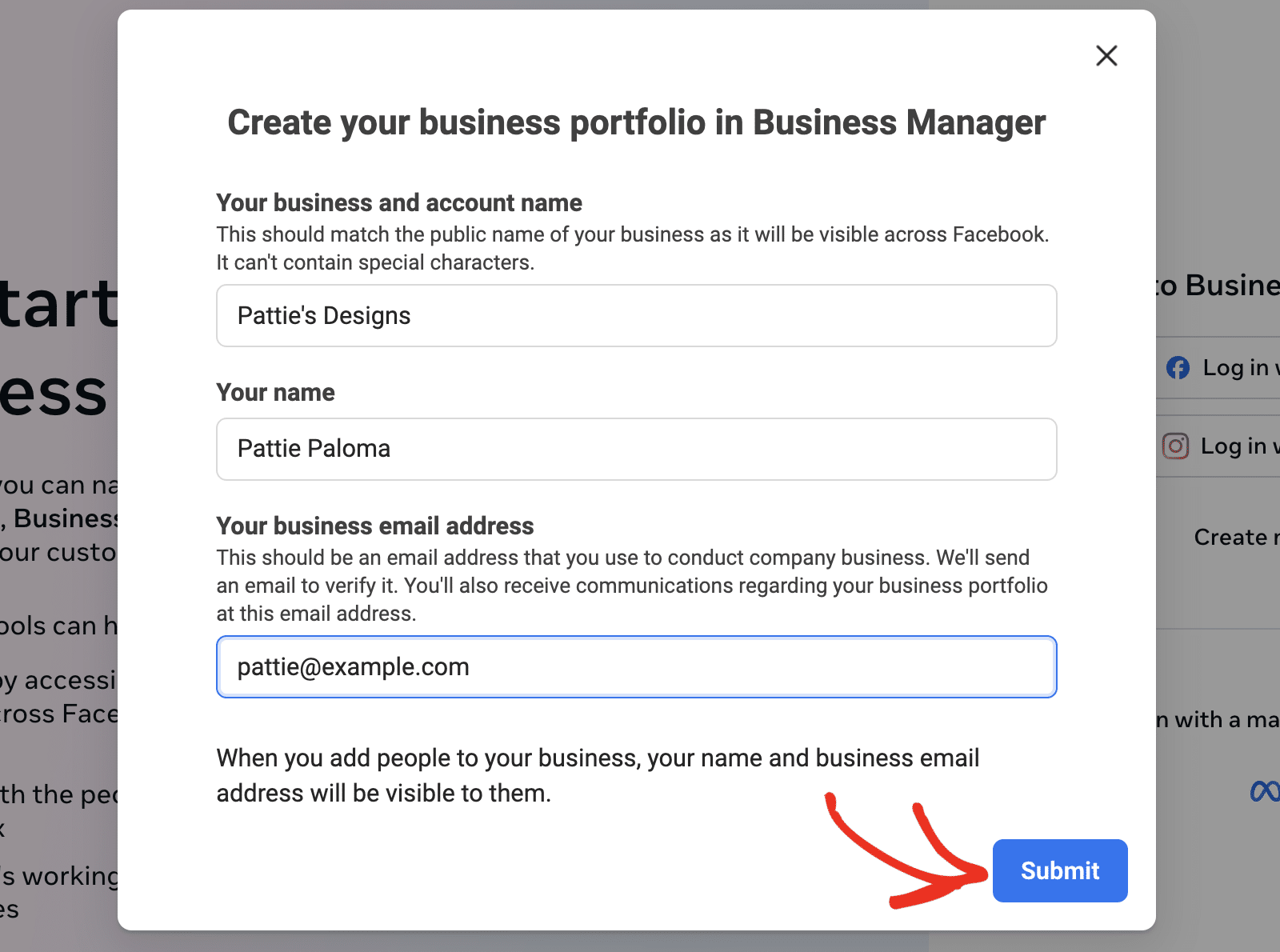
After connecting your business portfolio, scroll to the My products section and click Settings under WhatsApp.
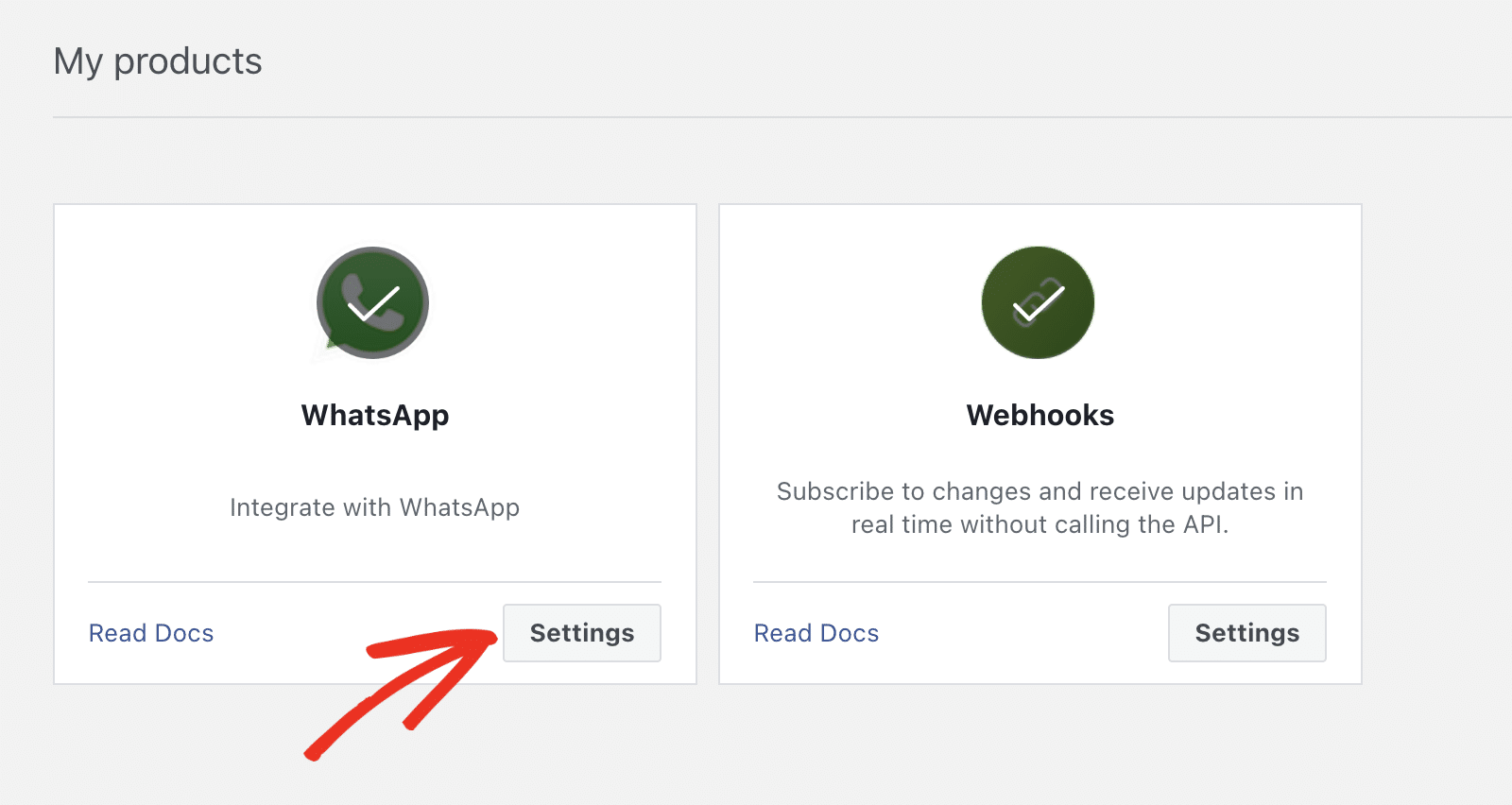
You’ll be directed to the WhatsApp API configuration page. To proceed, navigate to WhatsApp » API Setup.
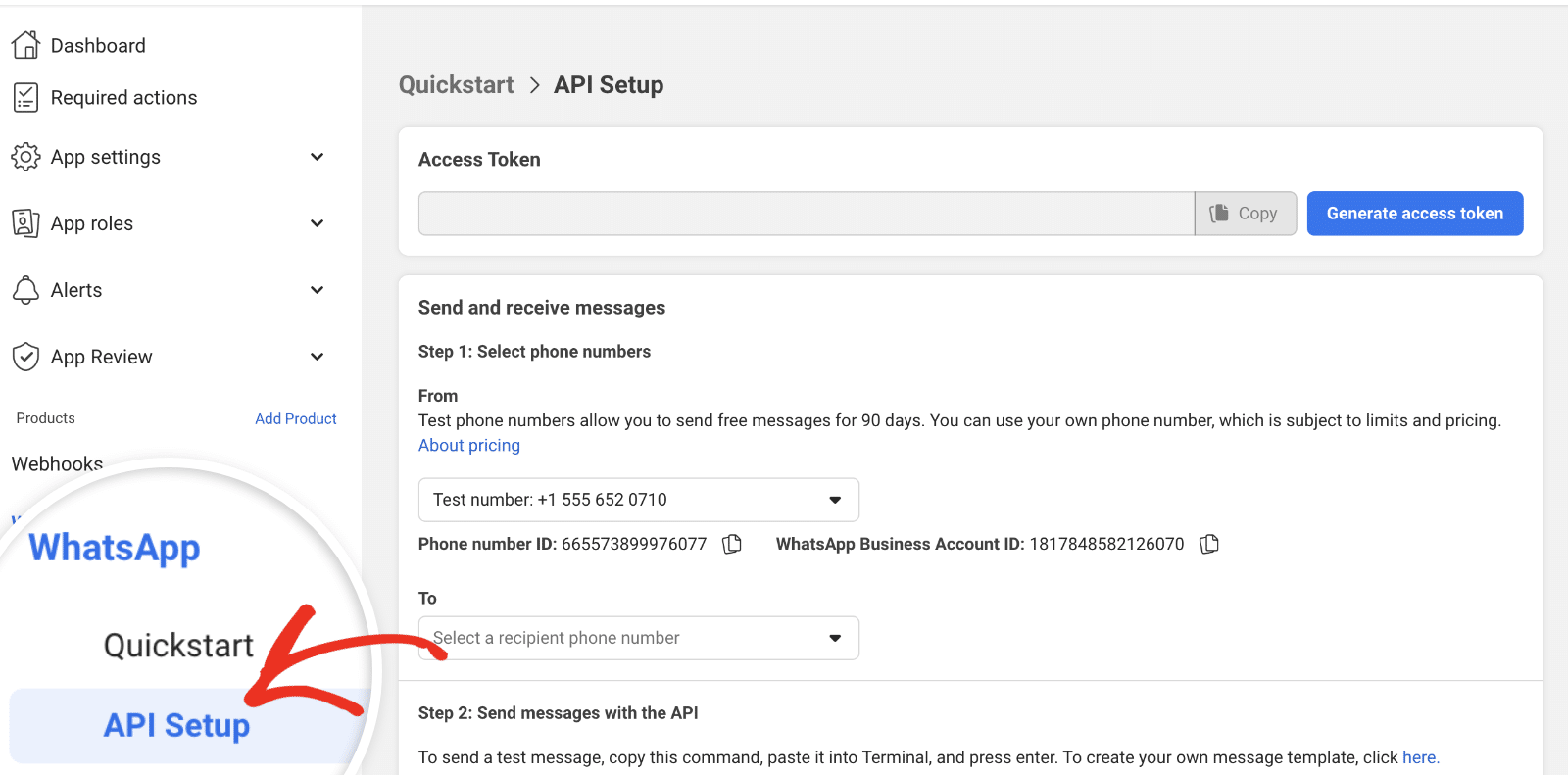
WhatsApp will generate test credentials for your integration. You can use the test credentials to connect WhatsApp to your WordPress site.
First, copy the WhatsApp Business Account ID from the Meta developer site.
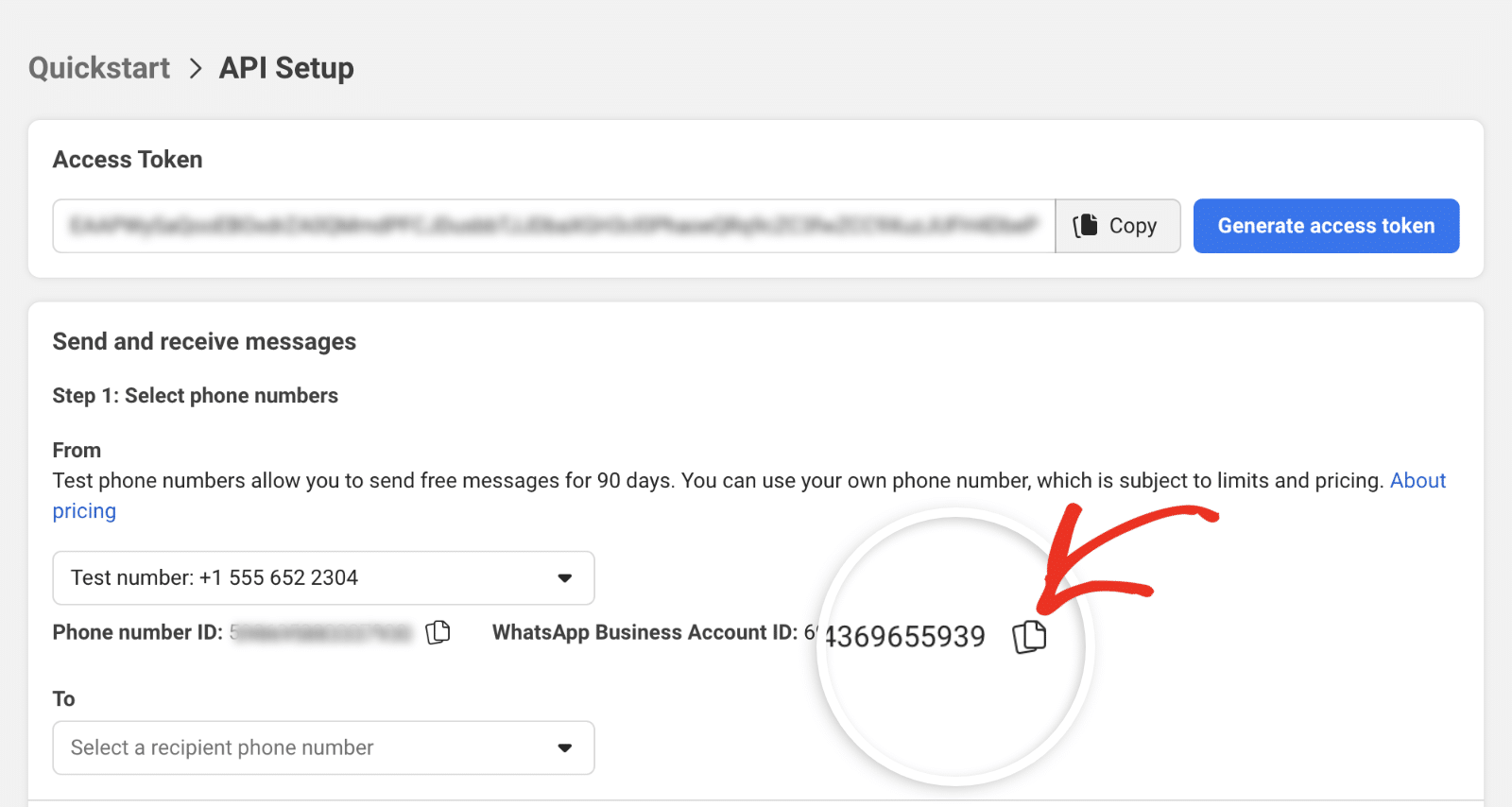
Then return to your WP Mail SMTP settings page and paste it in the WhatsApp Business Account ID field.

After that, return to the Meta developer site and copy the Phone Number ID.
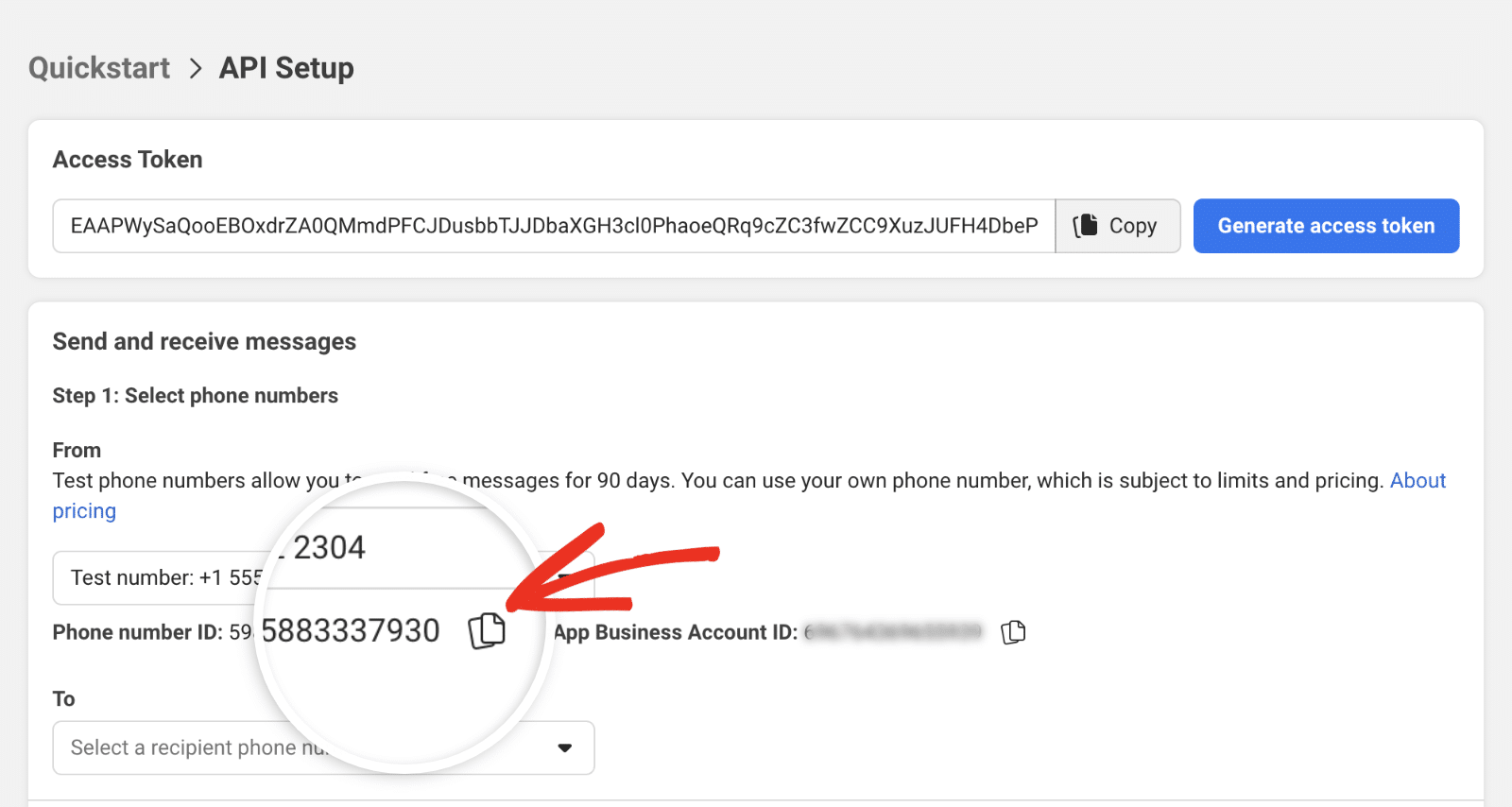
Next, return to the WP Mail SMTP settings page and paste the value in the Phone Number ID field.

After that, enter the WhatsApp number you’d like to receive the alert at in the To Phone Number field.

Note: You’ll need to register this number in the Meta app before you can receive WhatsApp alerts.
Adding the Recipient’s Phone Number
To register the recipient’s phone number, go to WhatsApp » API Setup from your Meta app dashboard. Then click the To dropdown and select Manage phone number list.

In the overlay that appears, make sure to select the correct country code for the phone number you wish to add.
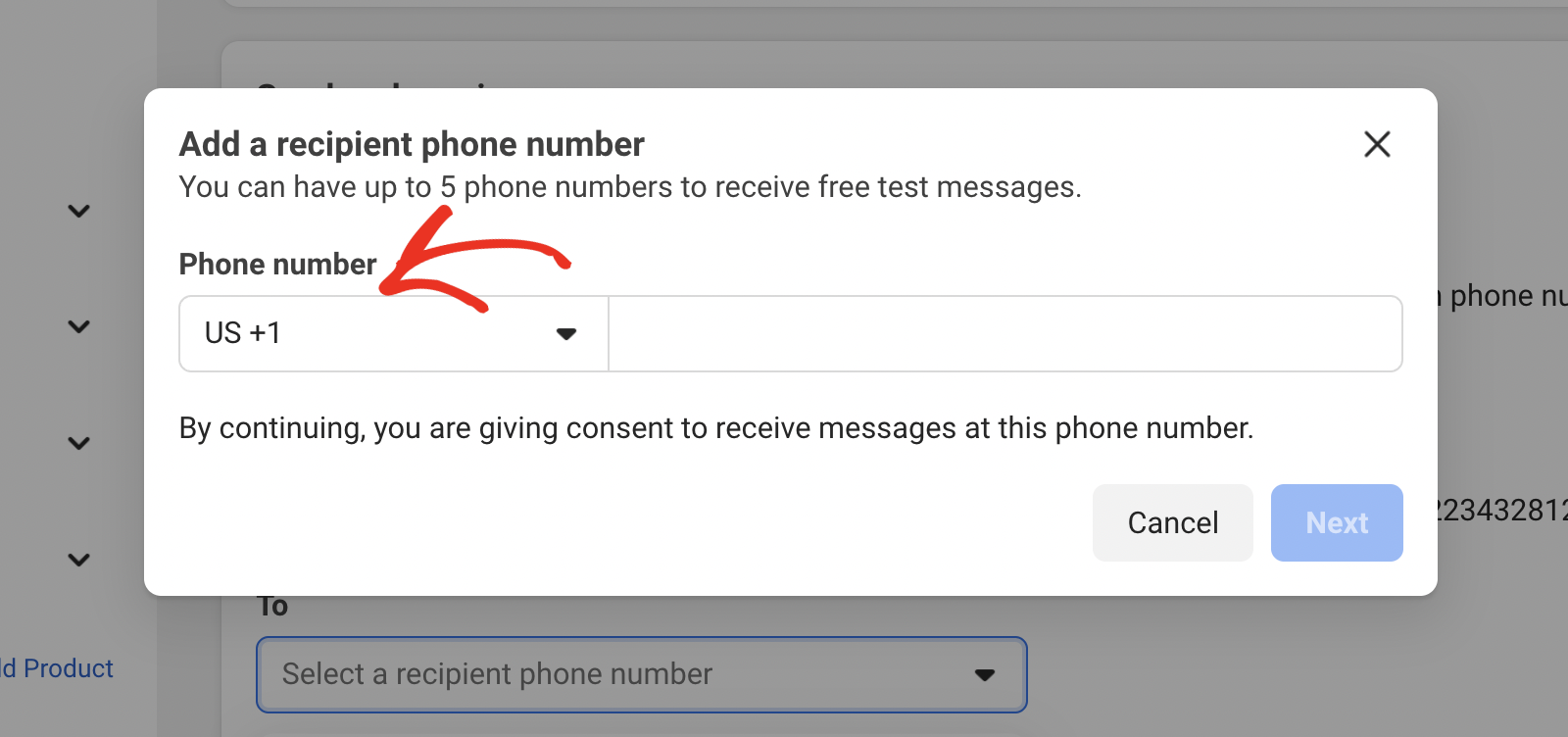
After that, enter the phone number and click Next.
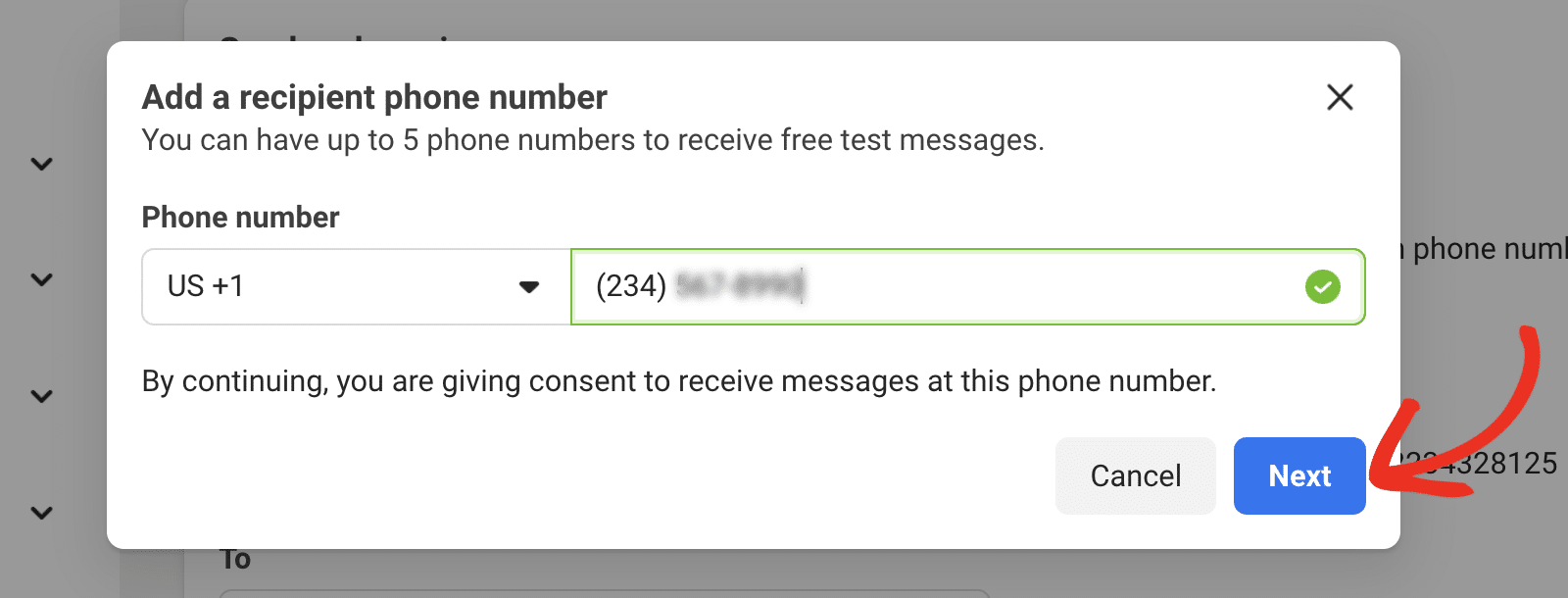
You’ll receive a one-time verification code via WhatsApp. Go ahead and enter the 5-digit code and click Next to register the number.
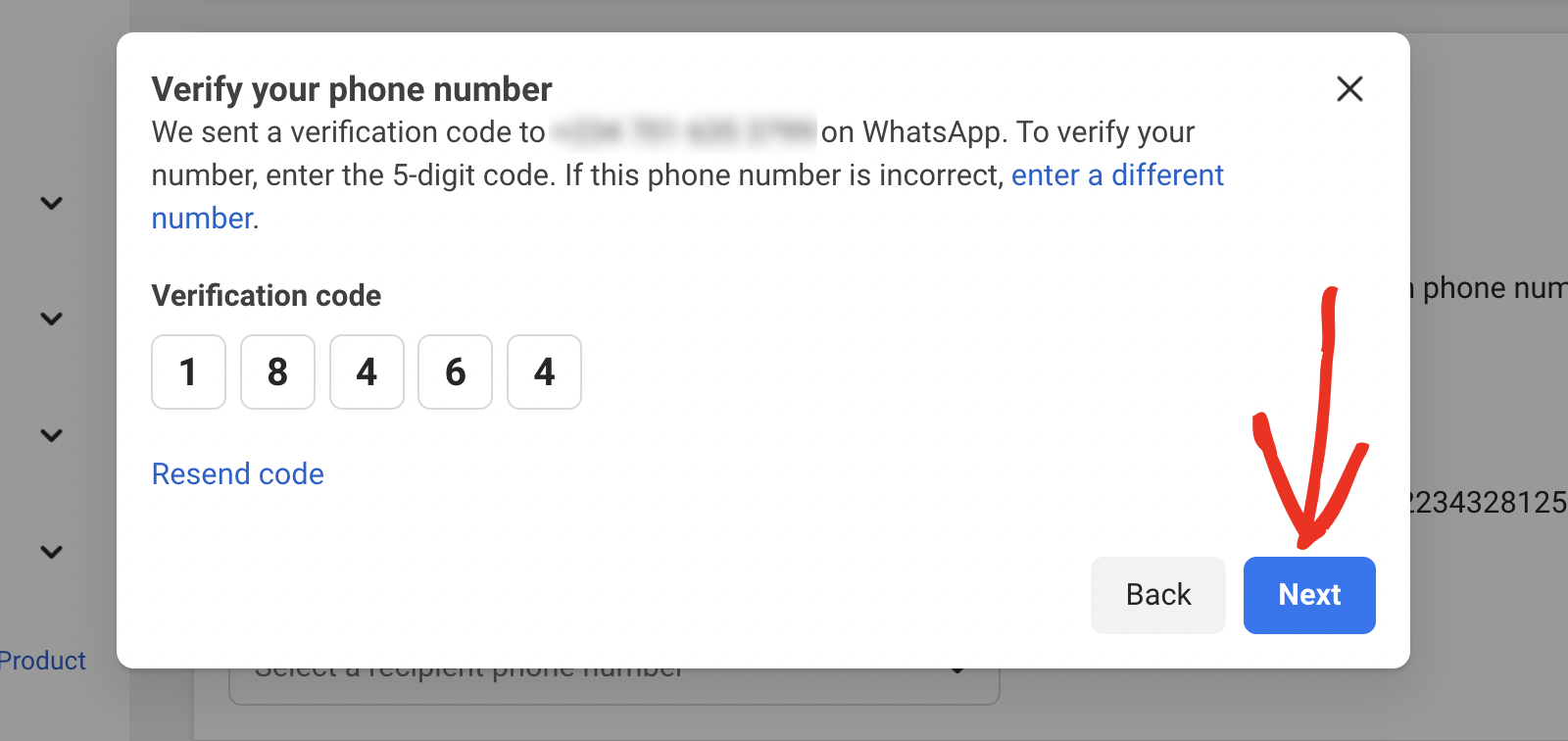
Generating an Access Token
You can quickly generate an access token to test your integration by navigating to WhatsApp » API Setup and clicking the Generate access token button.
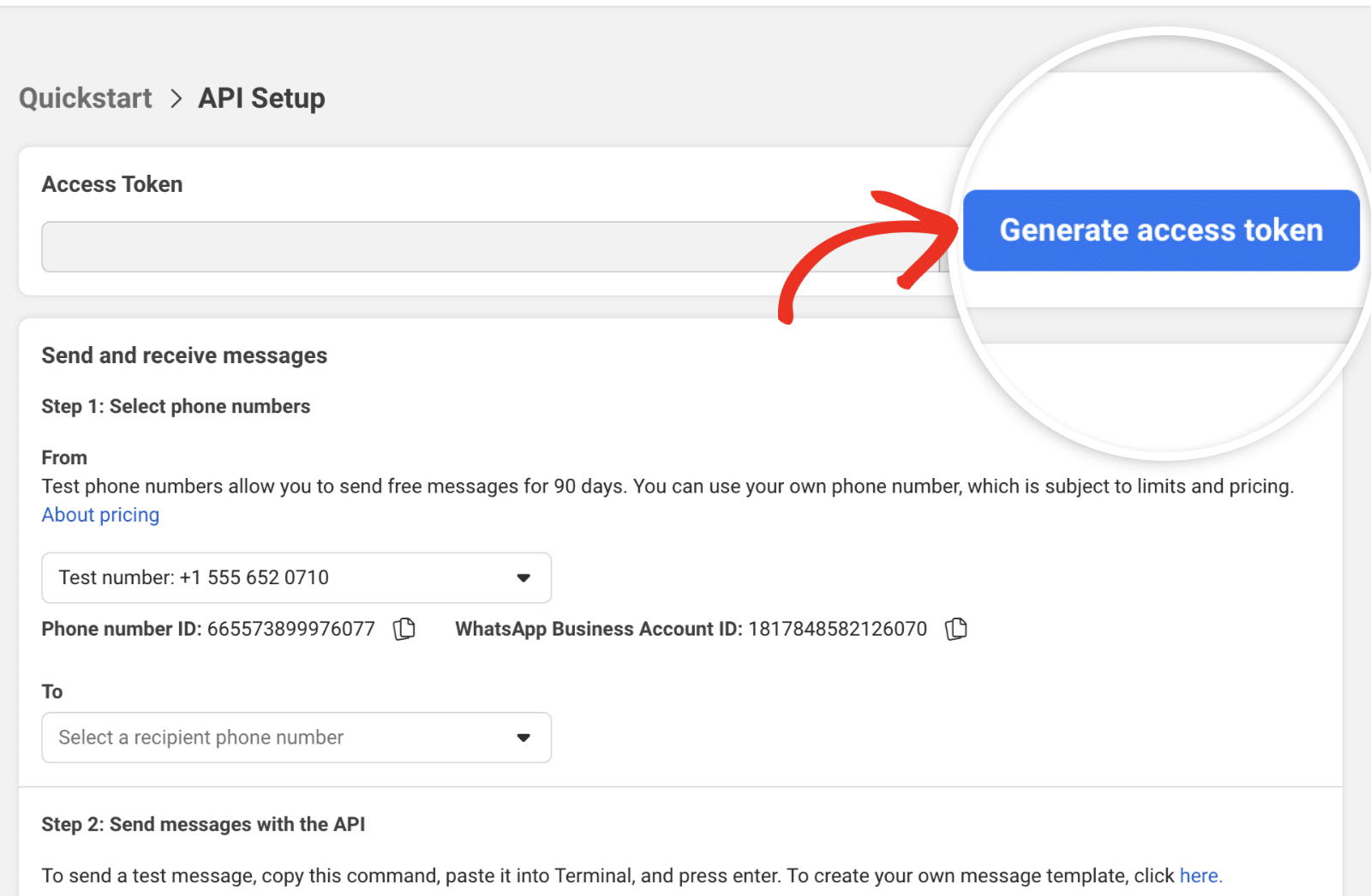
In the overlay that appears, go ahead and log in to your Meta account. Then select the WhatsApp Business profile you’d like to associate the access token with. Be sure to restrict it to only the work with the current Meta app you’re creating.
Once the token is generated, click the Copy button next to the generated access token to copy its value.
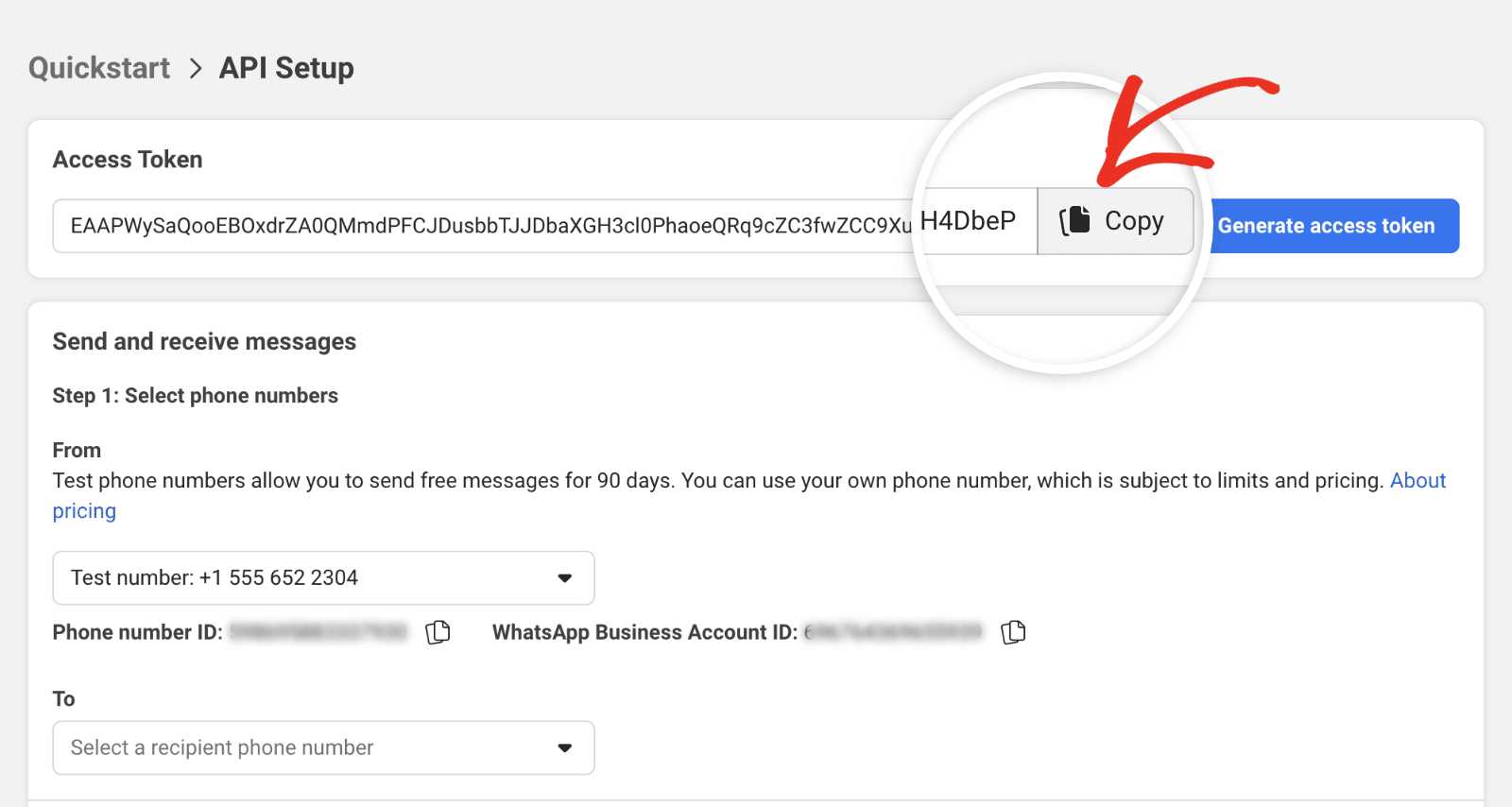
However, this token is temporary and is valid for 24 hours. Which can lead to your messages not delivering because the token might be inactive.
To ensure your WhatsApp alerts messages always gets delivered, you’ll need to generate a permanent access token. Here’s how to do it.
Go to Meta Business Manager and make sure the business portfolio you used for the WhatsApp API connection is selected. Then navigate to the Settings » Users » System users page.

Once here, click the Add button to proceed.
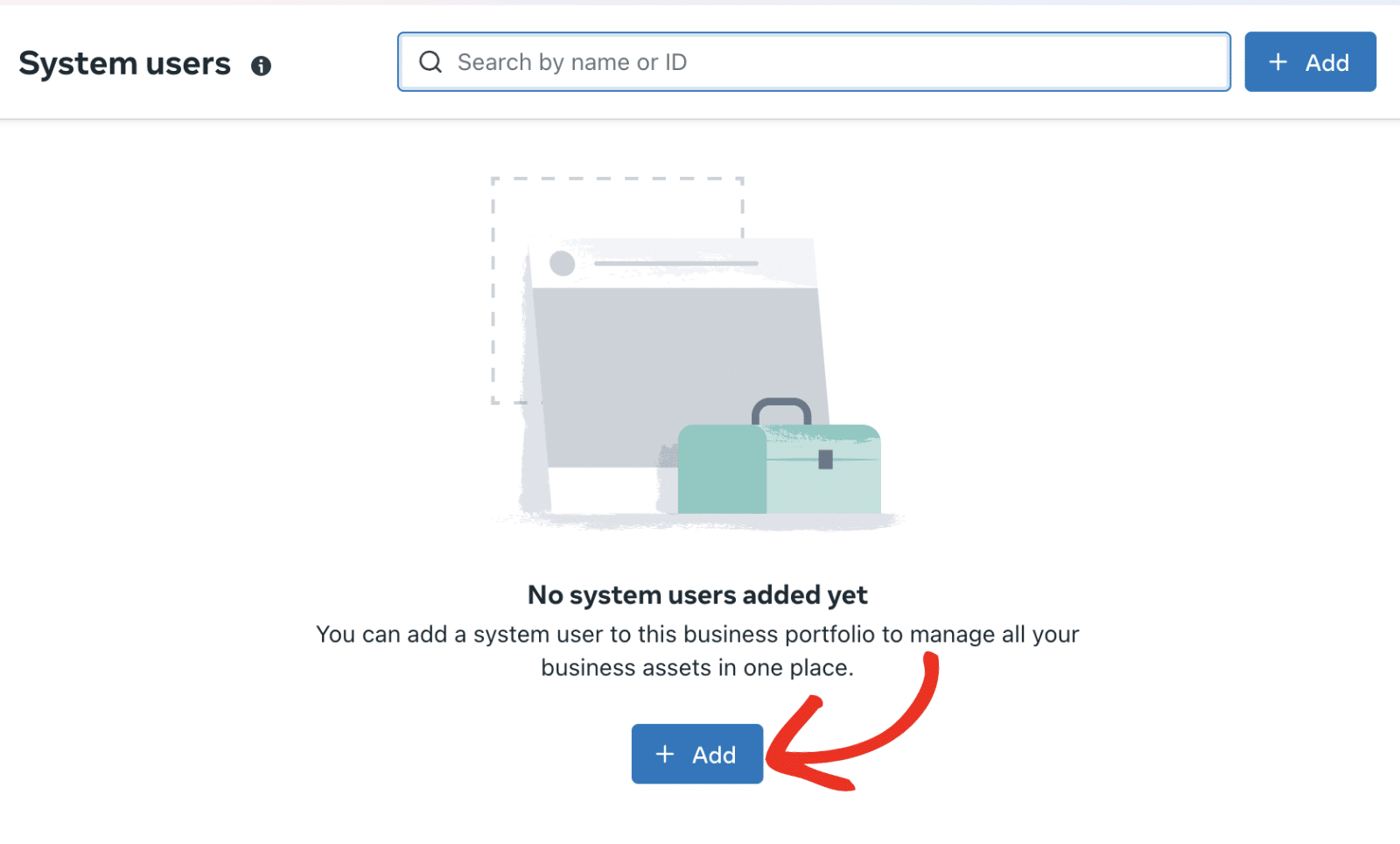
In the overlay that appears, enter a name in the System user name field. This name should ideally be in lower case, separated with a hyphen. For example, ‘whatsapp-alerts’.
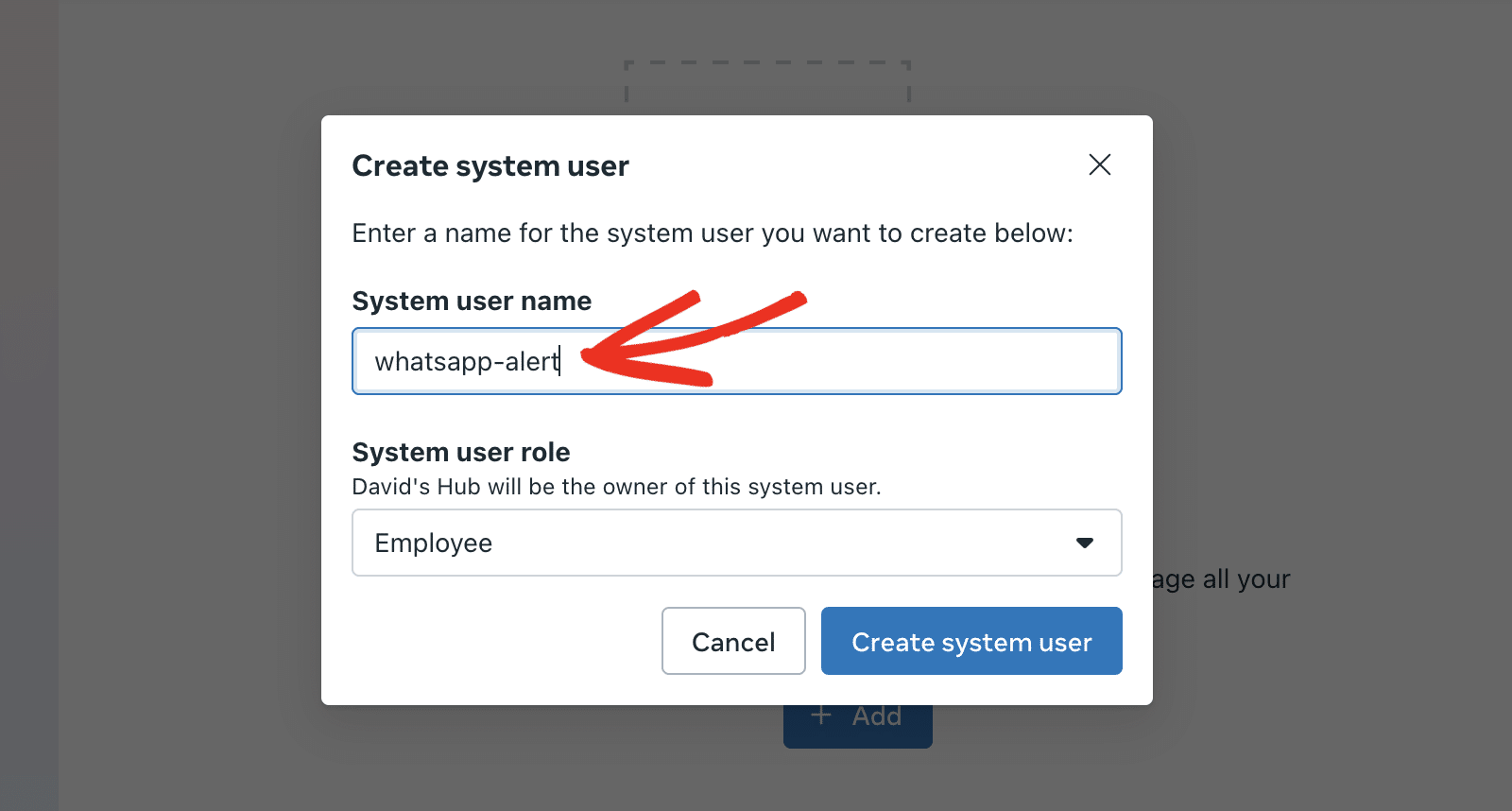
Next, set the System user role to Admin.
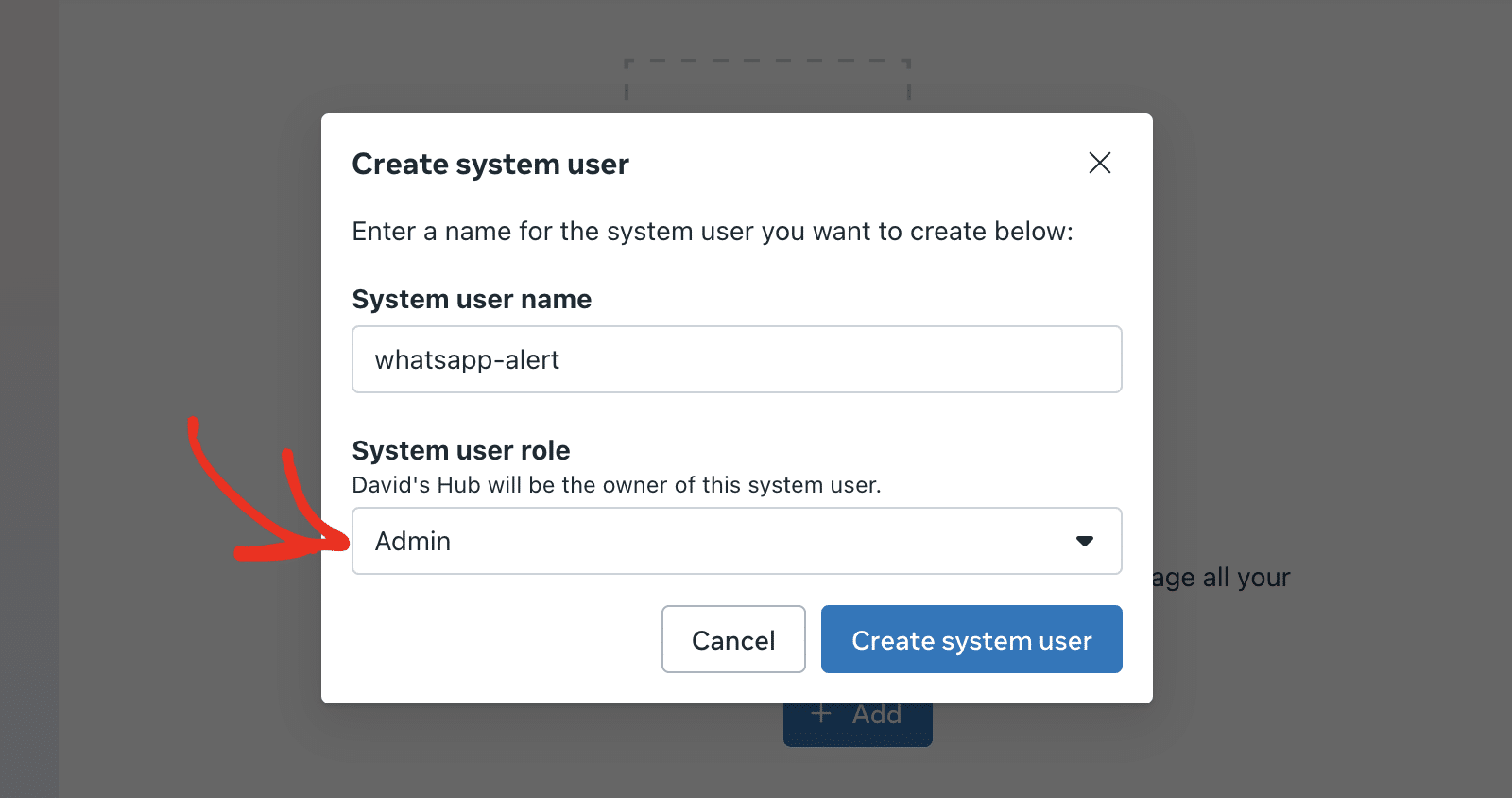
Finally, click the Create system user button to continue.
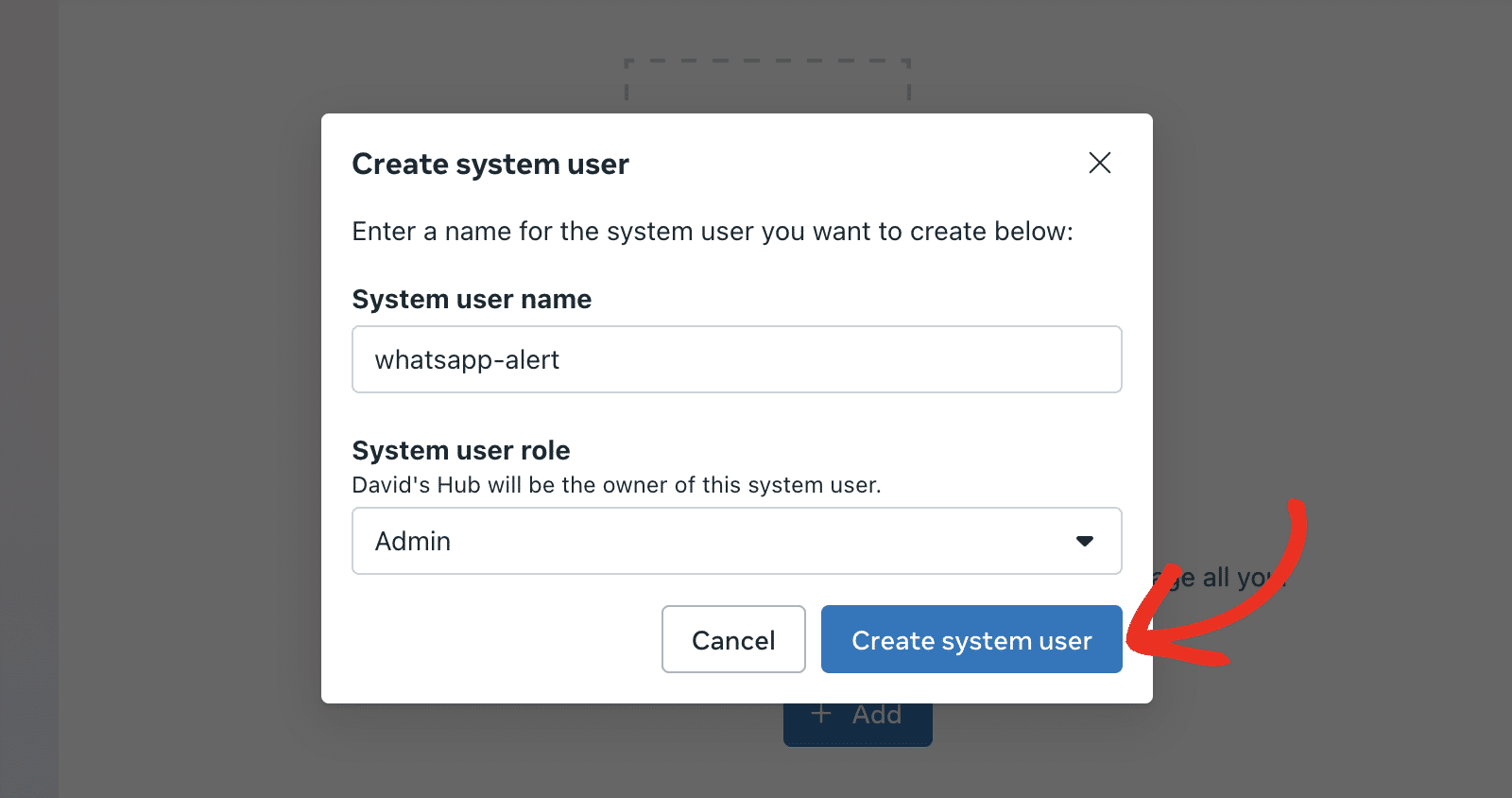
After creating the system user, you’ll need to assign the user access to your Meta app. To do that, click the 3-dot icon and select Assign assets.
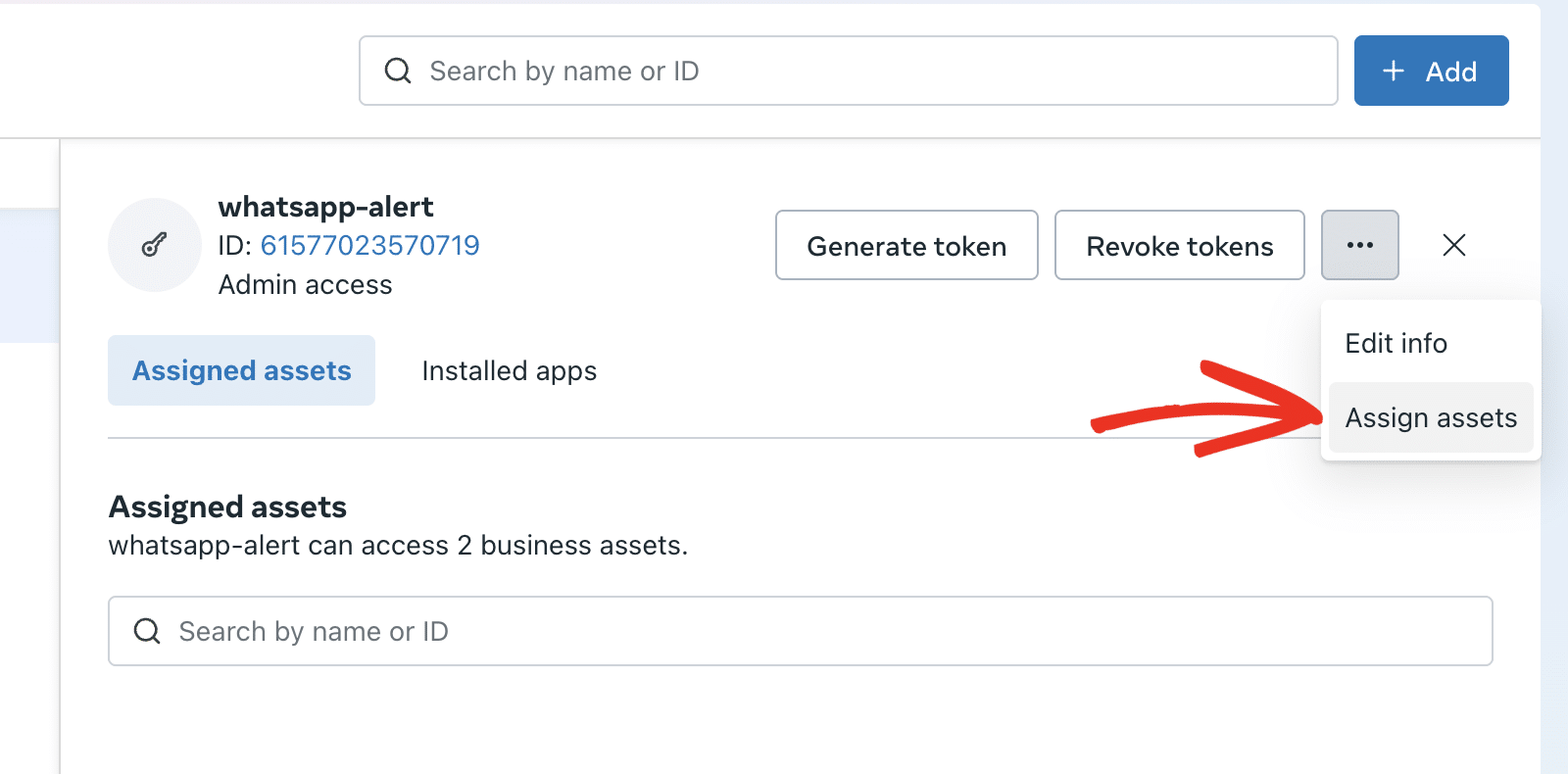
In the overlay that appears, check the box next to your Meta app.
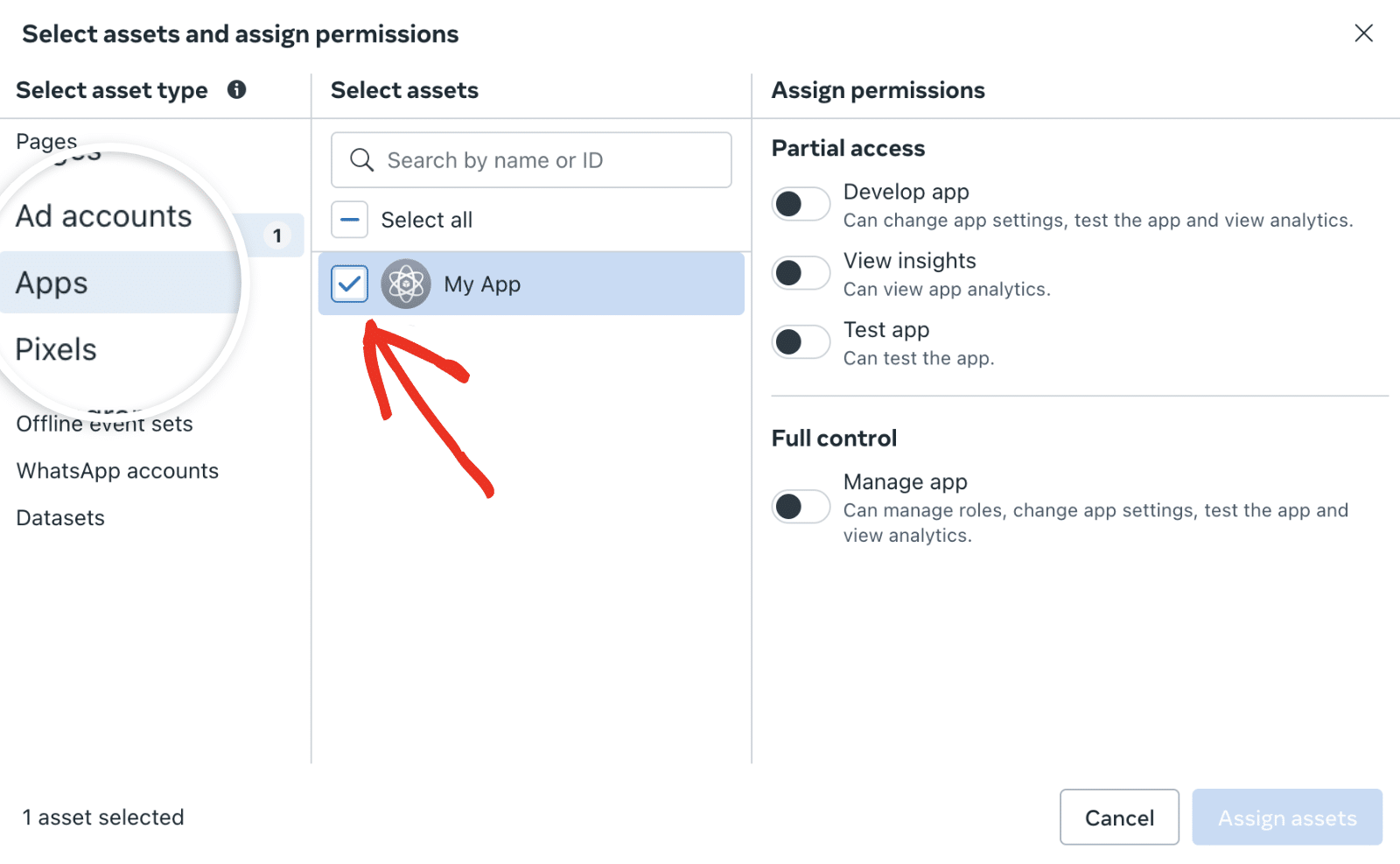
Then toggle on the Manage app option under Full control.
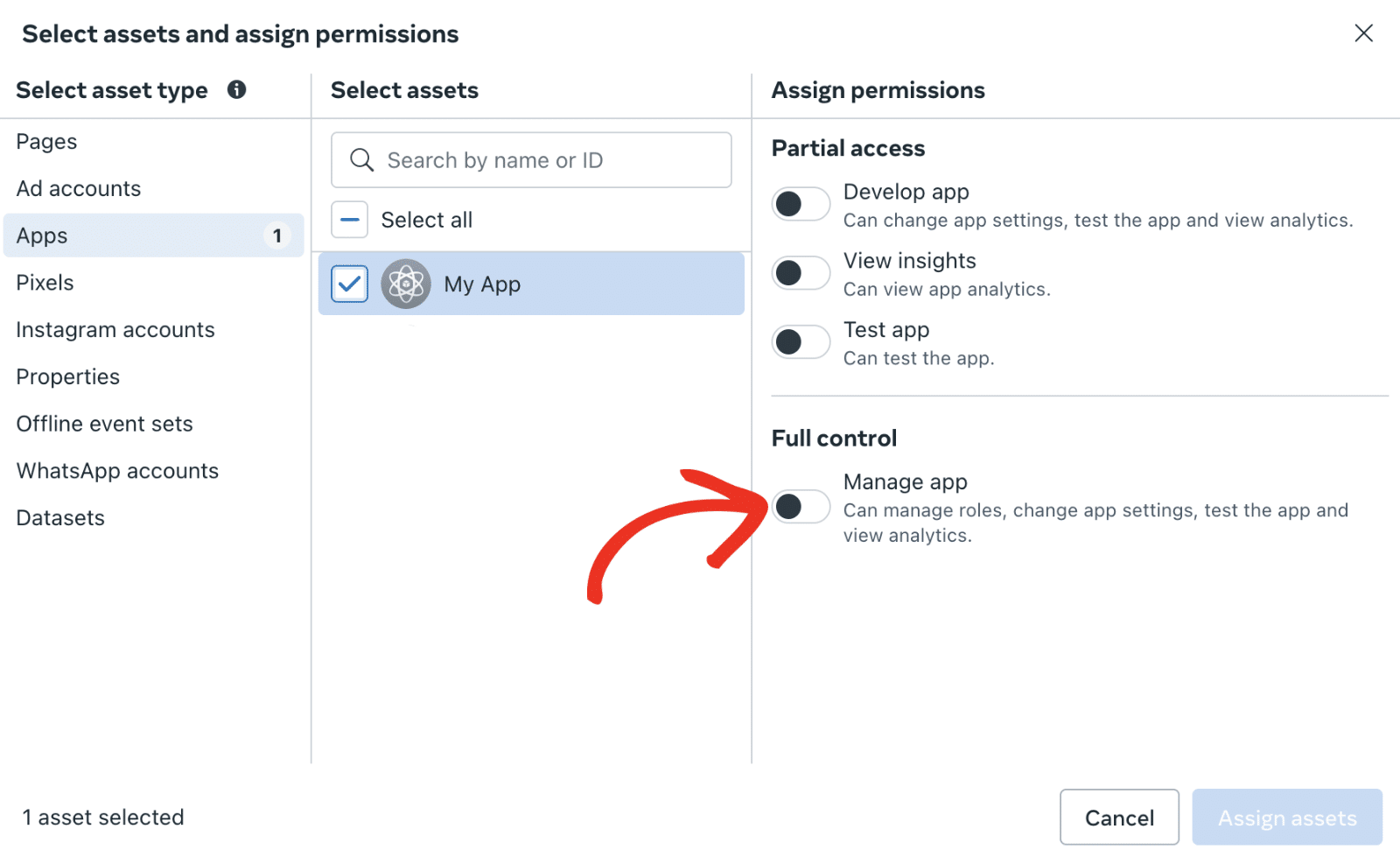
After that, click the Assign assets button to proceed.
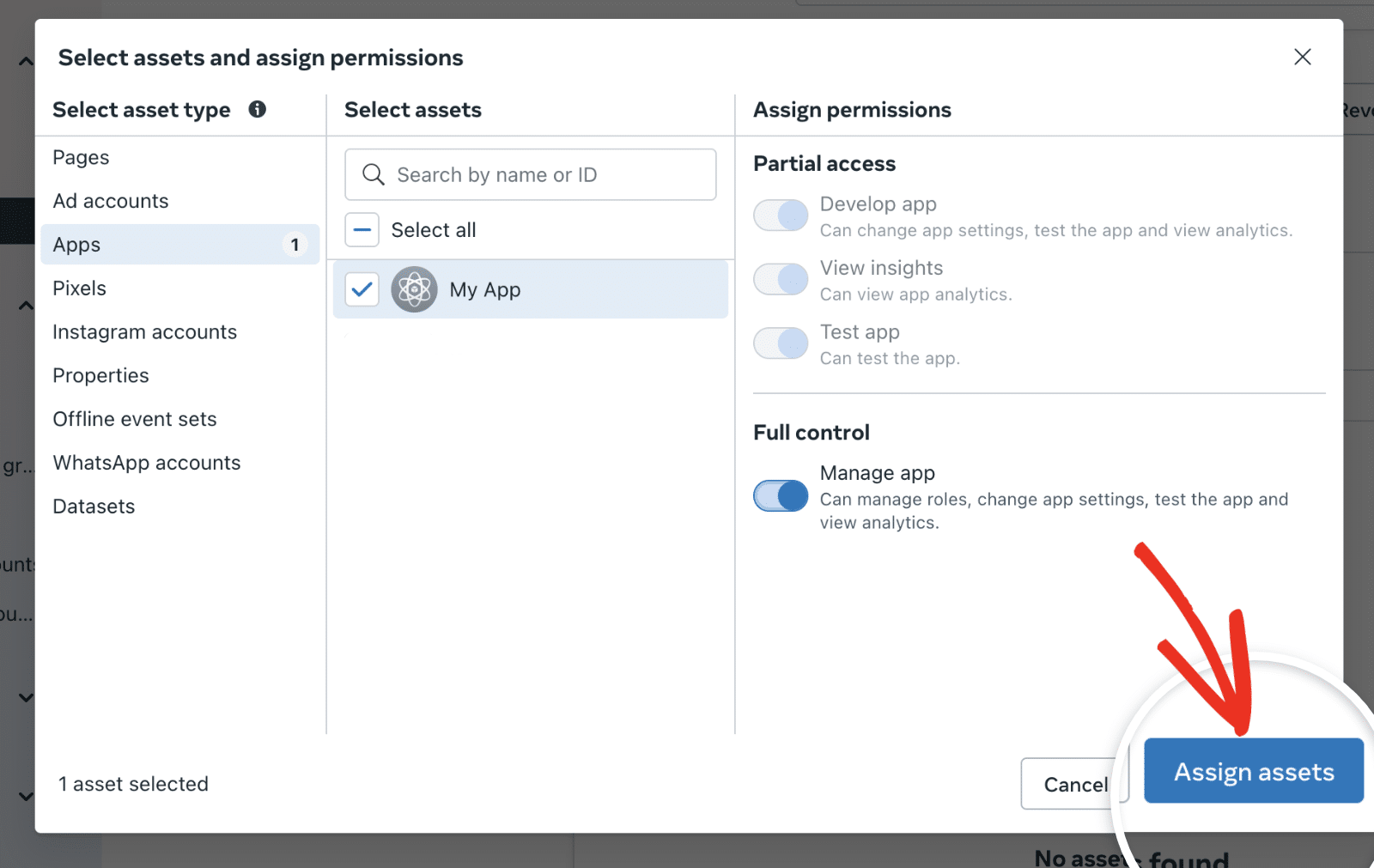
Once you’re done assigning the user role, click the Generate token button to create an access token.
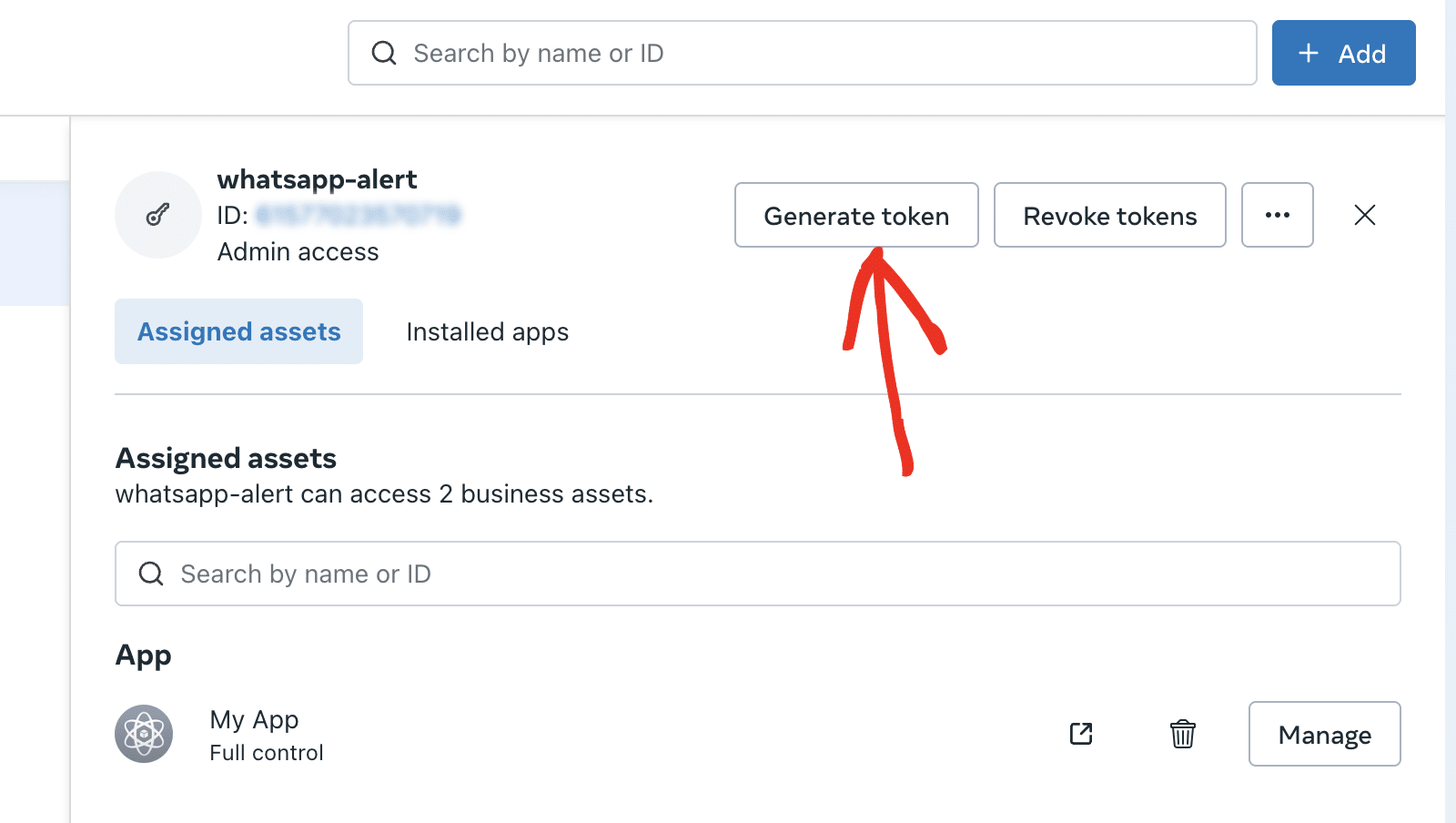
In the overlay that appears, click the Select app dropdown and choose your Meta app. Then click Next to proceed.
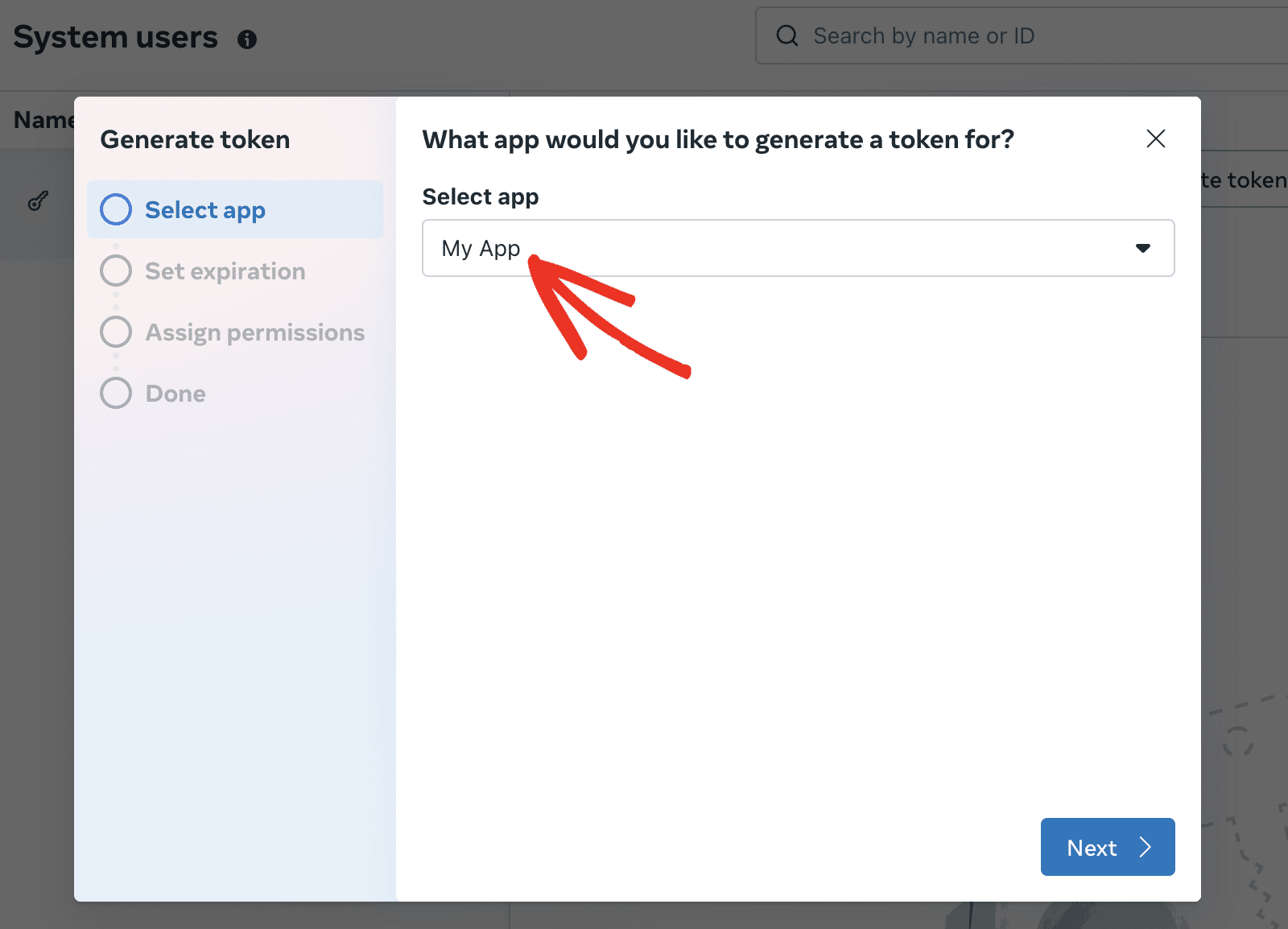
After that, choose Never in the Token expiration section and click Next to continue.
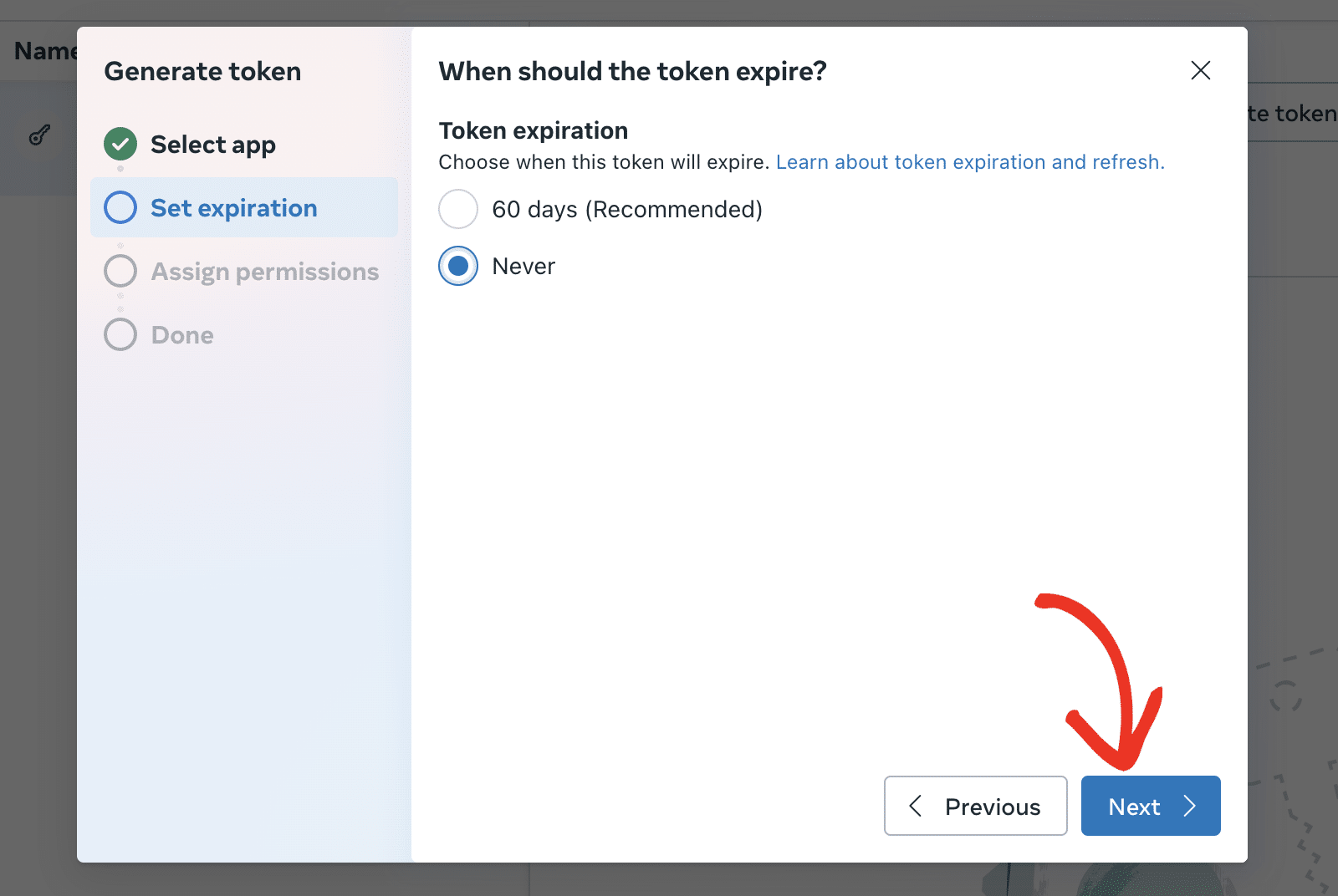
In the Assign permissions section, type ‘whatsapp’ in the search bar and enable the whatsapp_business_messaging and whatsapp_business_management options.
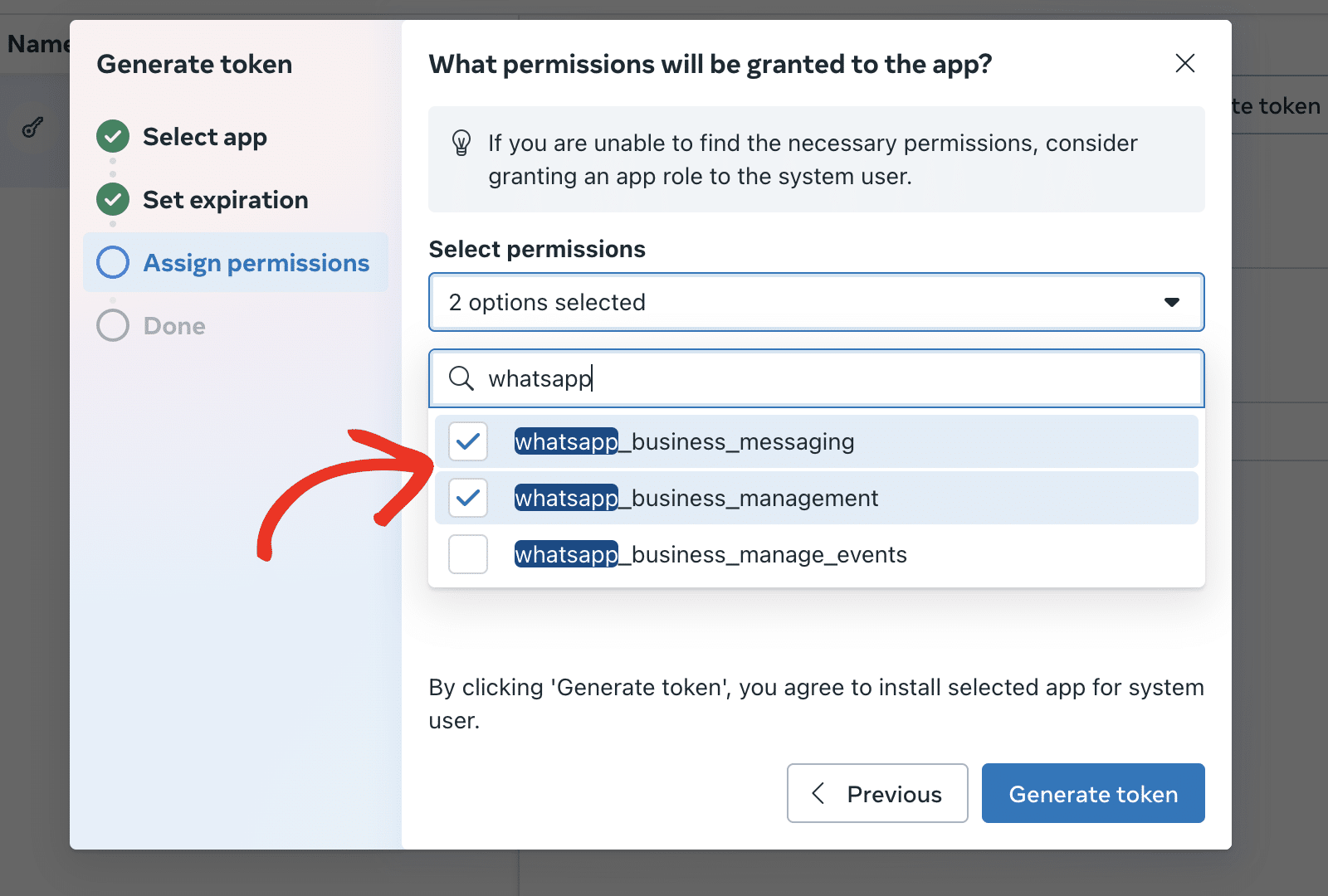
Finally, click the Generate token button to create your access token.
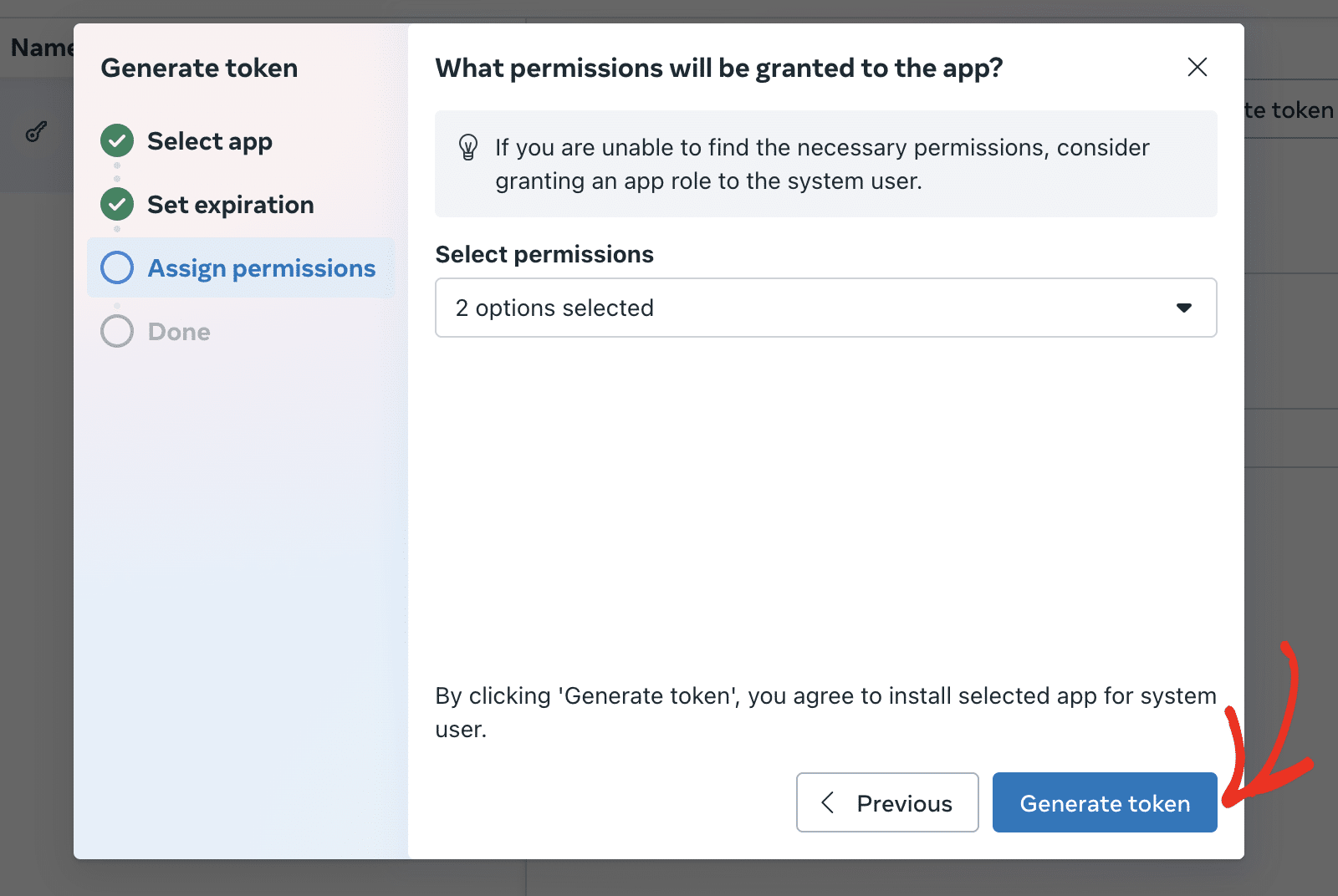
Click the Copy icon to copy the token.
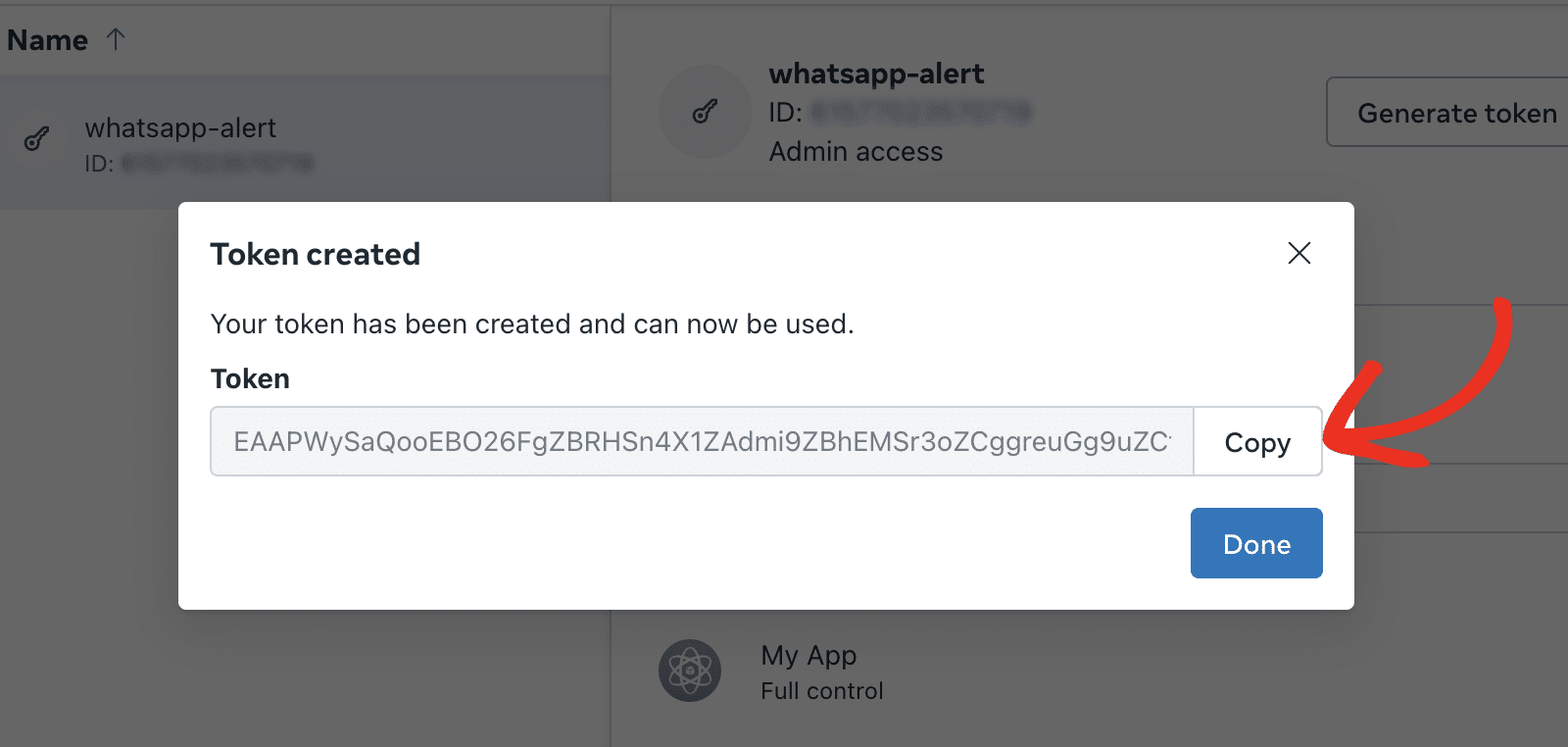
After that, return to your WP Mail SMTP settings page and paste the value you just copied into the Access Token field.

Once you’ve finished setting up your WhatsApp Alerts integrations, don’t forget to save your settings.
After saving your settings, WP Mail SMTP will automatically generate a template for your site. At first, you might see Pending next to the WhatsApp Message Template Status section. Indicating your template is under review from the Meta team.

You can click the Recheck Status link to reconfirm the template status.

If the template is approved, you’ll see an Approved status next to it.

You can add multiple WhatsApp Alerts integrations on your site. To do so, click the Add Another Connection button.

After that, you’ll need to go through the process to set up a new Meta app and generate an access token for your app.
Note: Each WhatsApp integration you create needs to have its own WhatsApp Business API credentials. So you’ll need to create a separate Meta app for each connection you’d like to add.
Once everything is setup correctly, you should receive a WhatsApp message whenever your site fails to send an email.
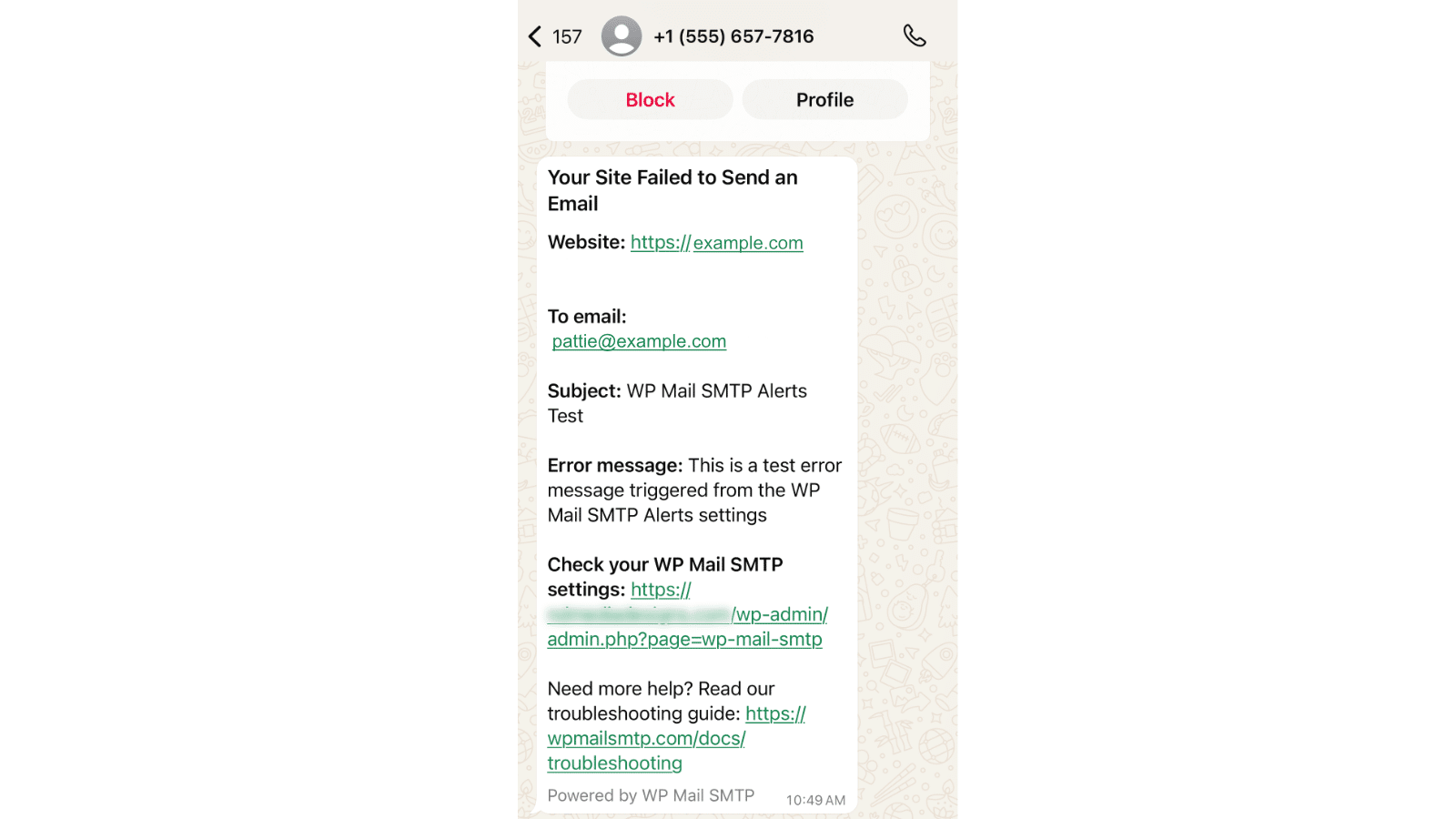
Saving Your Settings
Once you’ve added the services you’d like to use, you’ll need to save your changes to complete the setup.

To do this, click the Save Settings button at the bottom left of the interface.
Testing Email Alerts
After saving your settings, you can test the services you configured to ensure they work correctly. To do so, click the Test Alerts button next to Save Settings.

You should see a success notification after clicking on this button.

The alert test will trigger all the services you configured. So, if you set up email alerts, for example, you’ll receive an email with the test results in the email address(es) you added.
Frequently Asked Questions
Below, we’ve listed some of the most common questions we receive about email alerts.
Why am I unable to receive Twilio SMS alerts?
If you’re not receiving Twilio alerts, first ensure that your Twilio phone number is active. To do this, go to Phone Numbers » Manage » Active Numbers in your Twilio console.
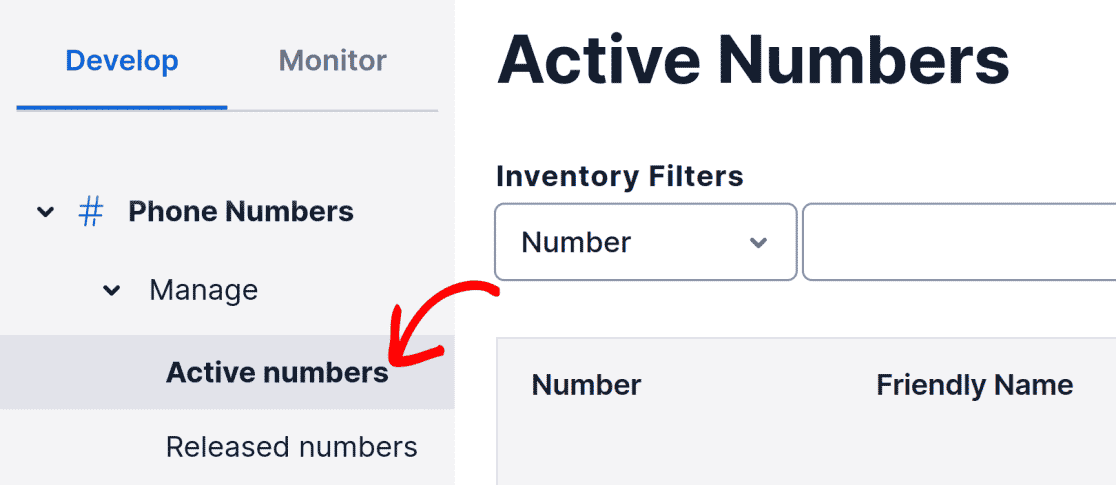
You should see at least one number listed in the Active Numbers list.
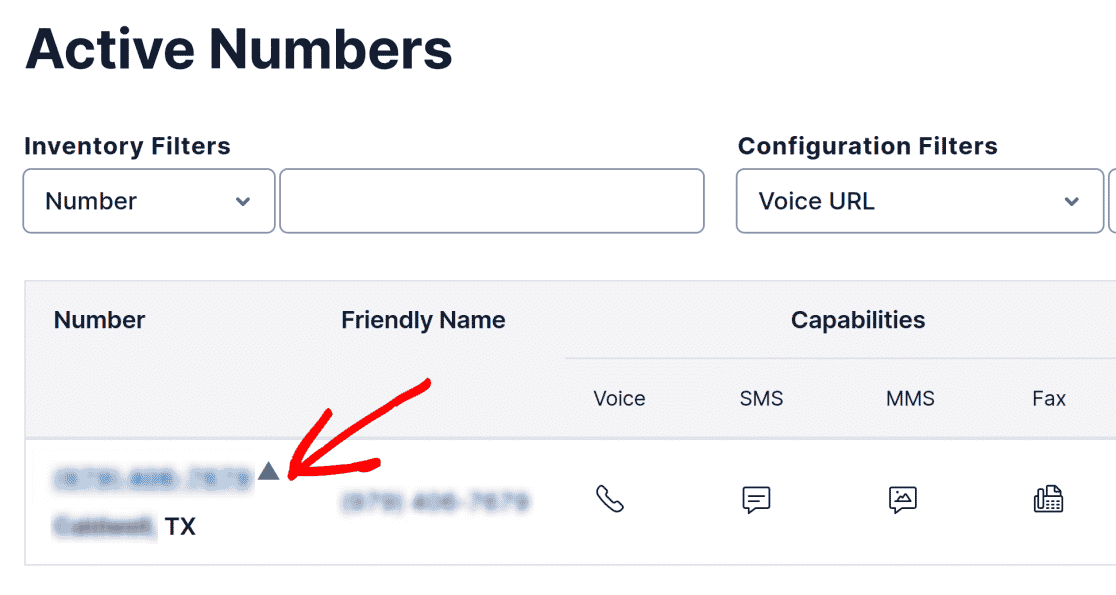
If your number is active but you are still not receiving alerts, you may be unable to send messages to your region due to your geolocation permissions settings. You’ll need to adjust your geolocation permissions in order to resolve this issue.
From the Twilio console, go to Messaging » Settings » Geo permissions to view your geolocation settings.
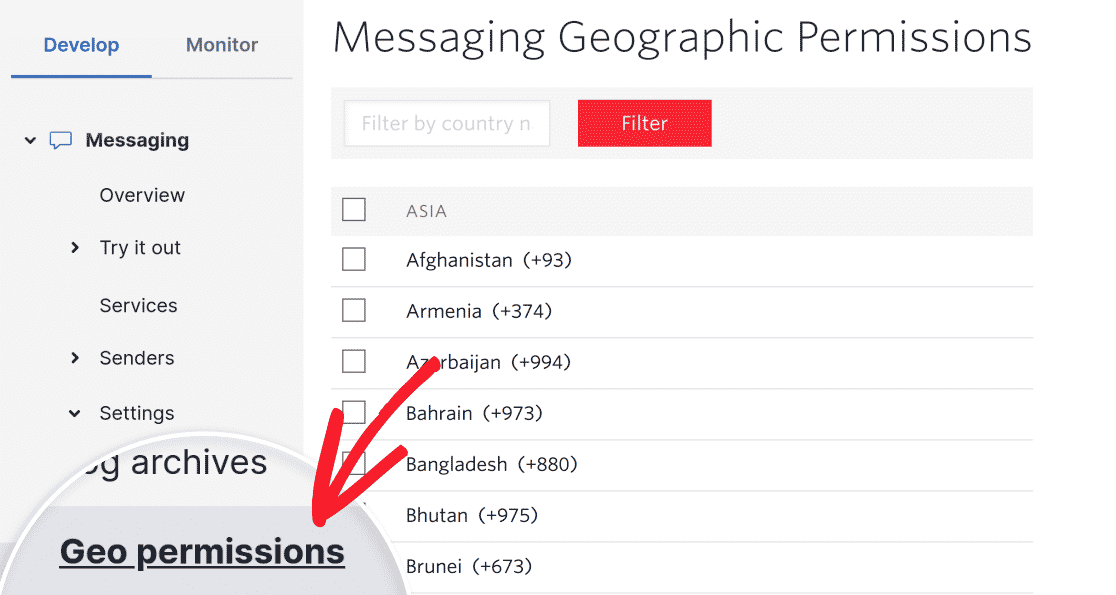
Next, find your country or region and ensure that it has been enabled.
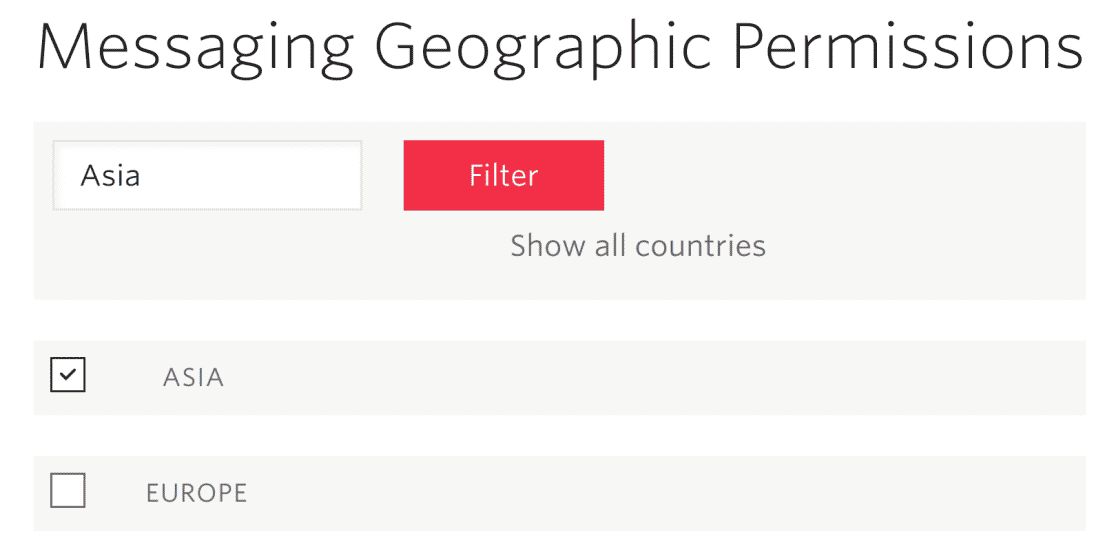
Note: If you are using a Twilio trial account, you will only be able to send alerts to the numbers that you have verified. Please see Twilio’s documentation on verified numbers for more information.
I mistakenly selected ‘Block’ instead of ‘Allow’ when enabling push notifications. How do I reset my selection?
To reset your site’s notification settings, you’ll need to first remove it from the disallowed list. We’ll use Google Chrome as an example. But the steps are similar for most modern browsers.
In Chrome, open your browser settings, then select the Privacy and security tab. Next, click on the Site settings option.
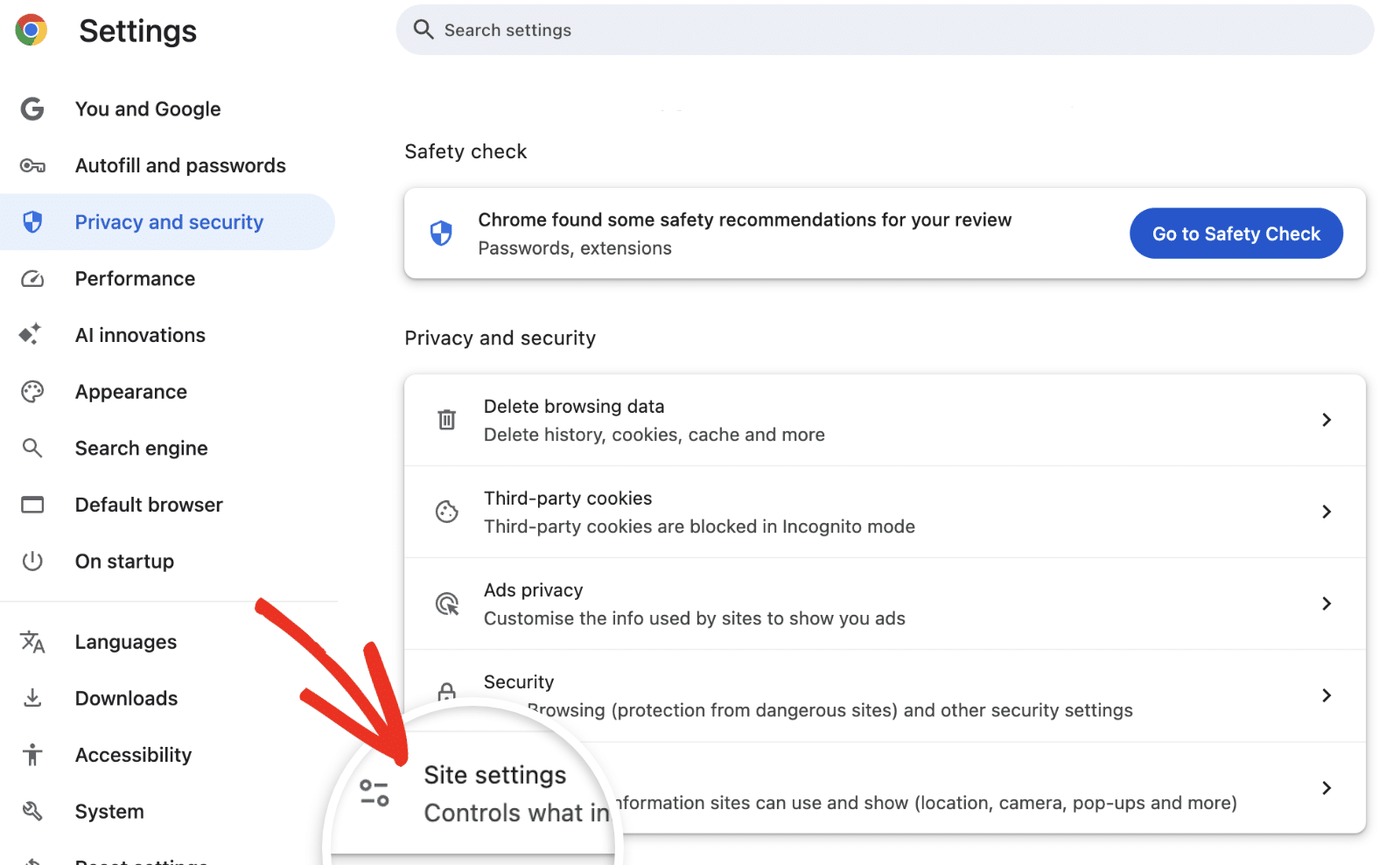
Under Permissions, select the Notifications option.
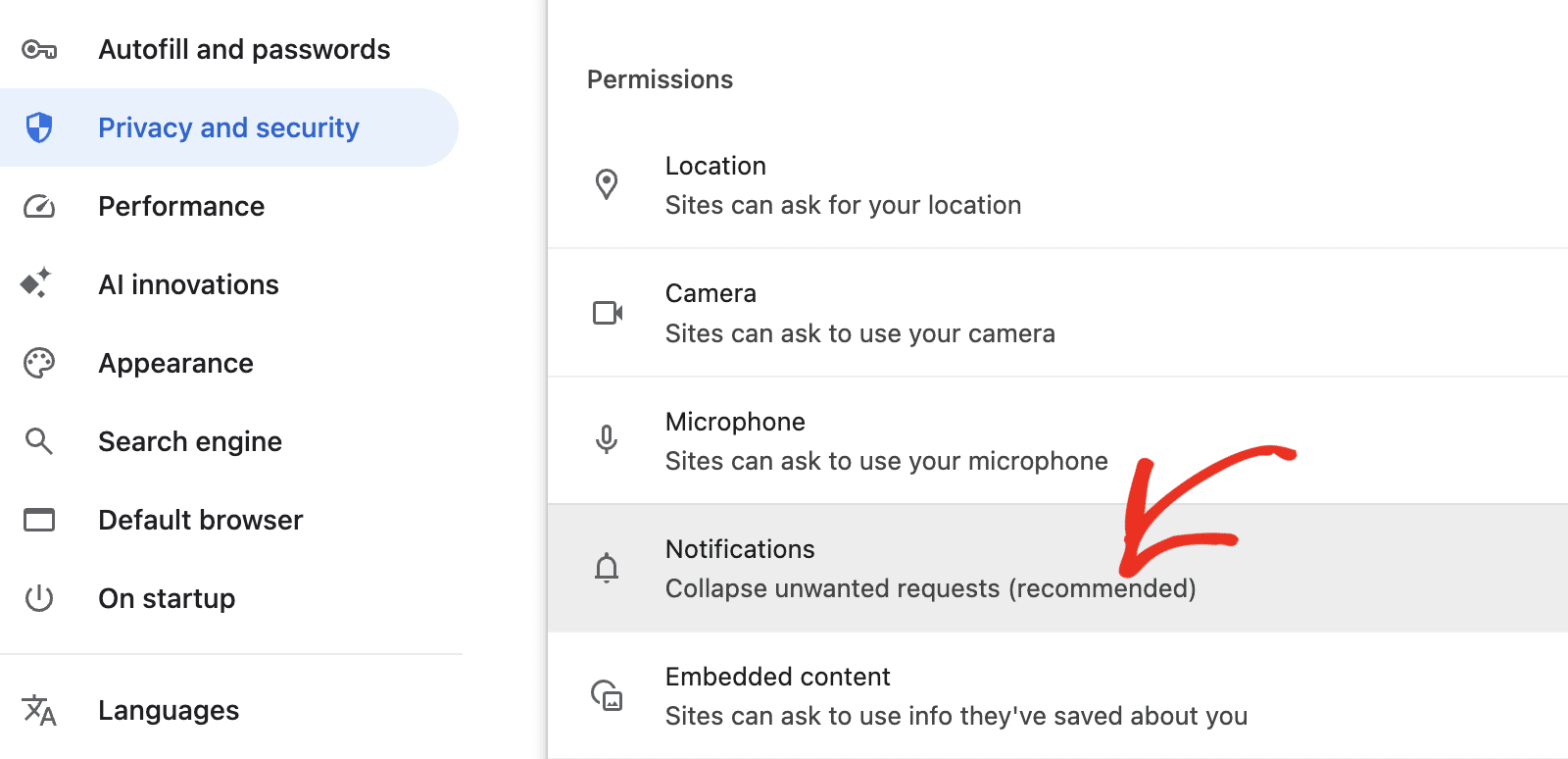
Then scroll down to the Not allowed to send notifications section and remove your site from the list.

Note: You can follow the same procedure to remove your site from the disallowed list on Firefox.
For Safari users, open your browser settings screen, then navigate to Websites » Notifications.
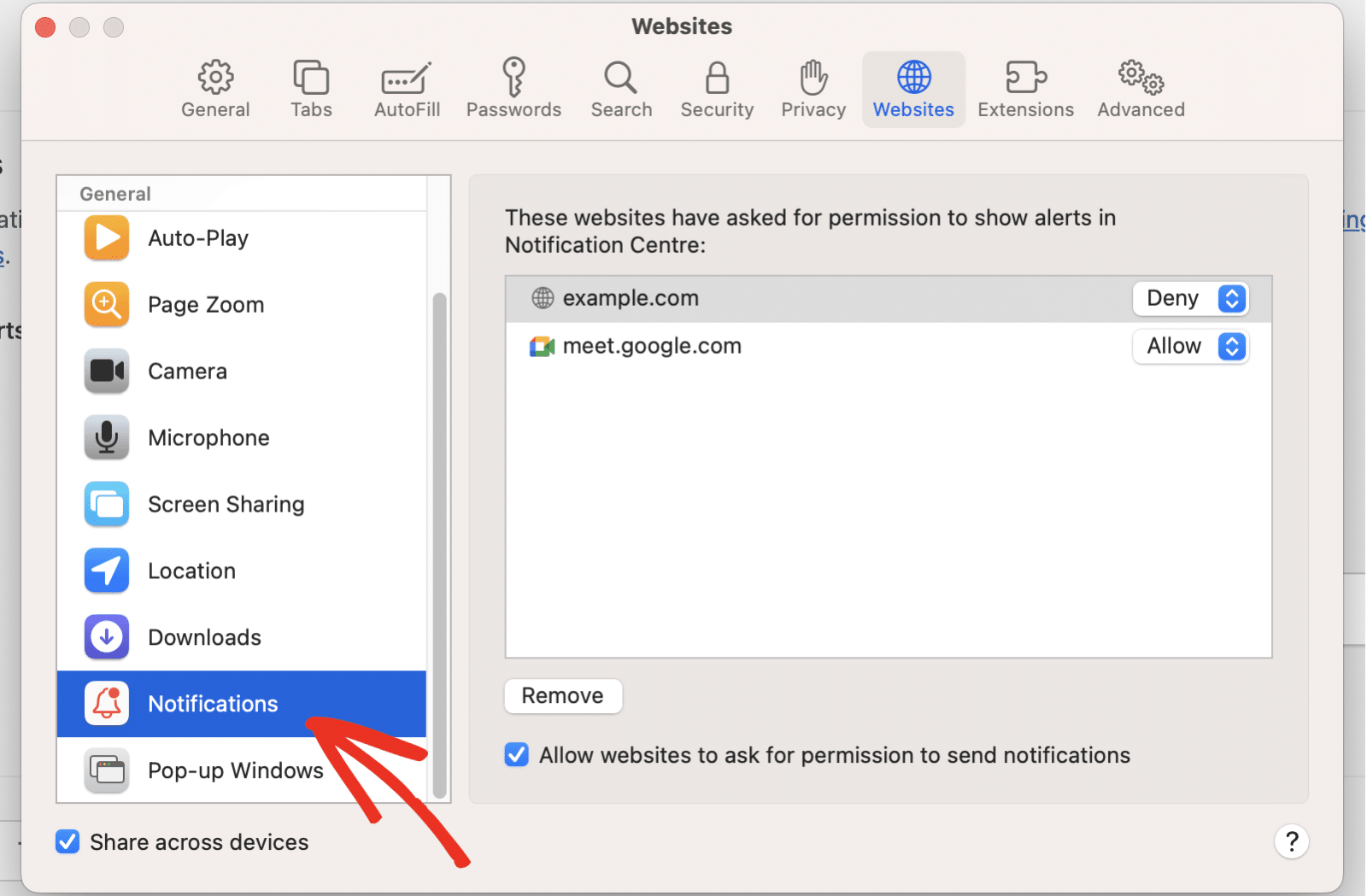
Next, select your website and click Remove.
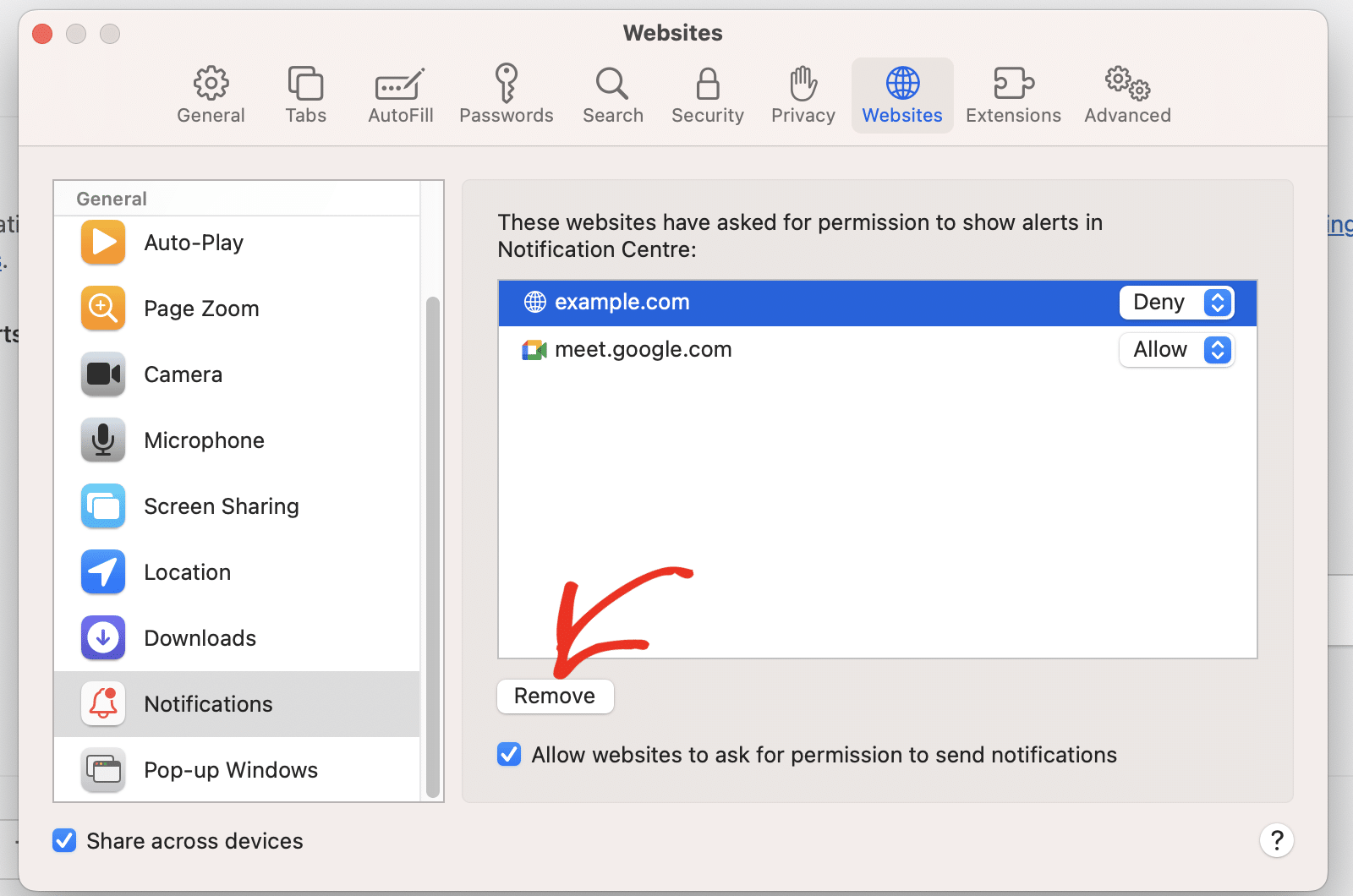
After removing your site, return to your WP Mail SMTP settings page and follow the procedure listed above to enable push notifications on your site. Make sure to select Allow when the browser popup appears.
I enabled push notifications on my site. Why are push alerts not coming through?
This can occur due to a variety of reasons, including operating system settings and browser-related causes. We’ve written a complete troubleshooting guide that addresses some of the common causes of the issue of push notifications not sending.
Why are my WhatsApp alert messages not delivering?
This can occur due to a variety of reasons. To troubleshoot and resolve this issue, first verify that your access token is valid and hasn’t expired. Using the temporary access token generated from the WhatsApp Business API configuration page can also lead to messages not delivering. We recommend creating a system user and generating an access token for the user.
Also check that the number you added in the To Phone Number field in WP Mail SMTP is formatted properly with the correct country code. Make sure to also add it as a recipient to the WhatsApp Business API.
How do I fix WhatsApp template not approved issue?
After connecting WP Mail SMTP to WhatsApp, our plugin automatically generates an alert template on your business manager profile. You can access this template from the Meta Business Manager dashboard. You’ll see the wp_mail_smtp_alert template. An Active status means your template is working properly.
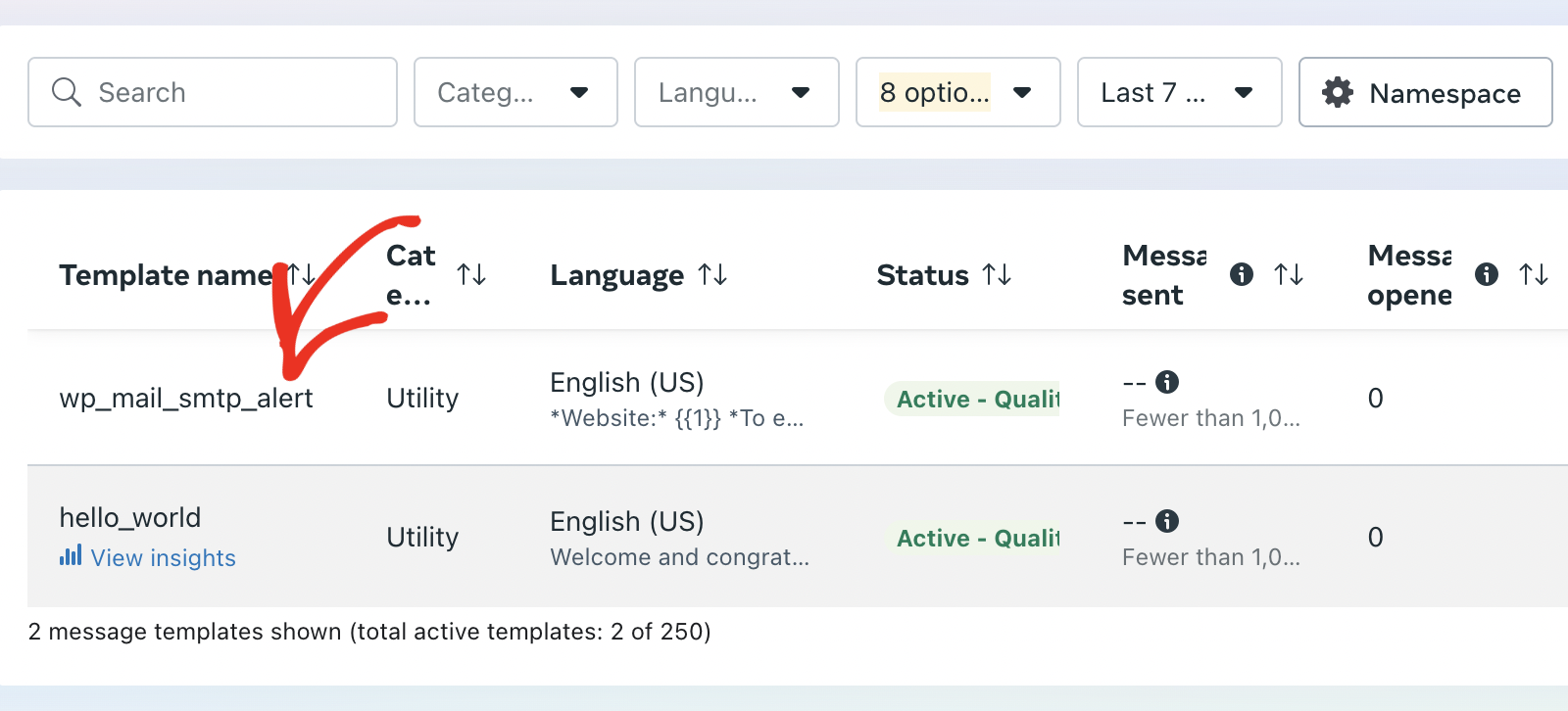
If the status is showing PENDING, you’ll need to wait a little for Meta to approve the template. If the status is REJECTED, it means Meta automatically disapproved the template. When this happens, we recommend resubmitting the template for approval or contacting Meta’s support team for manual review.
That’s it! Now you know how to set up Alerts on your site with WP Mail SMTP.
Next, would you like to easily track how emails are performing on your site? Learn more in our complete guide to email reports in WP Mail SMTP.
